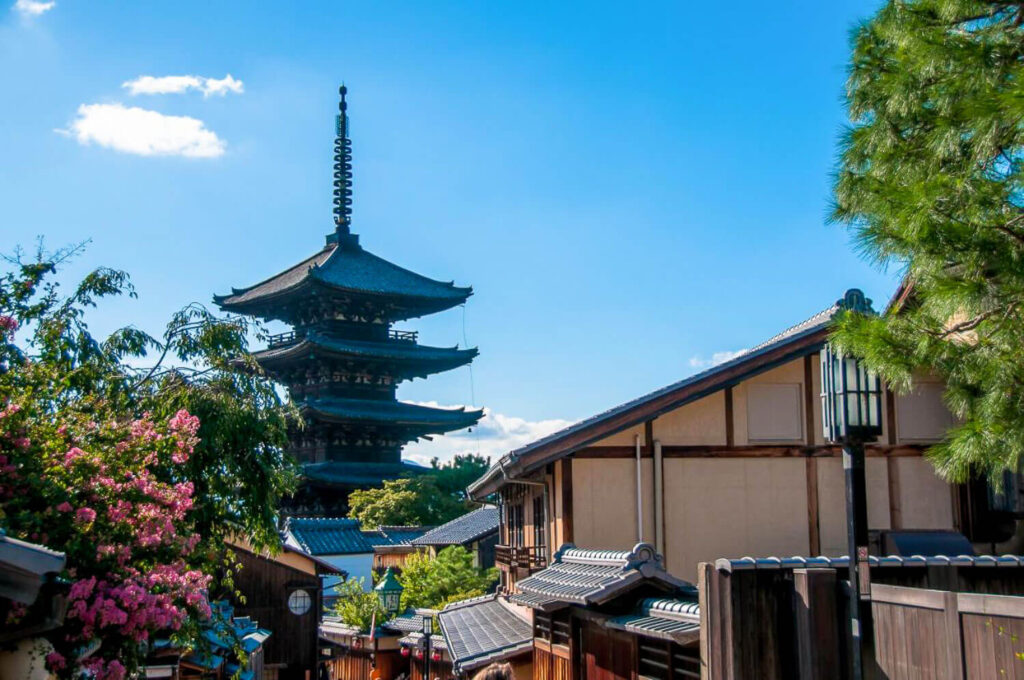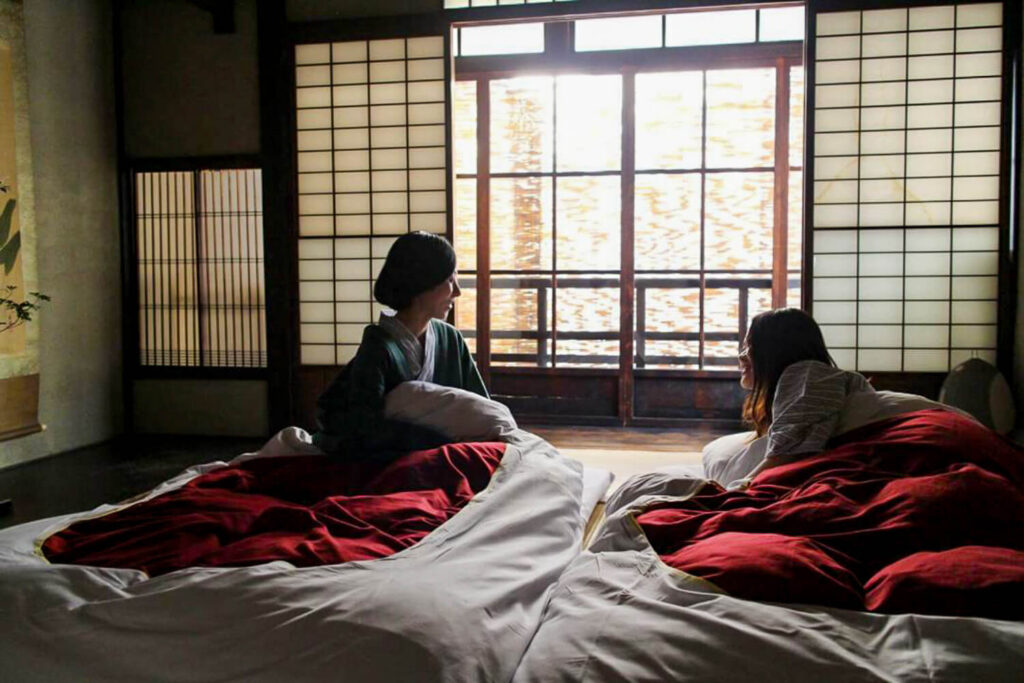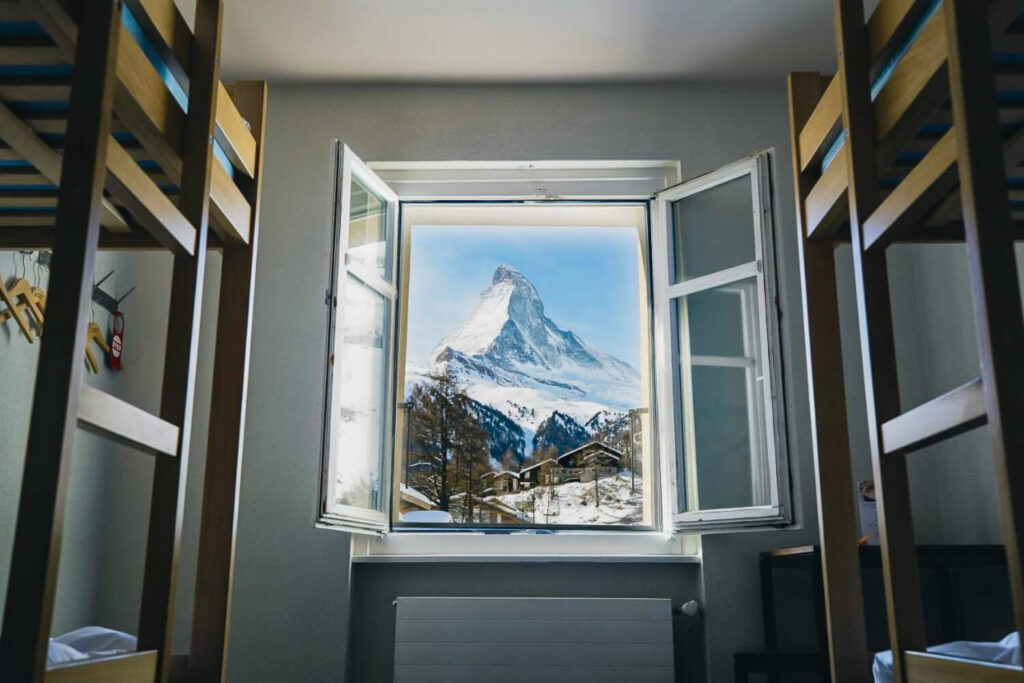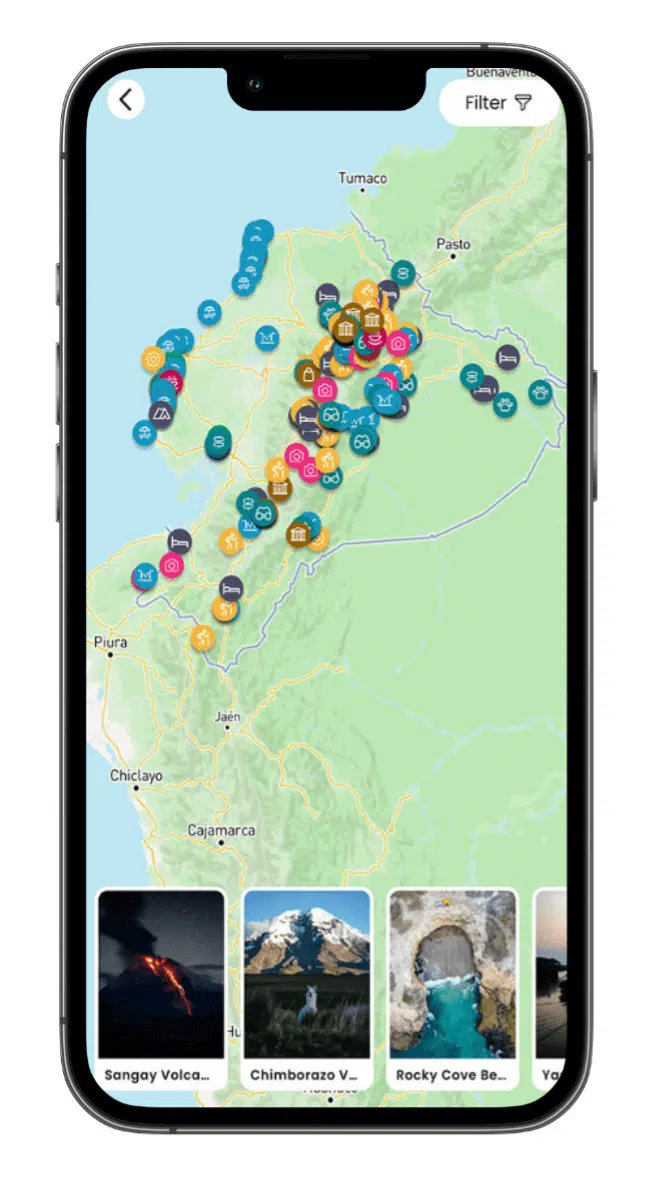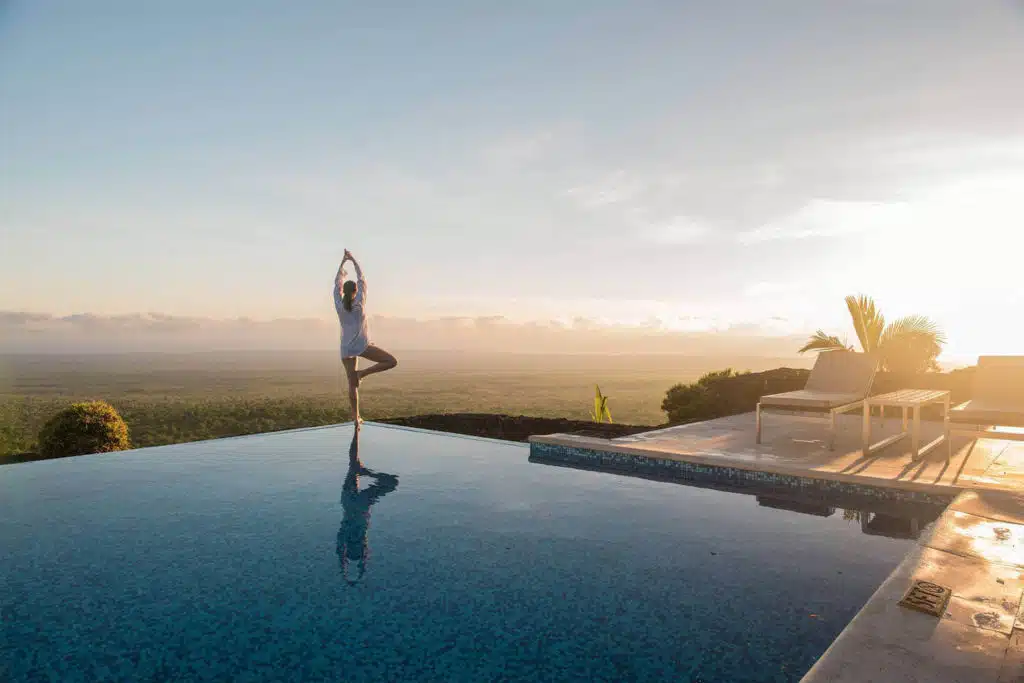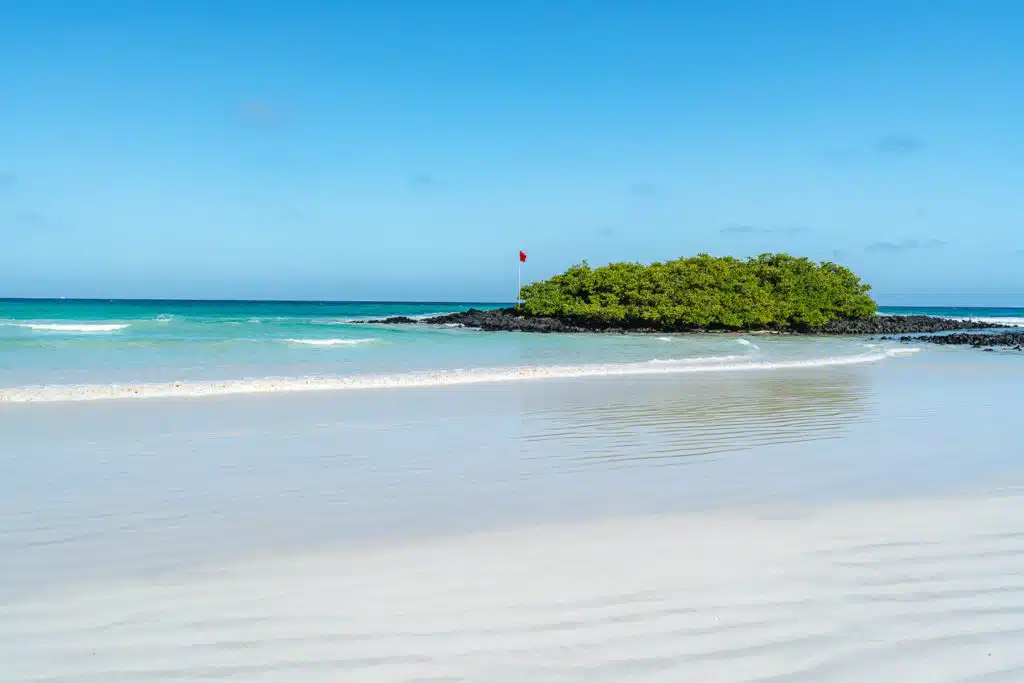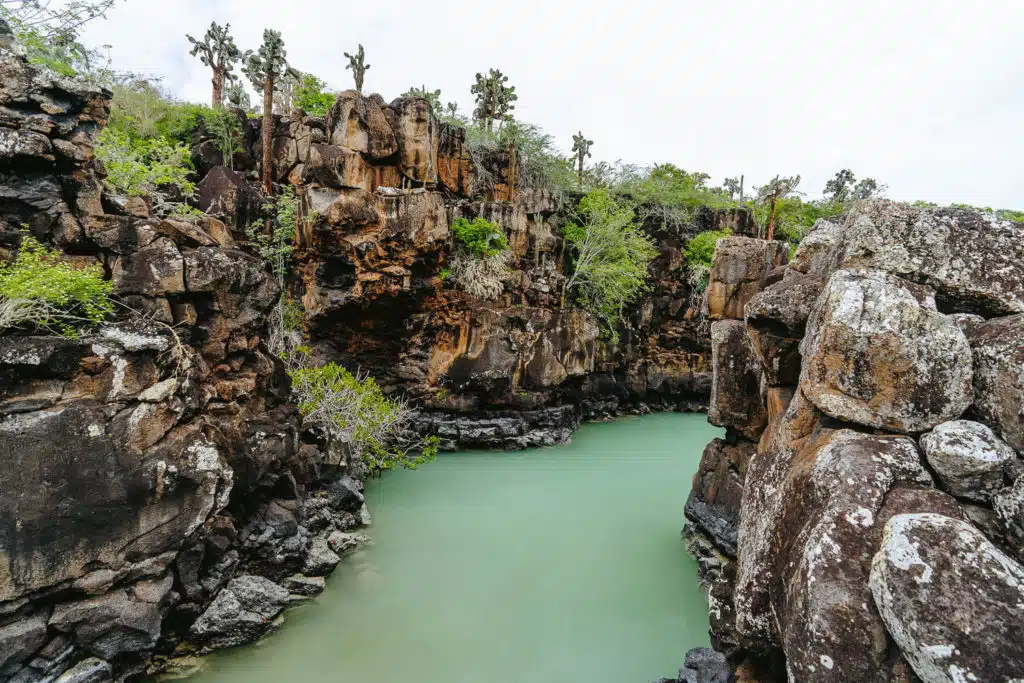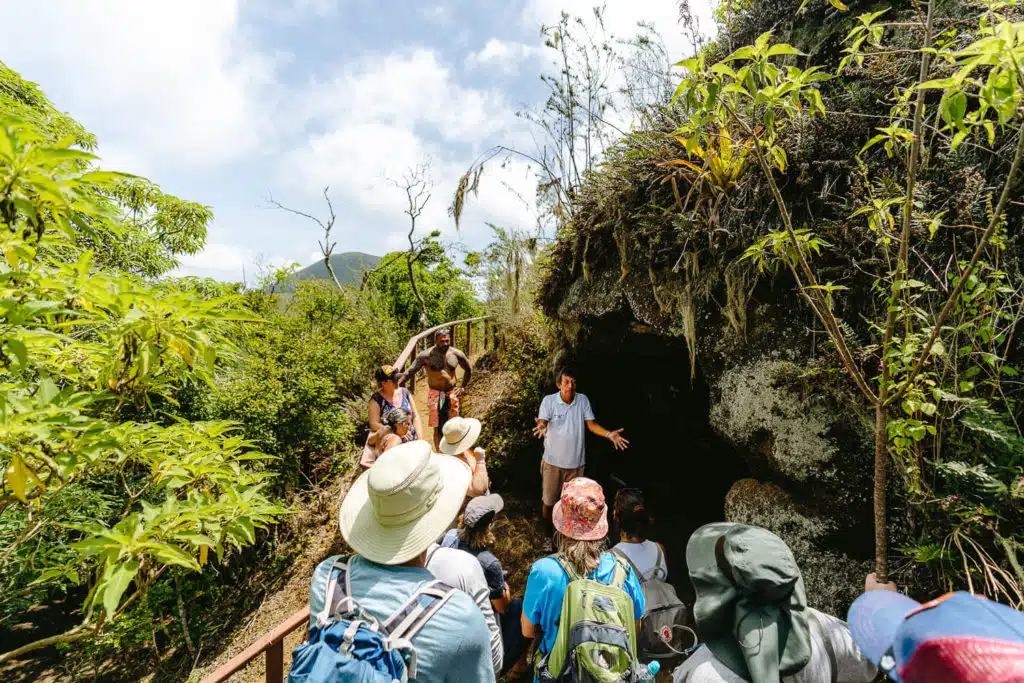35 Amazing Things To Do in Santa Cruz, Galapagos
All The Activities (2025)
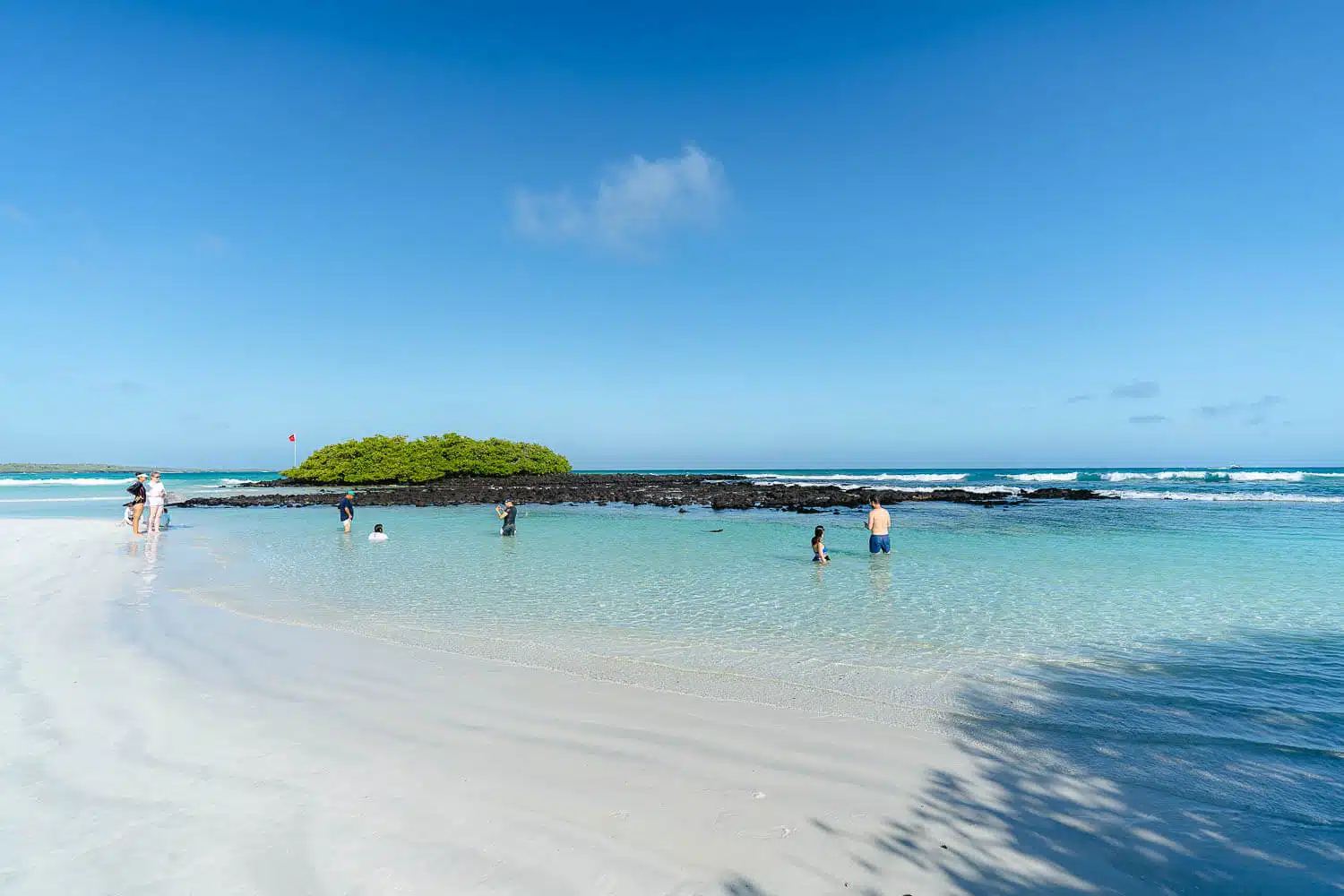
Santa Cruz Island in the Galapagos is the main island of the archipelago.
It is the island with the best infrastructure and tourist vibe of all the three main ones and like all of them it has adventures for all tastes. Here you can see all the most famous endemic animals of the Galapagos, explore the island on land and on water, learn about its history and conservation projects, and explore many of the other islands nearby.
Here I’ll list 35 awesome things to do in Santa Cruz, Galapagos. Most of the adventures I’ve done them myself and I’ve written detailed articles about them, which I will link together.
If you’re looking for more ideas, I’d recommend checking out my 80 Best Things to Do in the Galapagos. And if you’re still planning your trip, my Best Galapagos Itinerary (4 to 10 Days) might help.
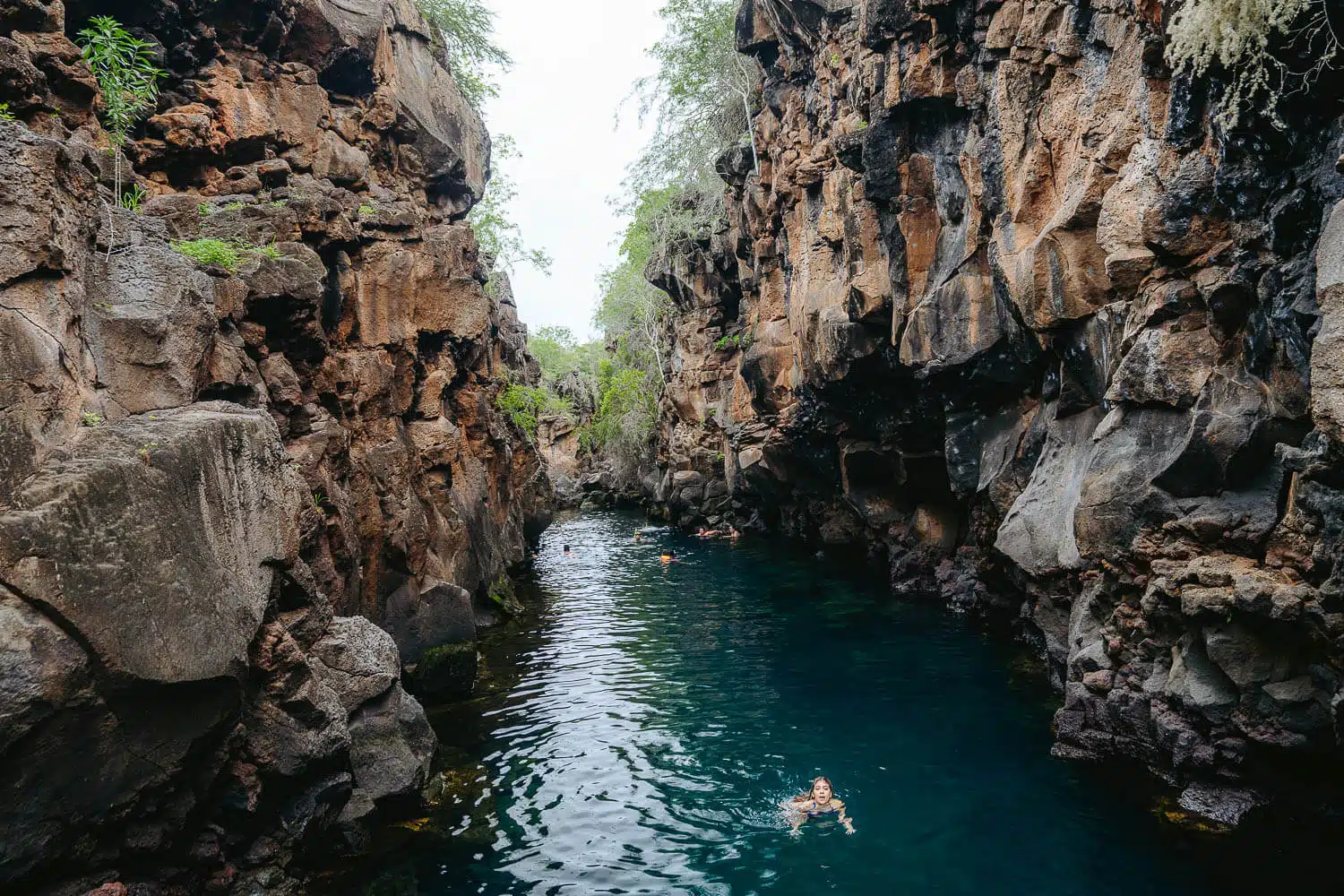
Travel Guide, Itineraries, Map, Local Tips
Get access to my curated list of all the best viewpoints, hiking trails, secret waterfalls, diving spots, wildlife tours, accommodations, and more, that will make your trip to Ecuador and The Galapagos unforgettable.
All of this, in an interactive guide featuring a mobile-friendly map, pre-designed itineraries, all my favourite photos, and helpful travel tips to guide your journey in this amazing unexplored country.
If you want personalized advice write me in-app and we can plan it together.

Things To Do in Santa Cruz
General Info
Santa Cruz, like all the other islands, is part of the Galapagos National Park, and therefore it has a number of things you should know:
- Most of the activities have to be done on a tour with a Naturalist guide.
- All the agencies have the same prices (although you can barter if you book more than one tour).
- Most beaches have opening and closing times (turtle nesting reasons).
- You should book your tour at least one day in advance (or you might risk not having a place on the best ones).
- Bring Seasickness Medication for the tours on the water.
- Always use strong sunscreen (Sun in the Equator line burns more).
- Have mosquito repellant with you, especially at sunset. There are horseflies in the Galapagos.
- You can’t fly a drone here unless you have a special permit from the National Park.
- You can’t rent a motorcycle or a car, everything has to be done by taxi, bus, boat, bicycle, or on foot.
- You can’t and shouldn’t touch the animals on the island.
If you want some more information on things to do in Santa Cruz island or other official information please check the Galapagos Conservancy’s website about Santa Cruz Island.
Things To Do in Santa Cruz
Top Picks for Things To Do in Santa Cruz
1. Pit Craters "Los Gemelos"
Here one can see two valley-shaped pits covered with vegetation. These are amazing formations that resulted from the collapse of ancient lava tunnels. When the lava cooled down and contracted it left behind unstable structures that with time collapsed and let the vegetation take over.
In order to visit it you must hire a taxi, for that reason, it’s usually included in a tour where the taxi takes you to multiple destinations.
This tour is called “The Highlands Tour” or “Tour Parte Alta” and takes you to the Pit Craters “Los Gemelos”, the Lava Tunnels, and to the Giant Tortoise Reserve “El Chato” or “Las Primícias”.
View the full blog post here: HIGHLANDS TOUR IN SANTA CRUZ
To book this tour: Check the local company Galapagos Dreams’s website, or book it online on Viator here: The Giant Tortoise Experience | Lava Tubes + Los Gemelos
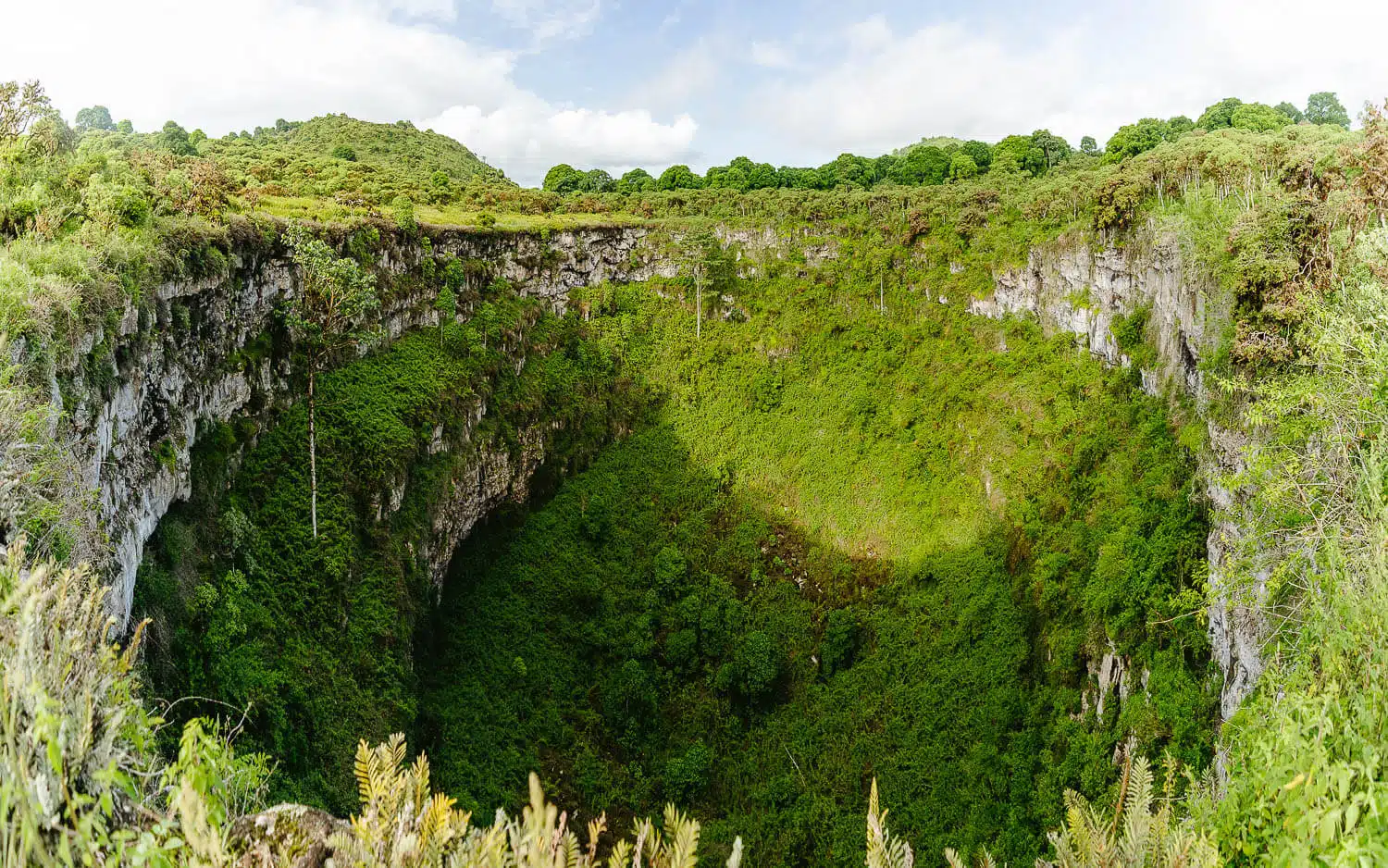
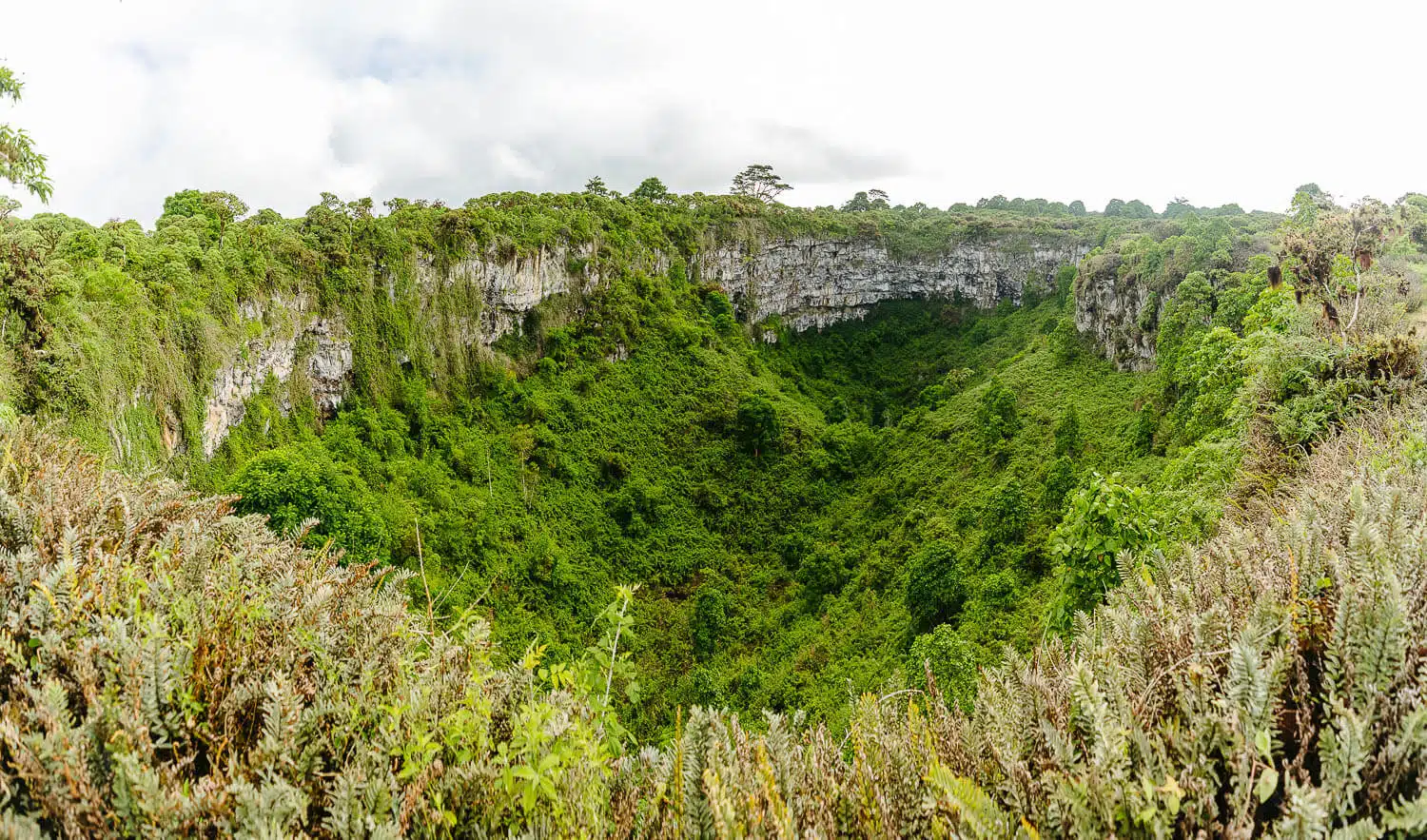
2. Lava Tunnels
In this place, you can really understand how the island was formed and see a multitude of landscapes. Identical to the pit craters, these tunnels were also formed after the lava flowing from the volcano cooled down. The part of this lava that got in contact with the oxygen, created a solid outer shell. That outer shell is the structure that today you get the chance to walk inside.
To visit it you must hire a taxi, therefore, it’s usually included in a tour where the taxi takes you to multiple destinations.
This tour is called “The Highlands Tour” or “Tour Parte Alta” and takes you to the Pit Craters “Los Gemelos”, the Lava Tunnels, and to the Giant Tortoise Reserve “El Chato” or “Las Primícias”.
View the full blog post here: HIGHLANDS TOUR IN SANTA CRUZ
To book this tour: Check the local company Galapagos Dreams’s website, or book it online on Viator here: The Giant Tortoise Experience | Lava Tubes + Los Gemelos
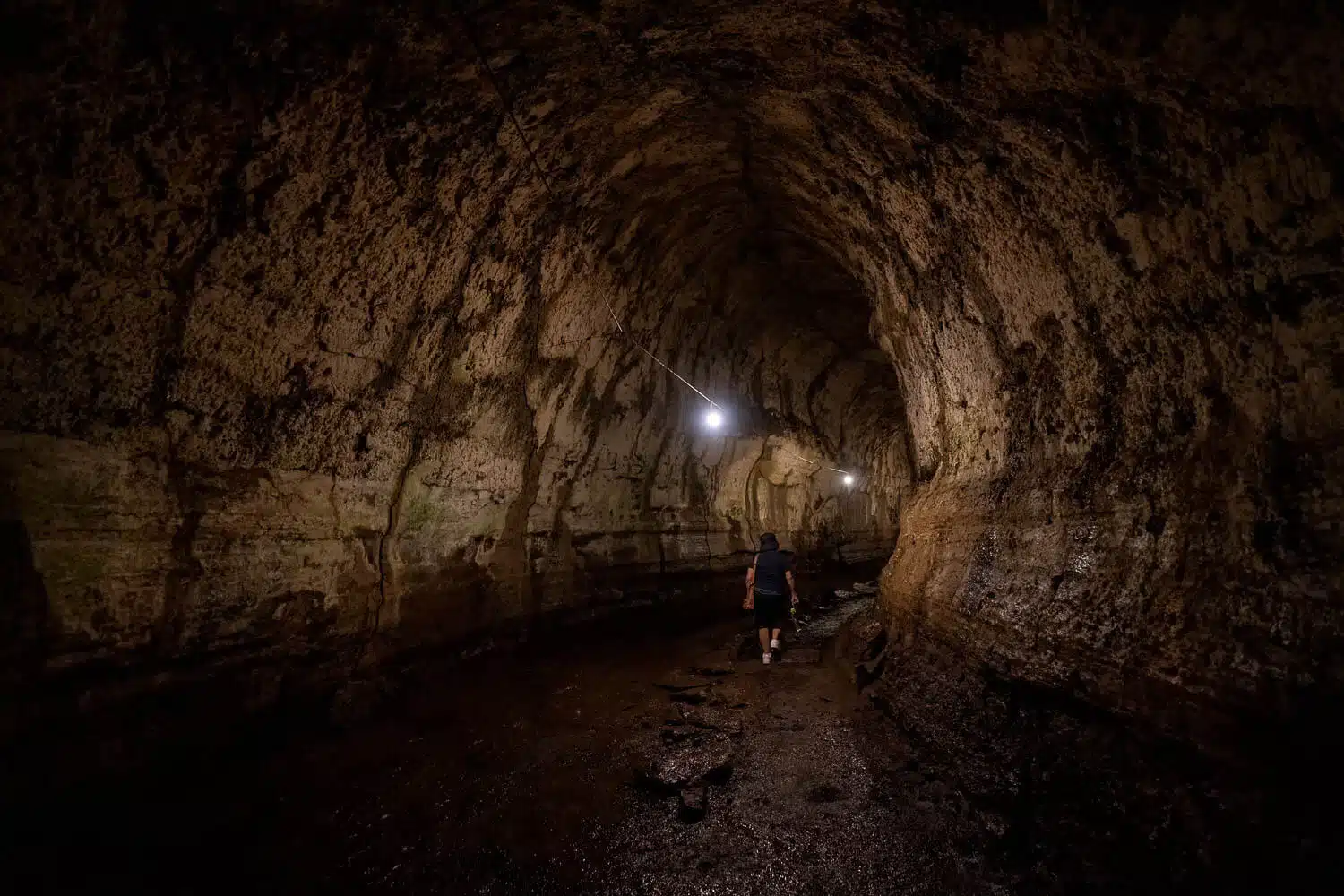
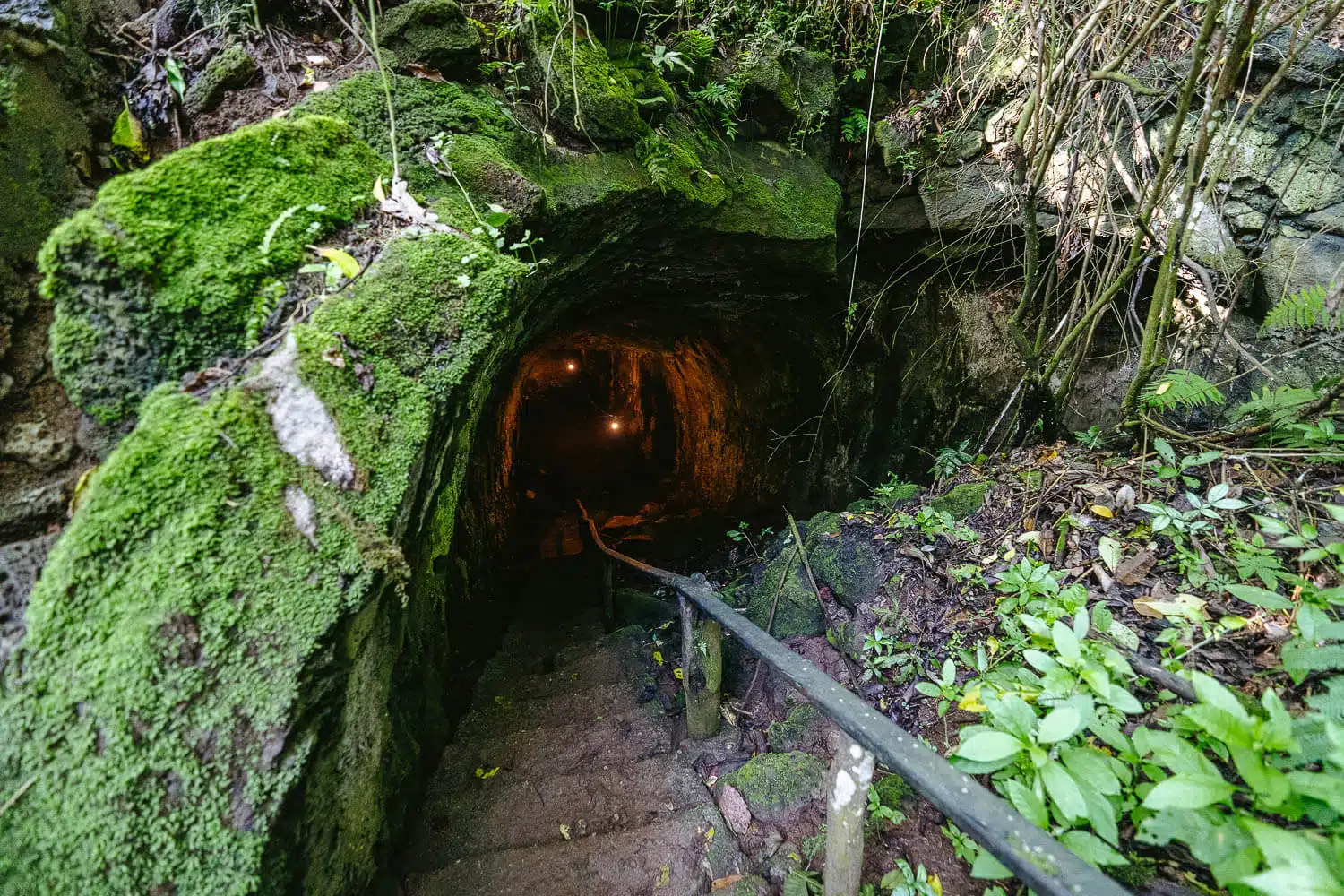
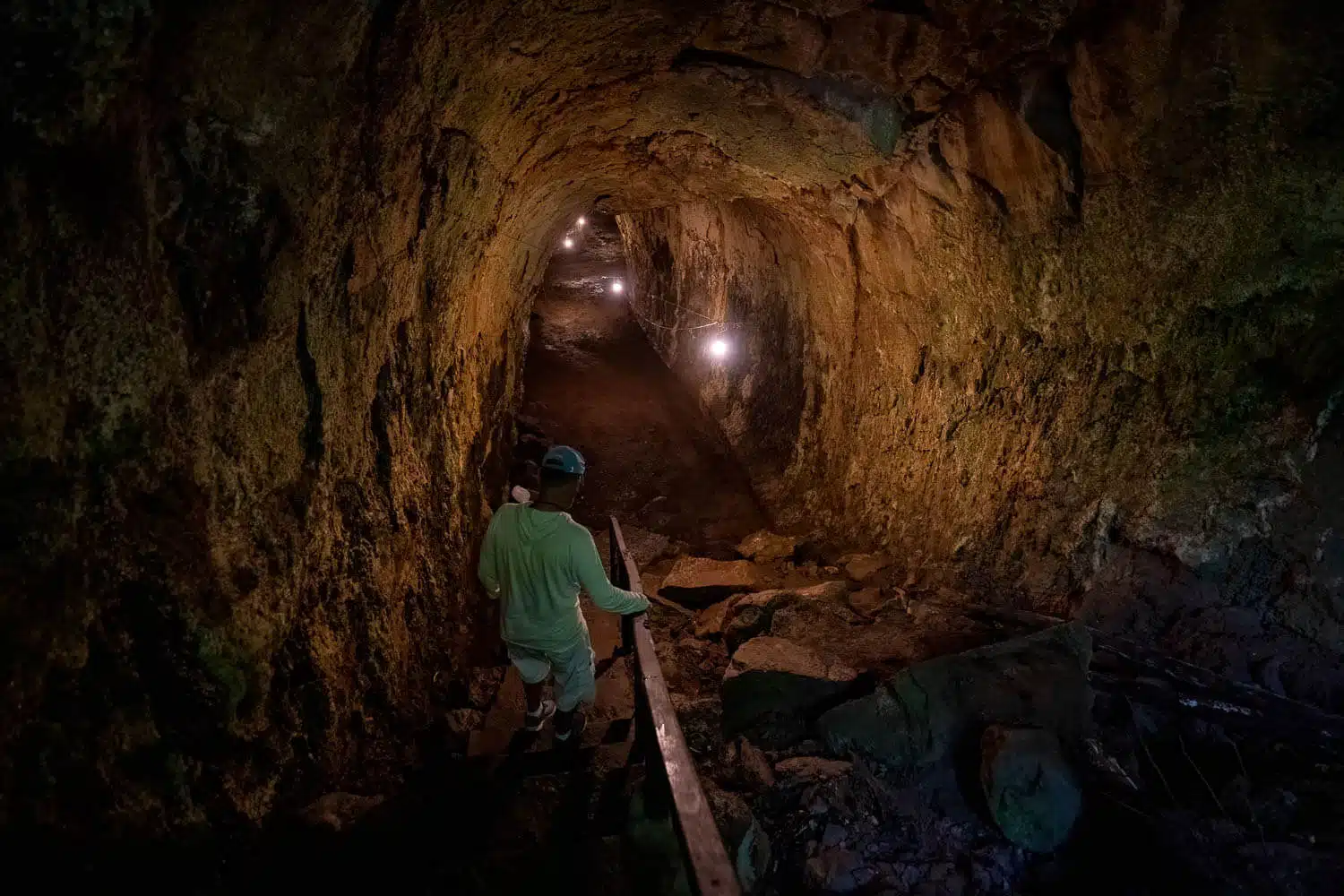
3. Giant Tortoise Reserves of
"El Chato" or "Las Primícias"
This is a very famous tourist attraction for local families and therefore it’s usually a bit full. It isn’t a breeding center like in Charles Darwin Foundation that I will talk about afterward, this is a private ranch, where the lava tunnels are also located and they have giant tortoises walking around freely.
As for facilities, there is a restaurant, a gift shop, and a small museum with ancient giant shells for you to see. On the right side of the museum, there is also a tourist attraction where you can go inside a shell, pretending you’re a tortoise, with the letters “I <3 Las Primícias” behind you, and take a photo.
In order to visit it you must hire a taxi, therefore, it’s usually included in a tour where the taxi takes you to multiple destinations.
This tour is called “The Highlands Tour” or “Tour Parte Alta” and takes you to the Pit Craters “Los Gemelos”, the Lava Tunnels, and the Giant Tortoise Reserve “El Chato” or “Las Primícias”.
View the full blog post here: HIGHLANDS TOUR IN SANTA CRUZ
To book this tour: Check the local company Galapagos Dreams’s website, or book it online on Viator here: The Giant Tortoise Experience | Lava Tubes + Los Gemelos
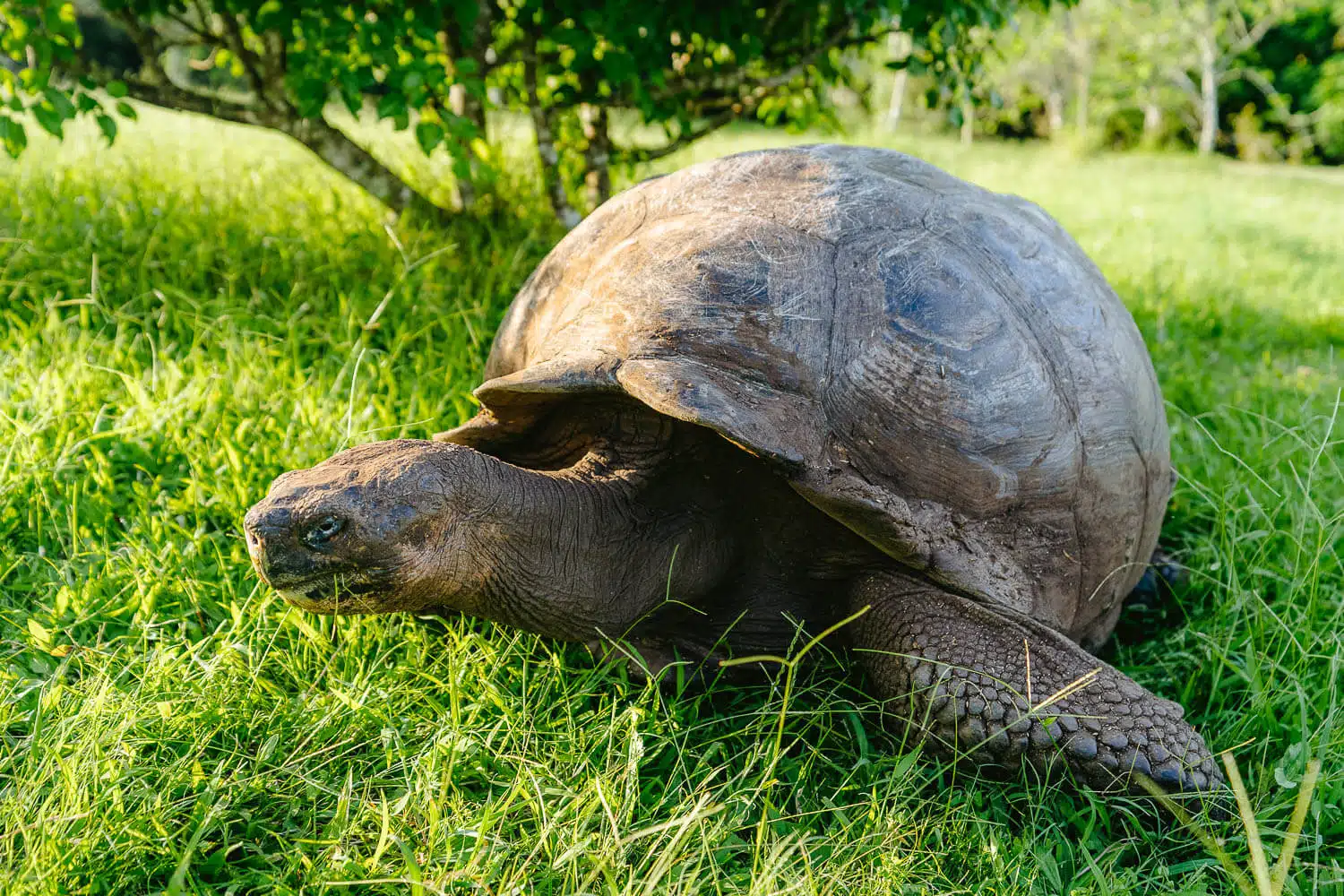
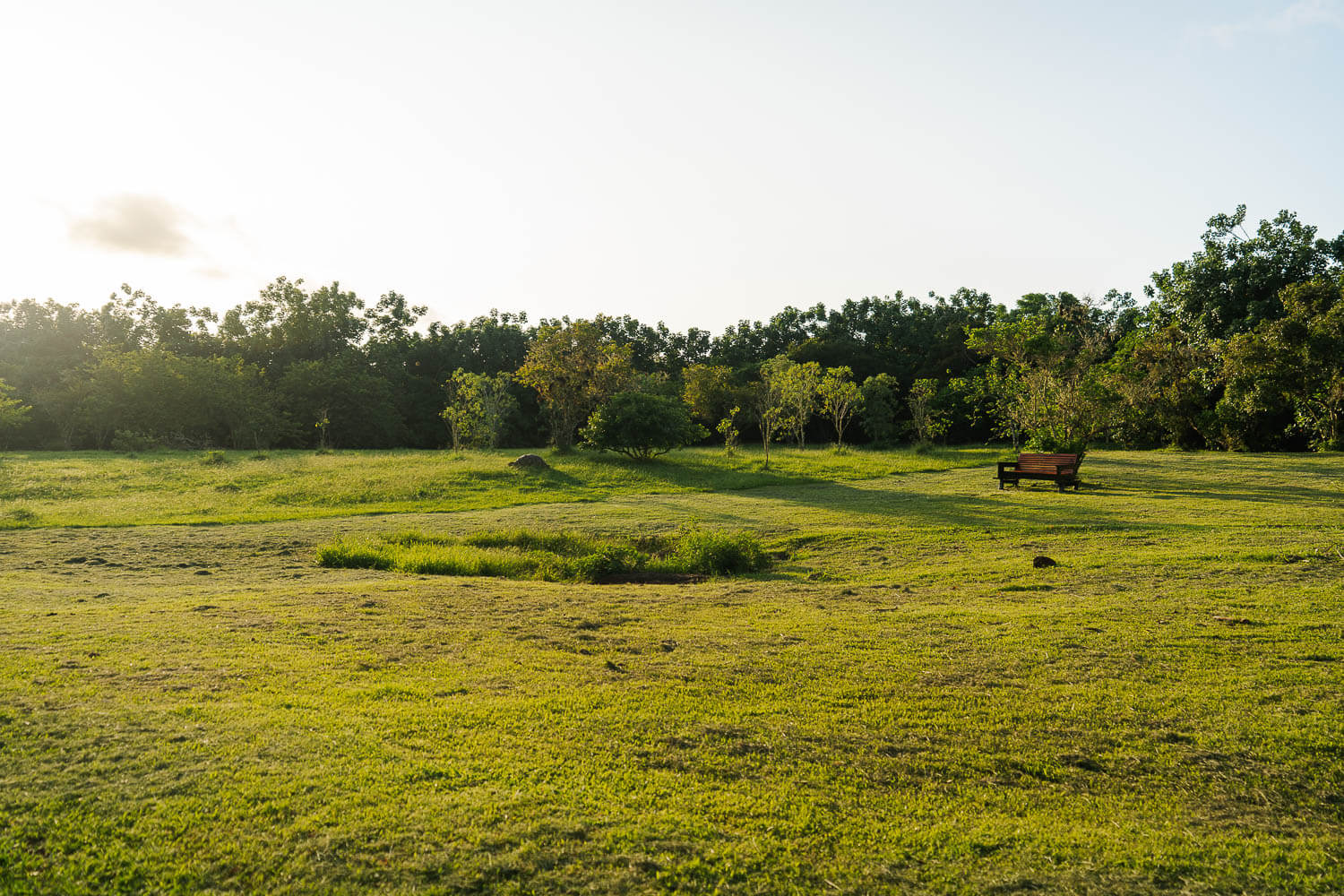
4. Charles Darwin Research Station
The Charles Darwin Research Station on Santa Cruz island is where all the science and main environmental projects on the Galapagos archipelago come from. Here they study and develop techniques that help protect the unique species of these islands. If you are a scientist, a student, or interested in the protection of this paradise you can volunteer here and help with a plethora of research tasks.
In the Research Station, you will also find a giant tortoise breeding center and you will have the chance to see embalmed Lonesome George, he was the oldest specimen of his giant tortoise kind and unfortunately died in 2012. You can see many different types of Galapagos endemic flora and some information about Charles Darwin, additionally, there is also a cafeteria, bathrooms, and a public library.
View the full blog post here: CHARLES DARWIN RESEARCH STATION
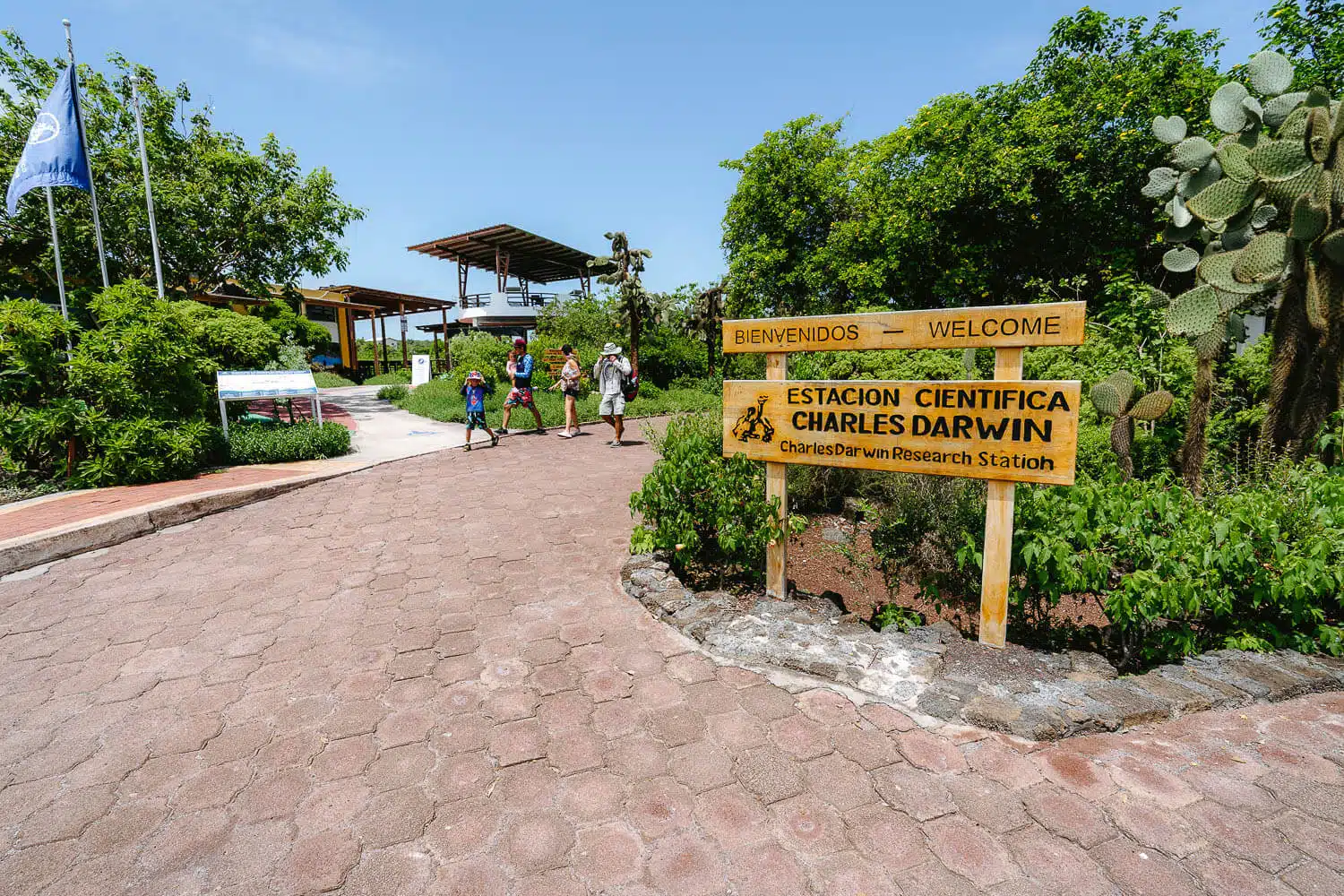
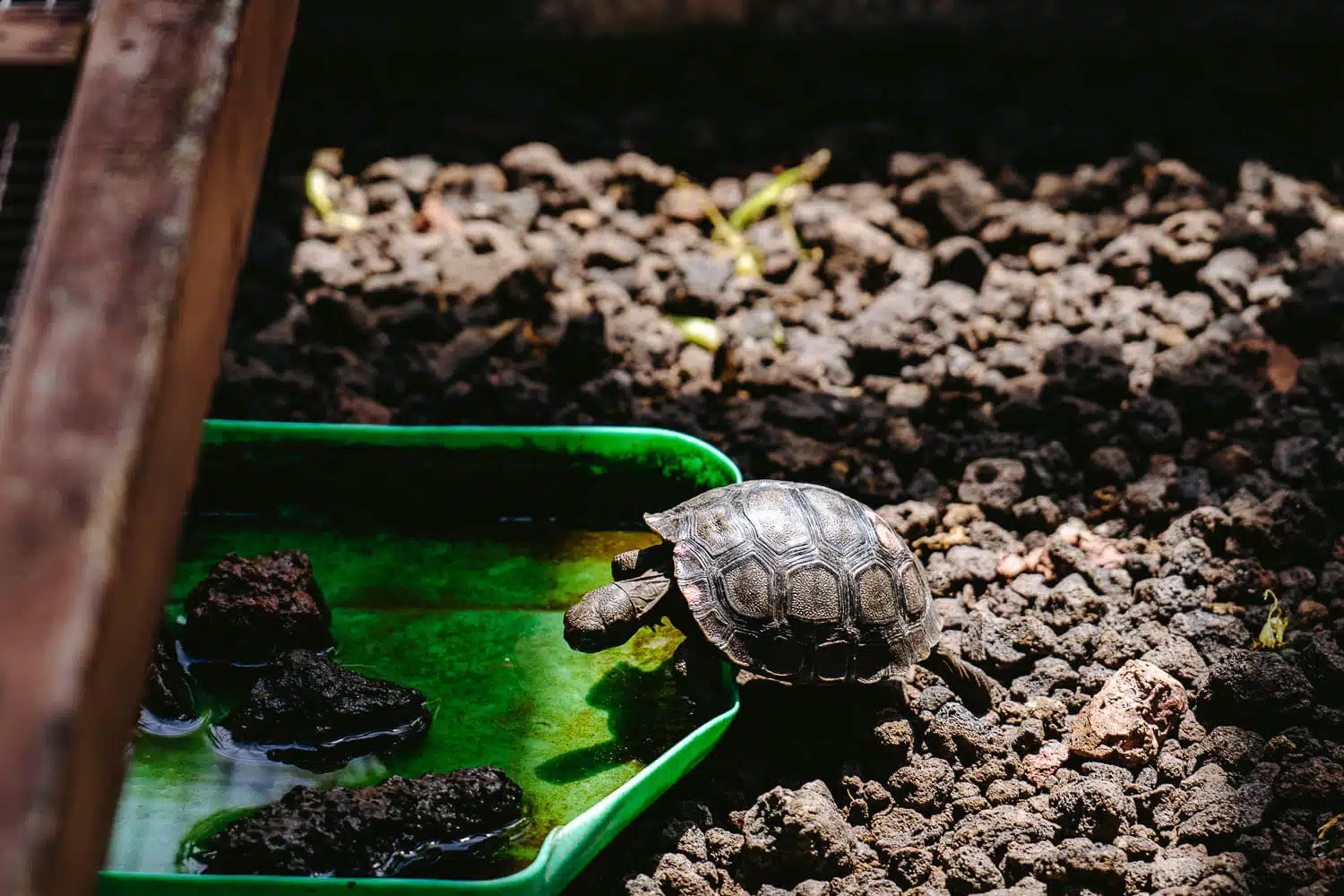
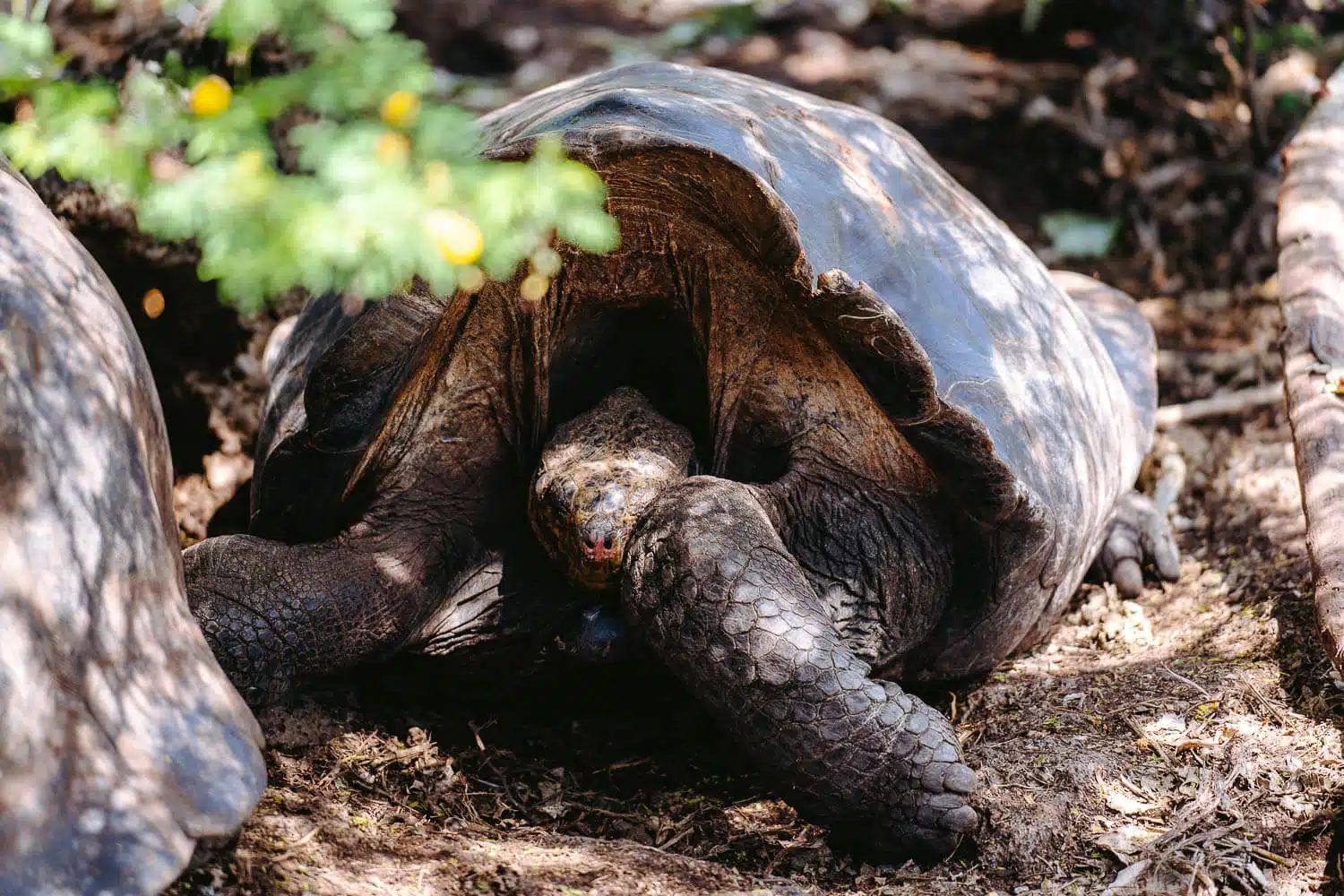
5. Nymphs Lagoon
The Nymphs Lagoon in Santa Cruz is a beautiful lagoon full of mangroves that you can visit just a short walk from Puerto Ayora’s city center. Altogether it is a great stop on your way to Tortuga Bay beach especially because it is free and very family friendly.
To reach the Nymphs Lagoon or Laguna de Las Ninfas, you can either go by taxi, bike, or on foot, nevertheless, I advise you to go on foot as it’s almost literally in the middle of the city. It’s not permitted to swim, fish, kayak, or disturb the animals around the lagoon.
View the full blog post here: NYMPHS LAGOON IN SANTA CRUZ
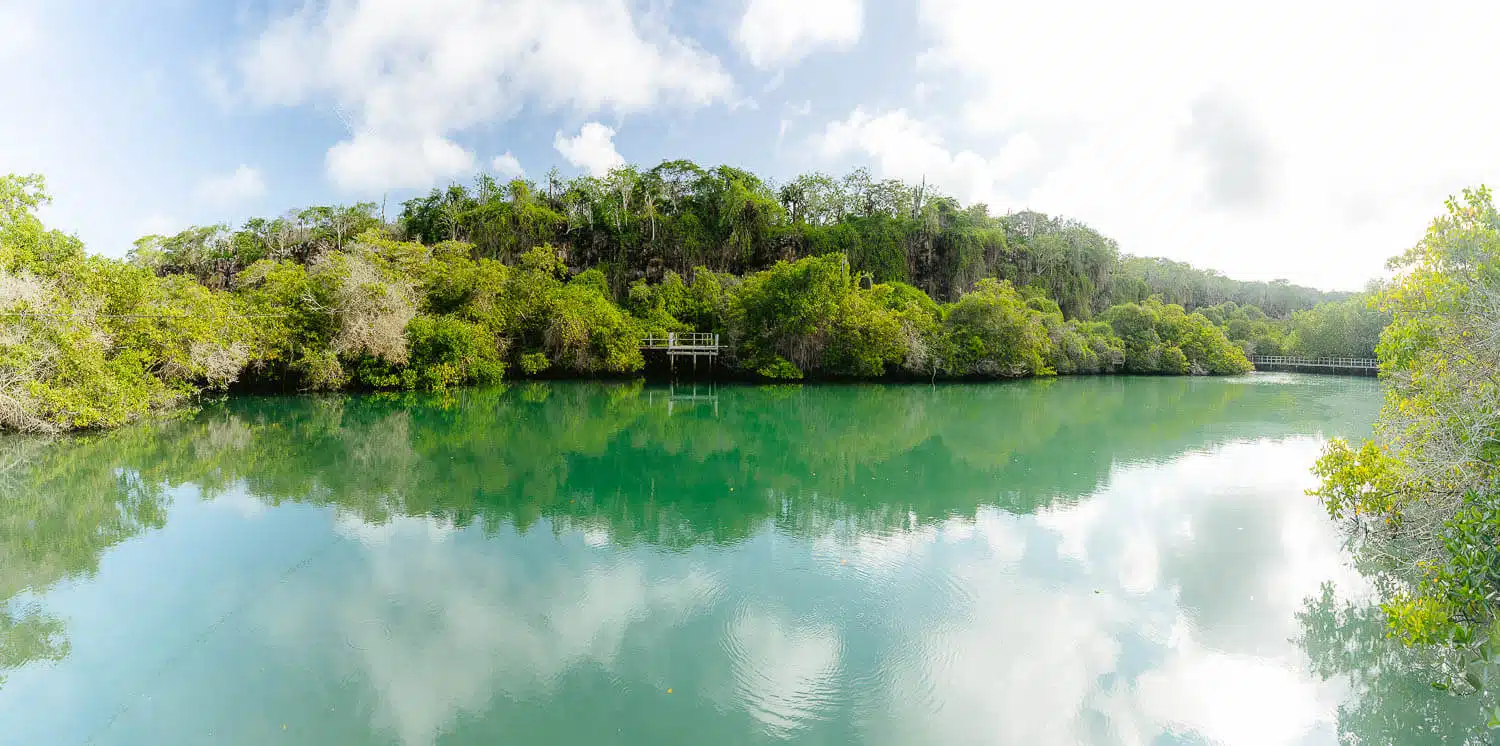
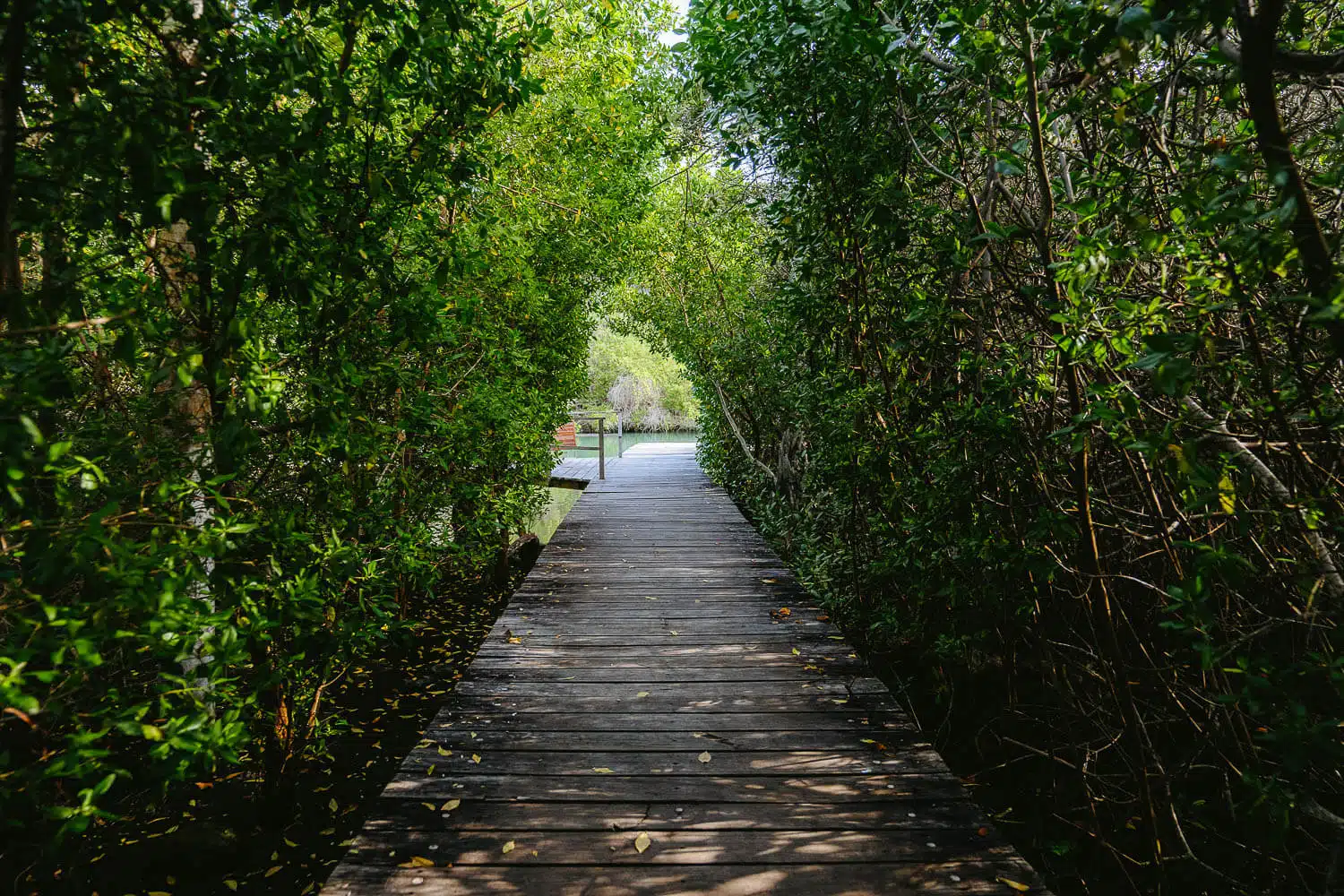
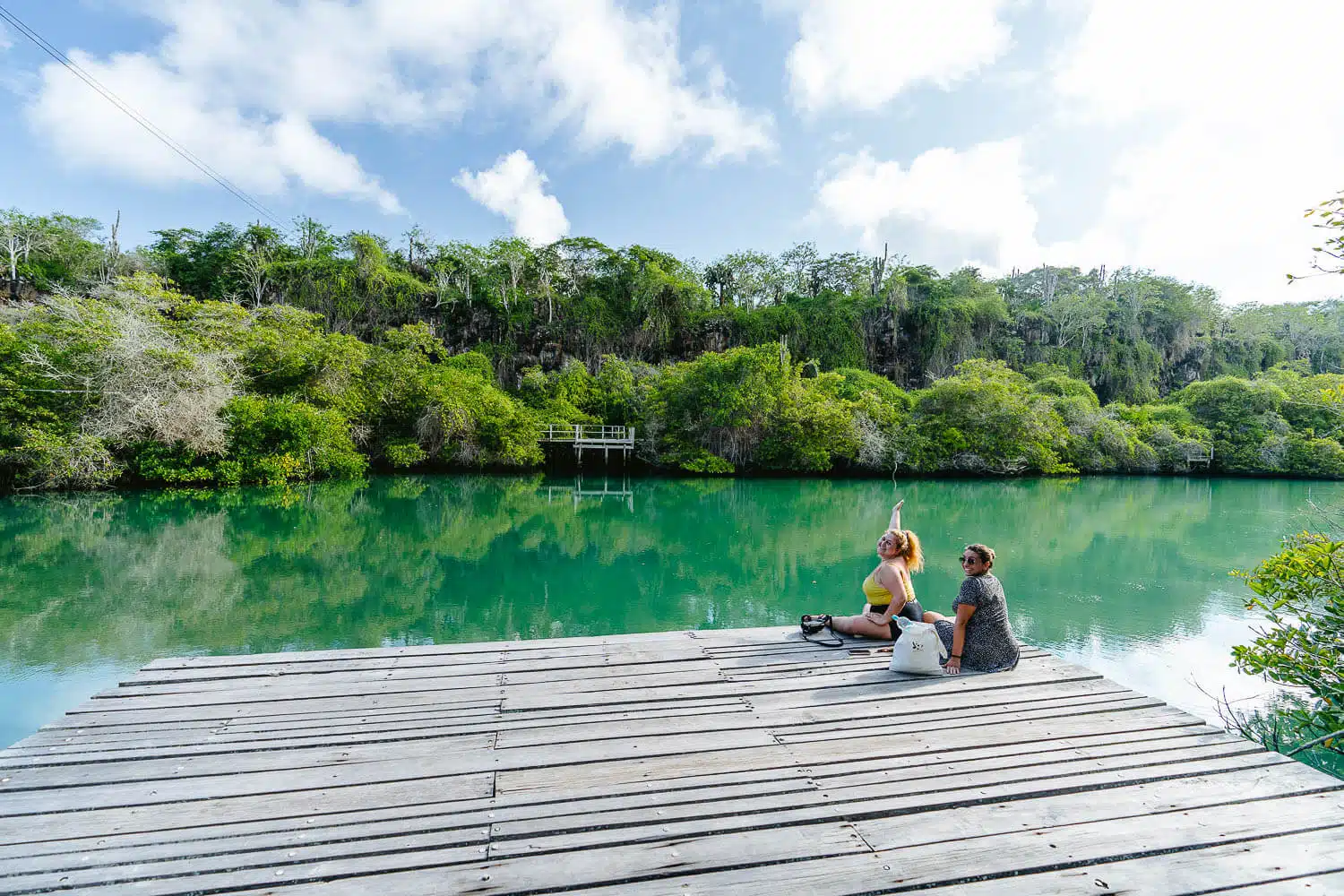
6. Station Beach
There are two main beaches part of the Charles Darwin Research Station complex. Station Beach is one of them. Both have lots of rocks and little sand next to the water. There aren’t usually many people here, thus it is a place to consider spending the day in you can also easily park your bike at the entrance.
You can usually find a couple of marine iguanas disguised as rocks around the beach. It is a nice place to swim and snorkel, in addition, apart from the Alemanes beach (which is on the other side of Puerto Ayora’s town), there isn’t any other nearby beach for a short dive on a hot day. It’s free and it’s the perfect refreshment after spending some hours at the research station.
View the full blog post here: CHARLES DARWIN RESEARCH STATION
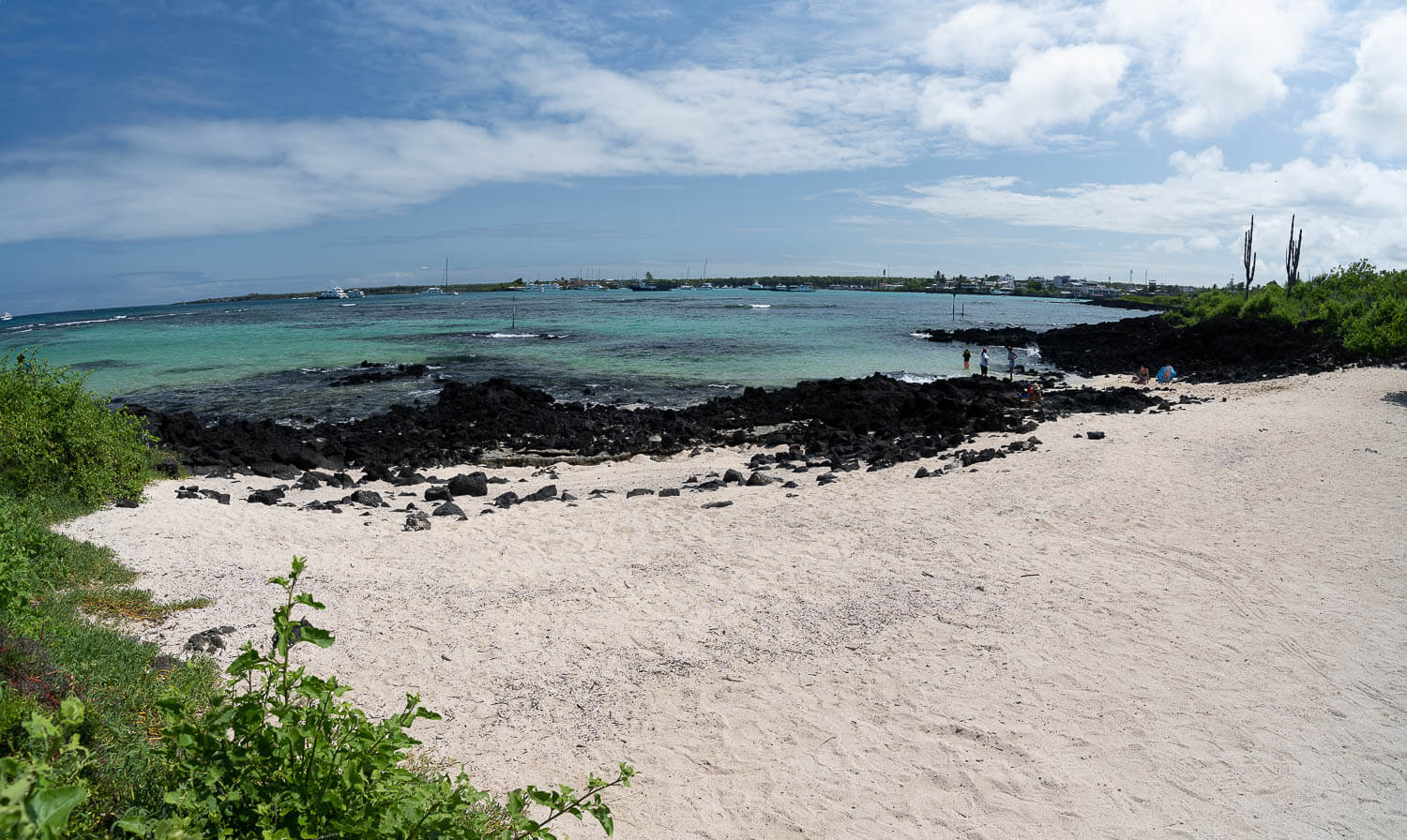
7. Santa Cruz's Downtown
One thing you can’t miss is exploring Puerto Ayora’s downtown (Santa Cruz island’s capital). As I said before, Santa Cruz is the most touristy of all the three main islands, but that comes also with some pluses, it has plenty of restaurants, bars, coffees, and trendy shops.
For me personally, the nightlife was great, the international food and craft beers scene too and there were really nice trendy clothing shops. Apart from the great tourism infrastructure, please go check the fish market, where many pelicans and sea lions come for a snack all the time.
There is also a famous giant tortoise statue, and the area around the dock, where there are usually some events going on. During the day you can spot schools of golden rays and reef sharks from the surface of the dock.
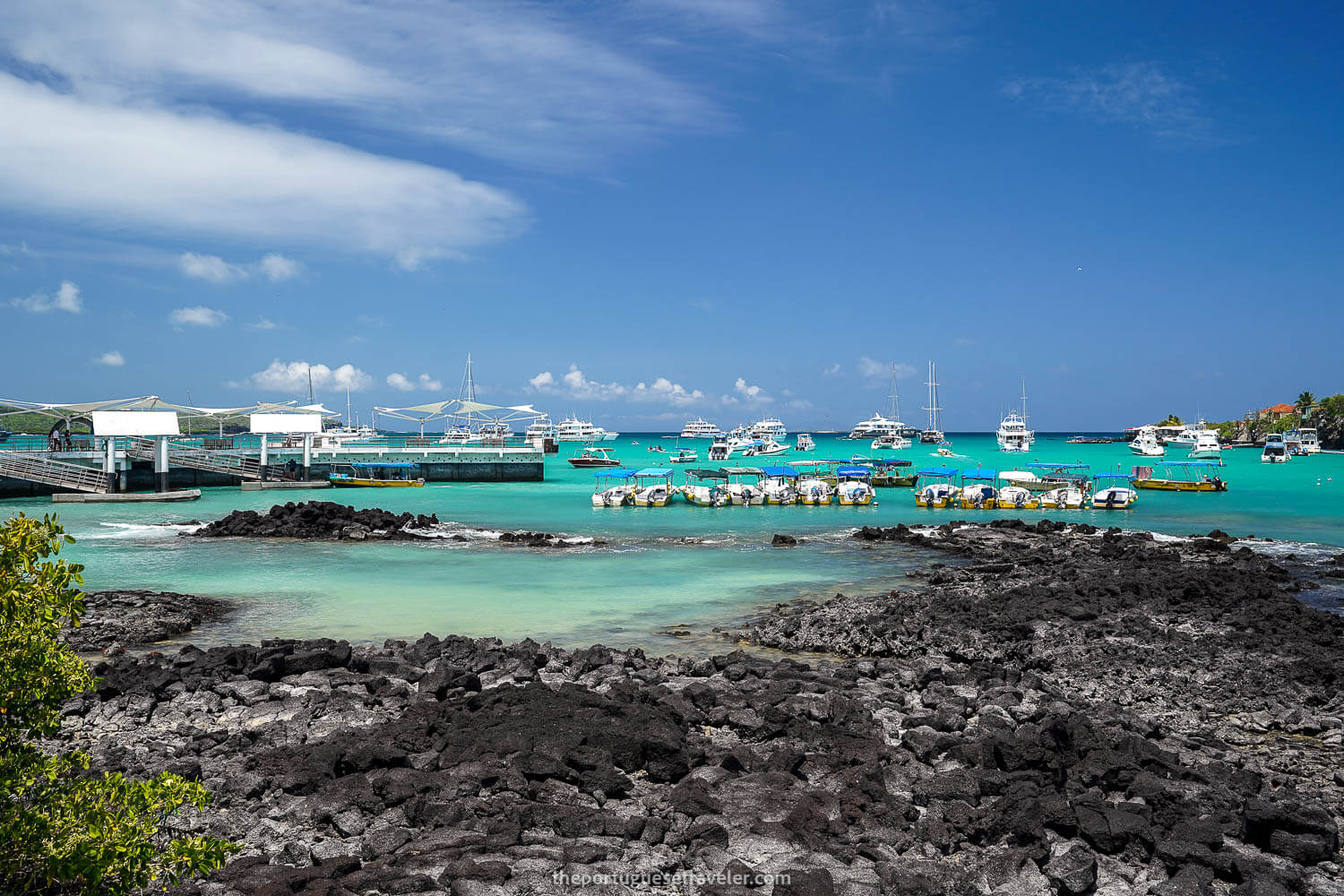
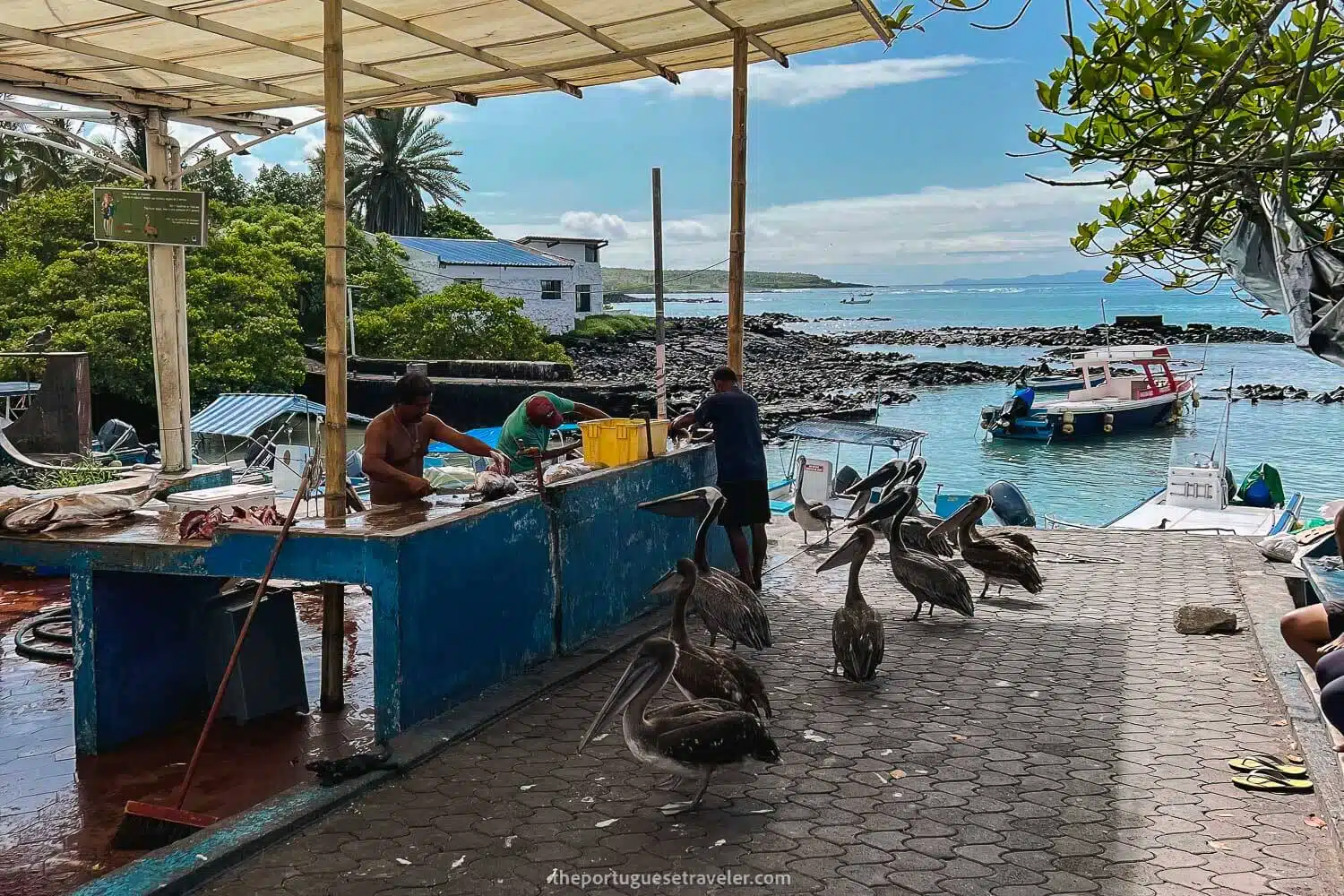
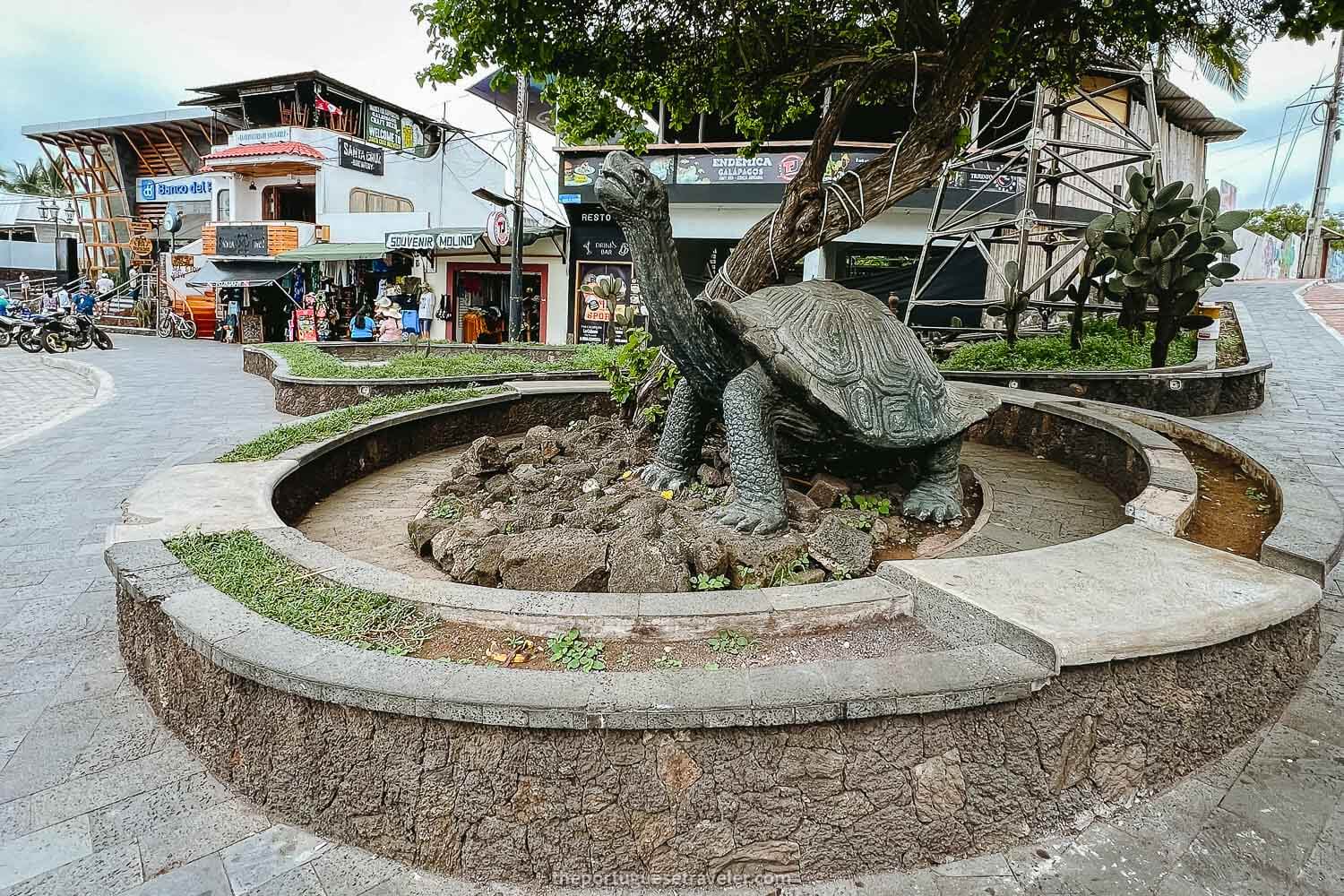
8. La Ratonera Beach
La Ratonera Beach is the most distant beach on the Charles Darwin Research Center complex. For that reason and from being a bit closer to the open sea, it is especially famous for its surfing-quality waves.
This beach has lots of rocks and little sand next to the water and there aren’t usually many people here, it is free and it’s the perfect refreshment after spending some hours at the research station. You can usually find a couple of marine iguanas disguised as rocks around the beach.
View the full blog post here: CHARLES DARWIN RESEARCH STATION
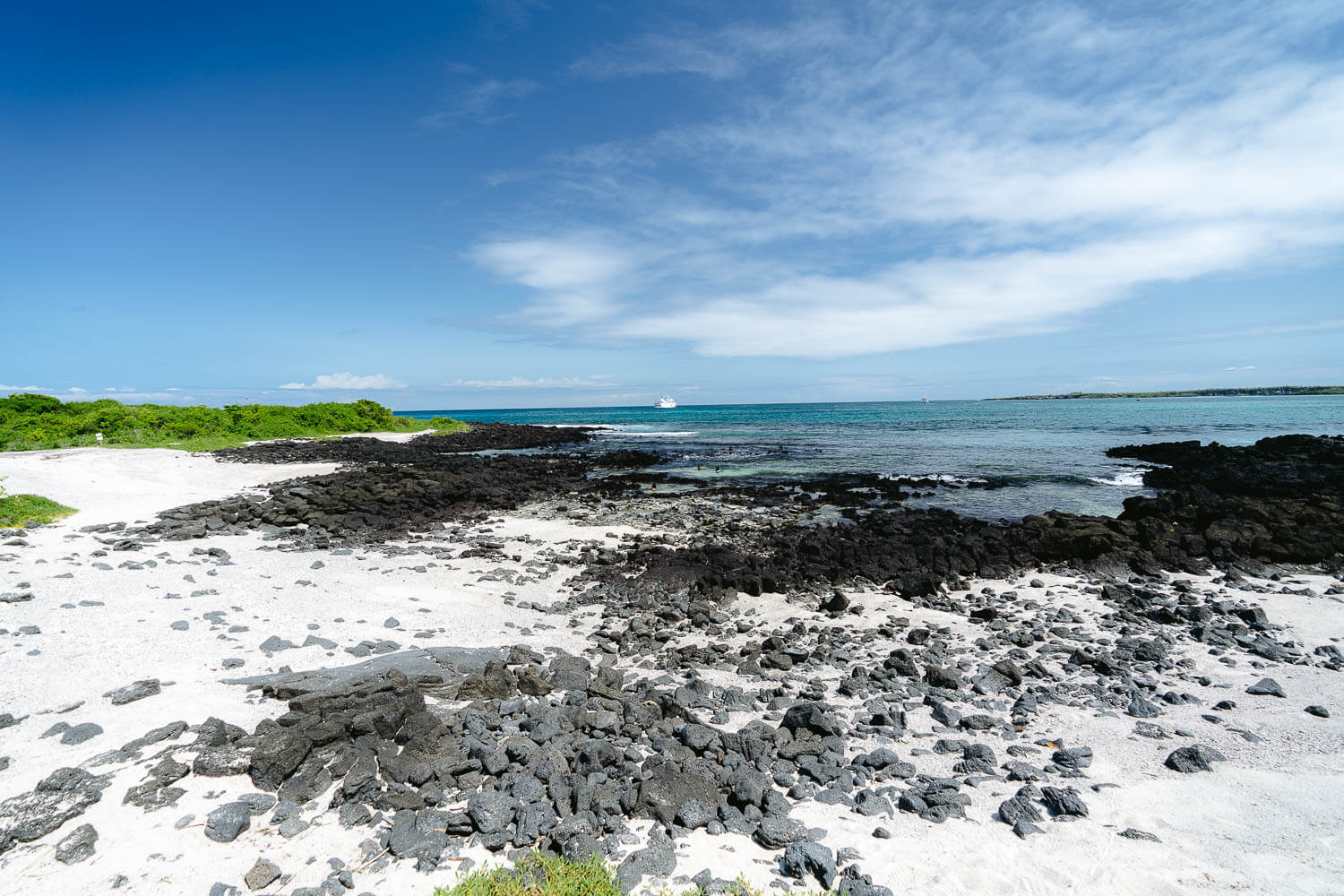
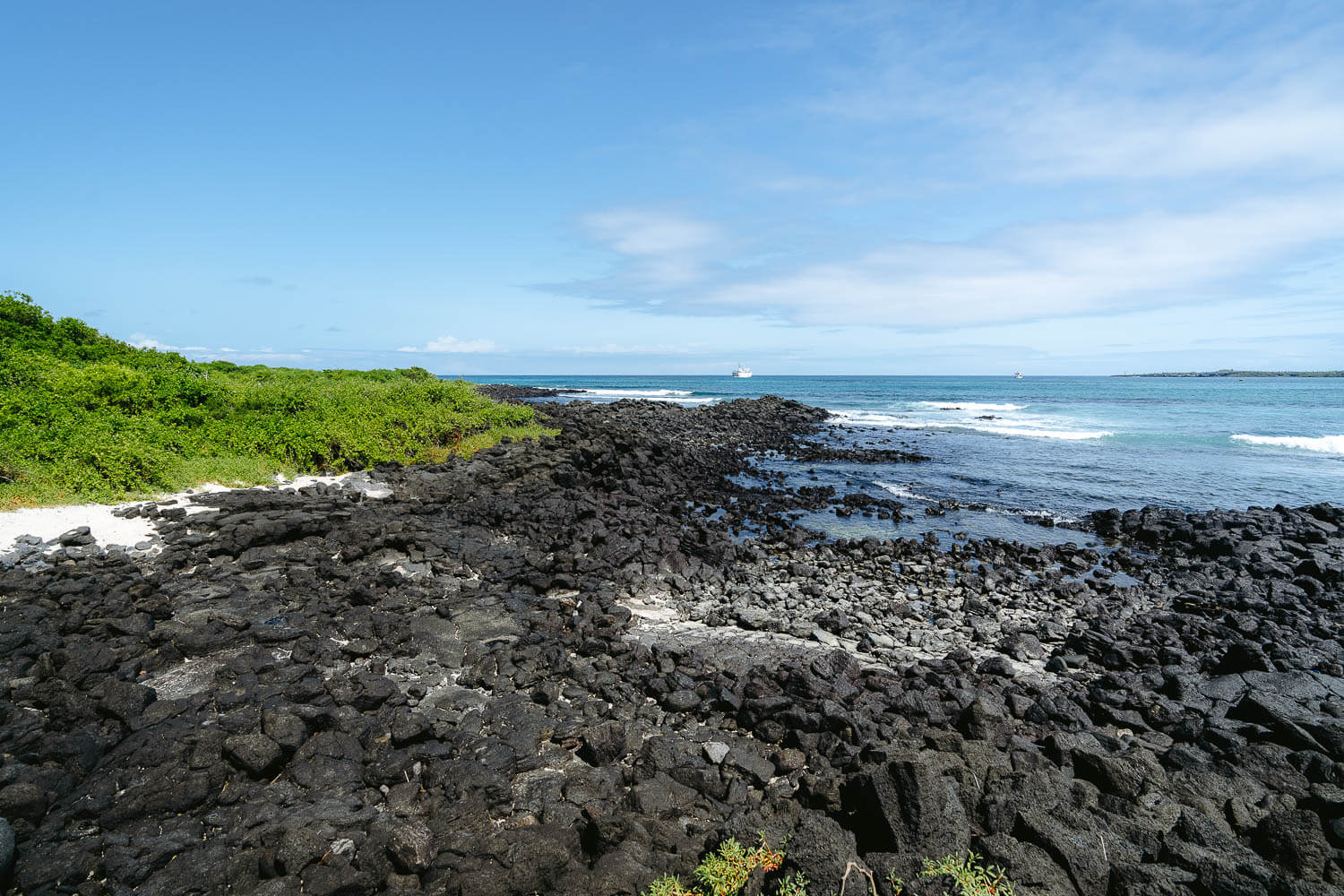
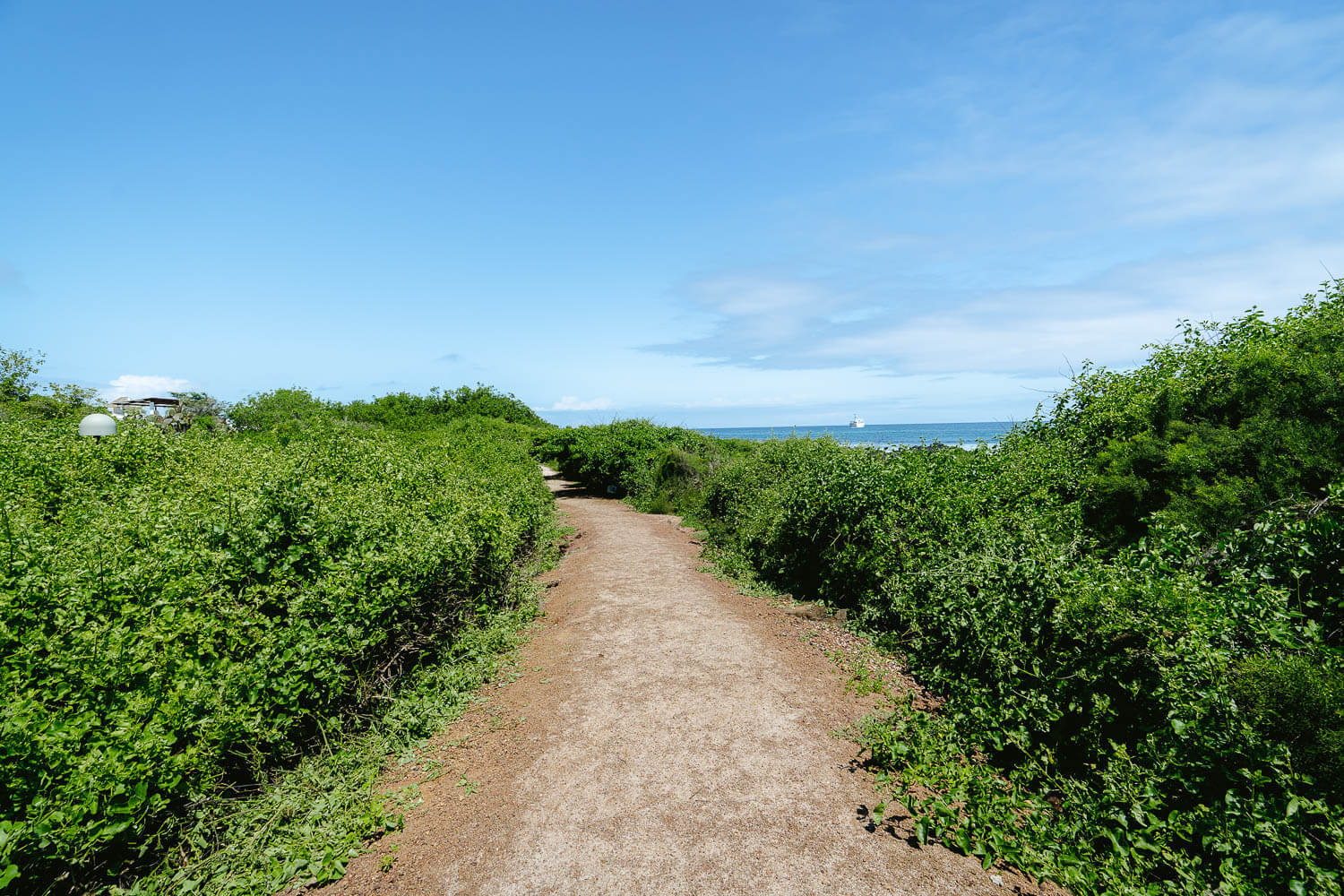
9. Love Channel
The Love Channel or Canal del Amor is a gorgeous turquoise channel sandwiched between lava walls. This is one of the most beautiful places in Santa Cruz mainland. And if you just go to the famous Las Grietas by yourself you’ll probably miss it. It is included nevertheless in a famous tour called the Bay Tour or Tour de Bahia.
It’s called the Love Channel as couples used to come here to have fun. Nowadays it’s forbidden to swim here, but it’s still a beautiful place to appreciate and take some photos, and from the wooden viewpoint, you can observe shorebirds and reef sharks.
View the full blog post here: BAY TOUR IN SANTA CRUZ
To book this tour: Check the local company Galapagos Dreams, or book it online on Viator here: Half Day Bay Tour in Santa Cruz Island
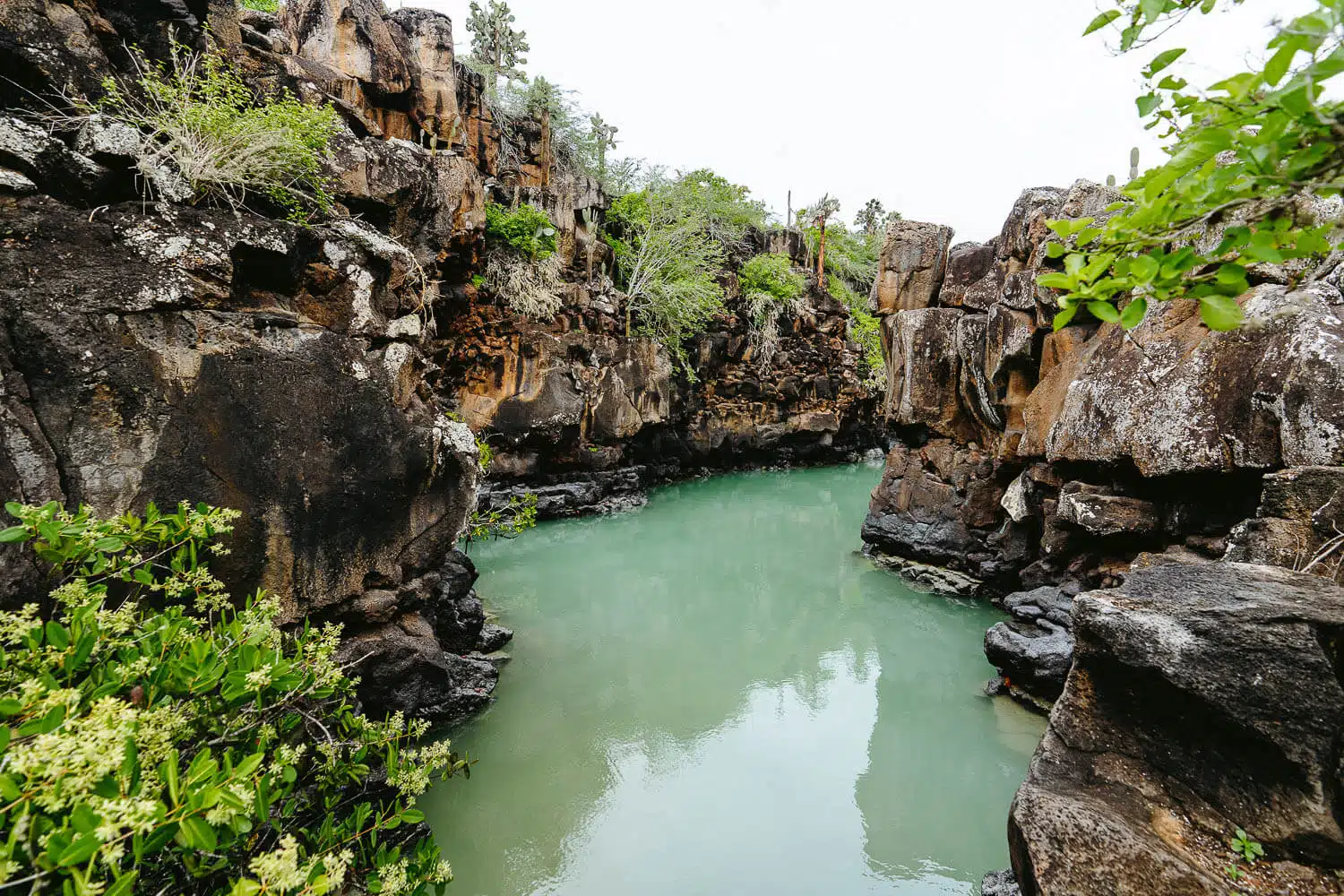
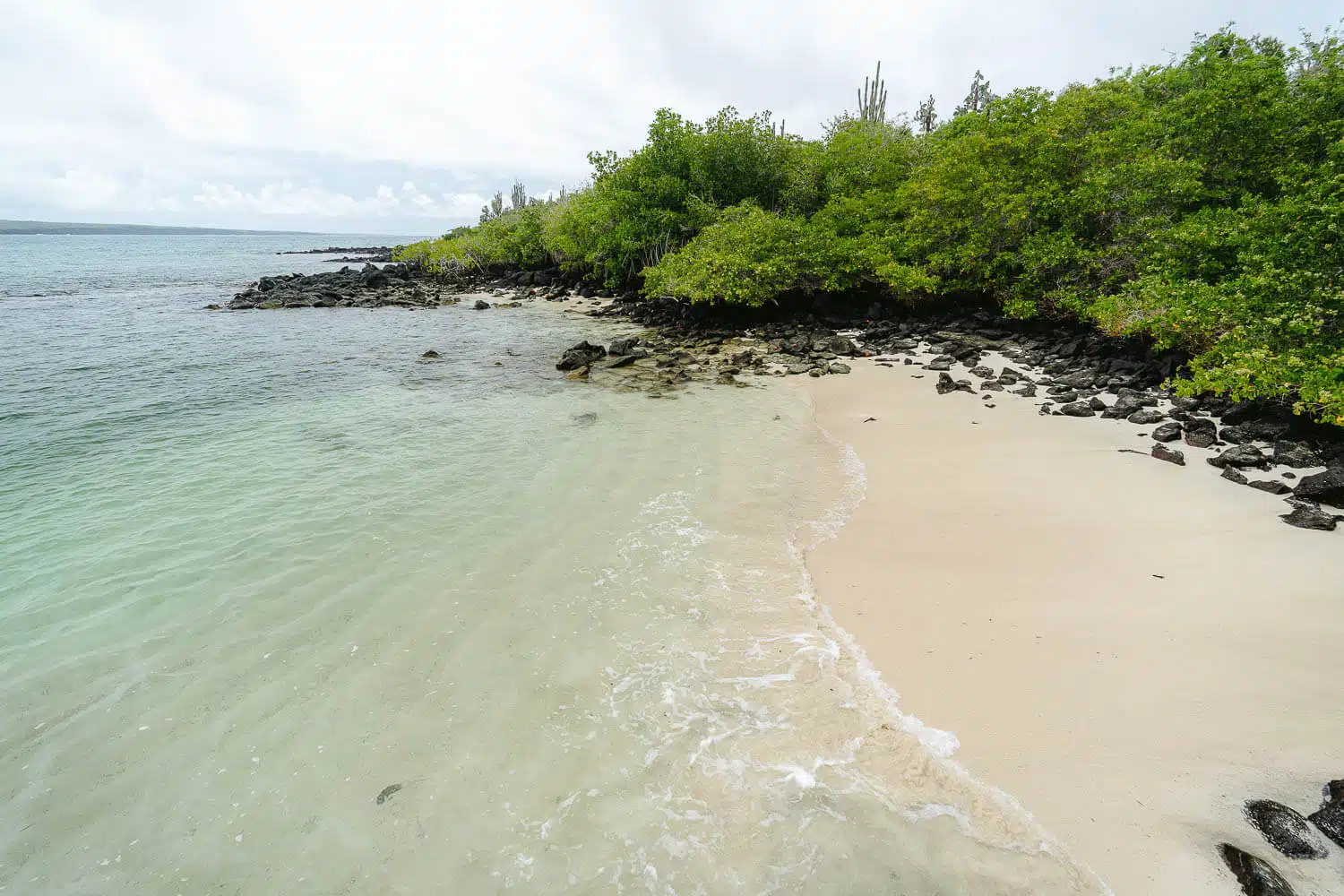
Things To Do in
San Cristobal and Isabela Islands
10. Las Grietas
Las Grietas or “The Rifts/Crevasses” is a canyon-like structure filled with water, a lava rock formation of two cliffs separated by an ocean water fissure. Here you can swim and snorkel. The underwater formations are amazing so please bring your snorkel kit.
It’s usually crowded and lately, a minimum price of 10$ USD must be paid at the entrance even if you come without a tour. If you do come with a tour, the most famous one is called “Bay Tour” or “Tour de Bahia” and it also includes the Love Chanel, Playa de Los Perros beach, and Las Tintoreras baby reef-shark pools.
View the full blog post here: BAY TOUR IN SANTA CRUZ
To book this tour: Check the local company Galapagos Dreams, or book it online on Viator here: Half Day Bay Tour in Santa Cruz Island
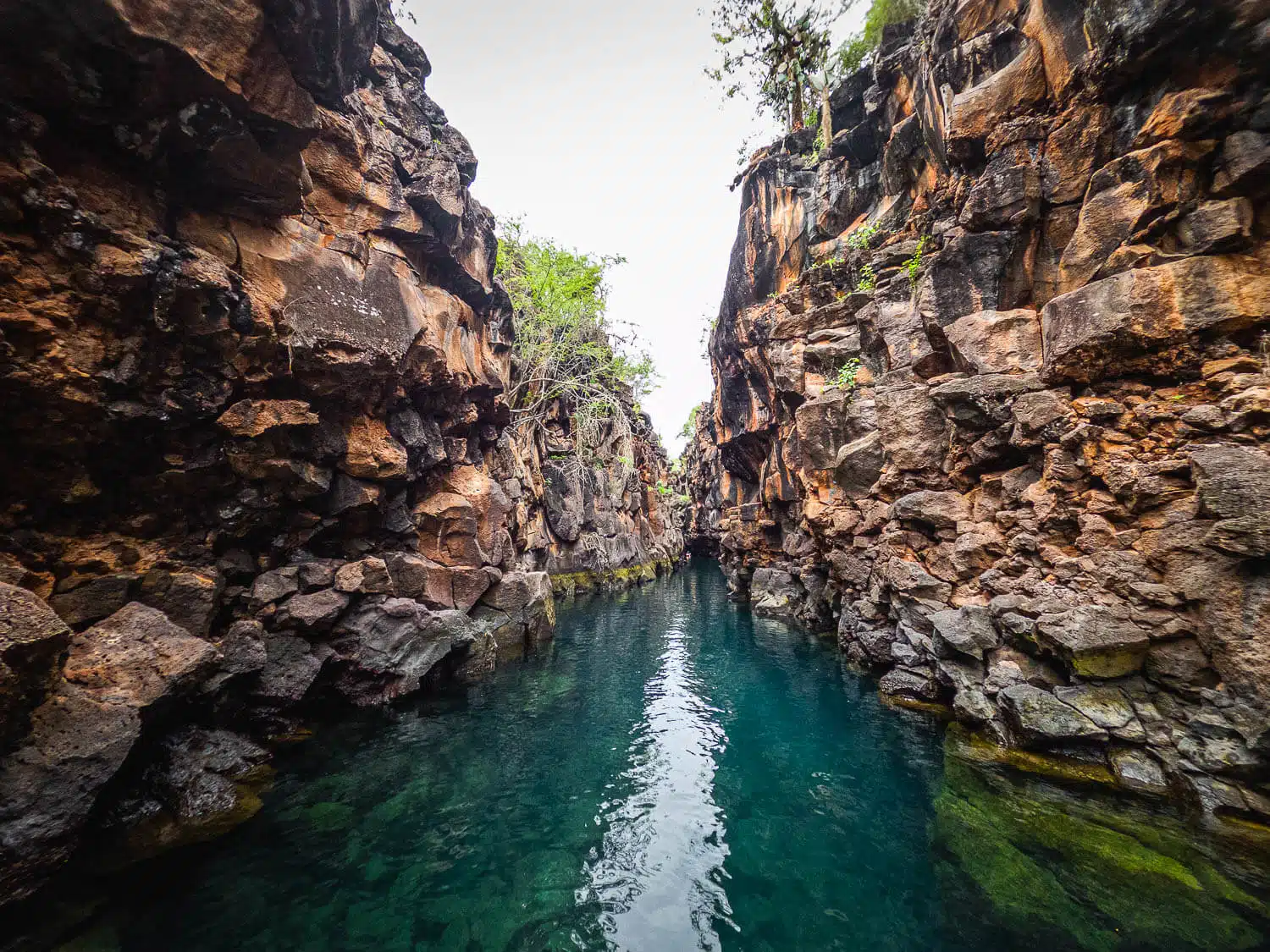
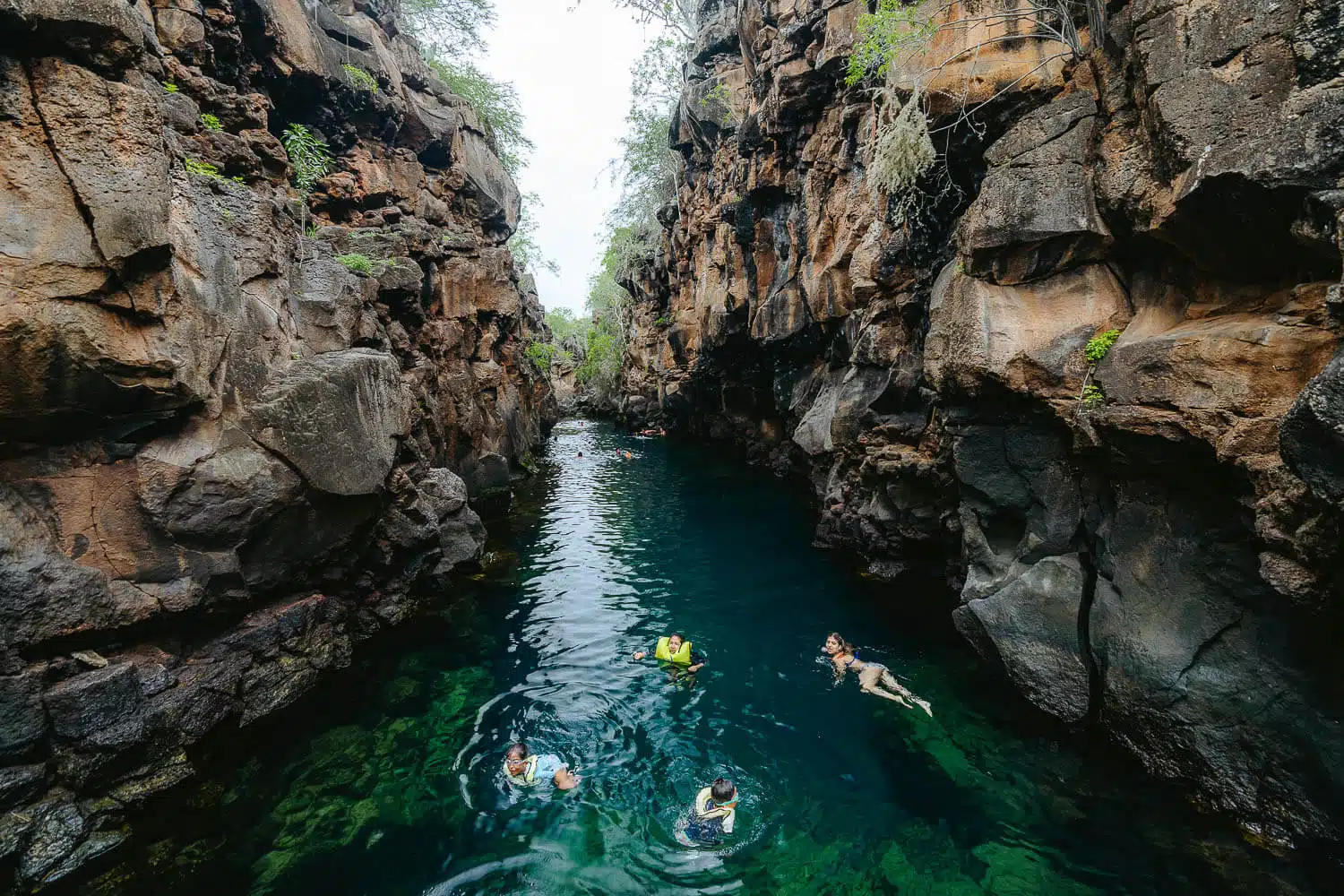
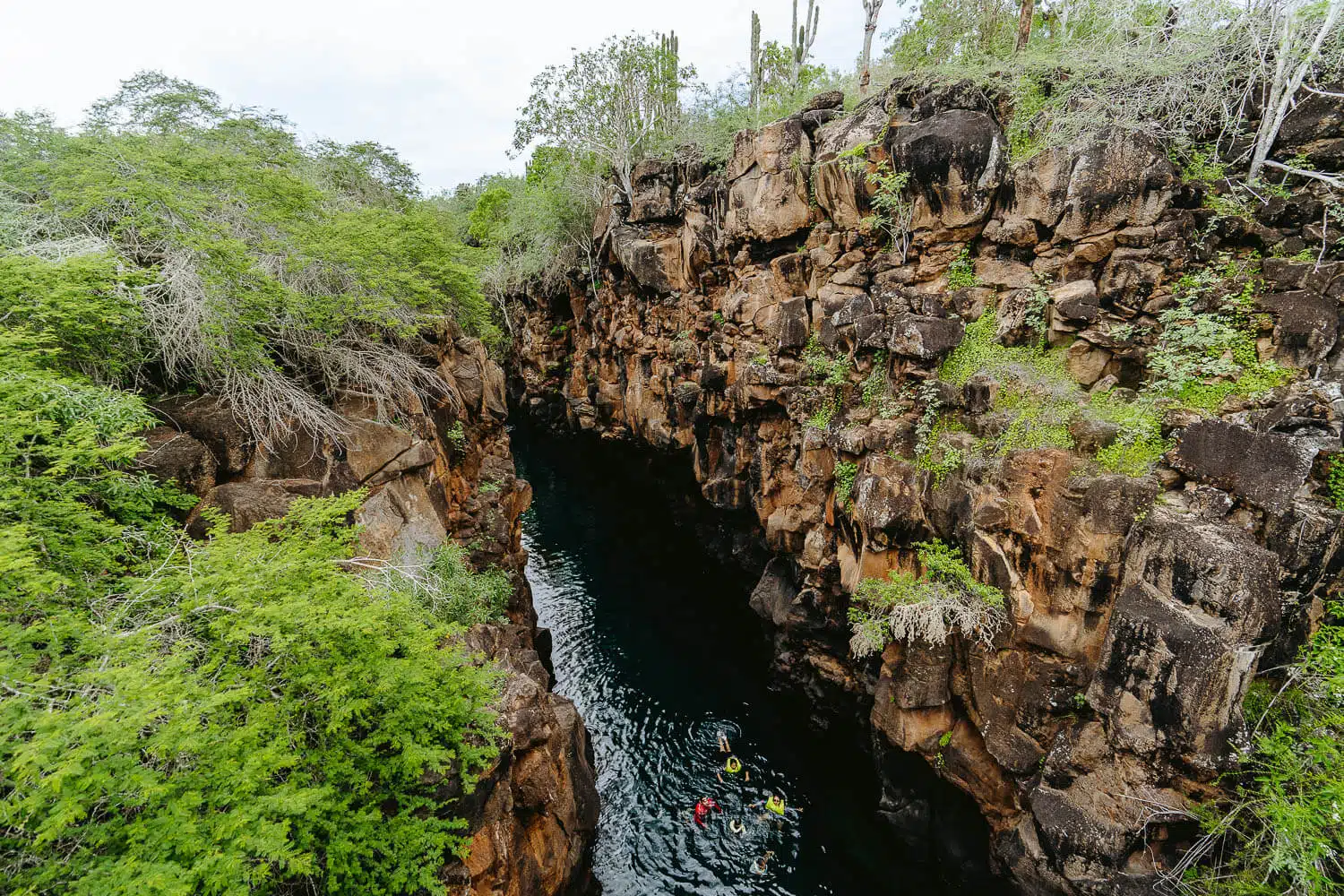
11. Playa de Los Alemanes Beach
Playa de Los Alemanes or Germans Beach is located right next to Las Grietas and it’s the perfect place to come if you want to relax with your family. It is possible to come here for 1$ USD by water taxi from the main port of Puerto Ayora. Try to come on low tide cause the sand almost disappears on high tide. The water is usually very calm and shallow and it’s the perfect spot for snorkeling.
You might be lucky your hotel is nearby and you can come here whenever you want. If it’s not and you come on the Bay Tour you can ask your guide to stay on the beach and later just pay for a water taxi to go back.
View the full blog post here: BAY TOUR IN SANTA CRUZ
To book this tour: Check the local company Galapagos Dreams, or book it online on Viator here: Half Day Bay Tour in Santa Cruz Island
12. Tortuga Bay Beach
The Tortuga Bay beach in Santa Cruz island is for me the most beautiful beach that I’ve visited in the Galapagos islands. Its name comes from this being the place where many turtles come and lay their eggs on the beach. This white-sanded paradise is home to many marine iguanas and baby reef sharks.
Here you can surf, sunbathe, kayak and for sure relax. It is located roughly 3 km southwest of Puerto Ayora town on Santa Cruz island. Tortuga Bay consists of two beaches, the longest one, with waves called Playa Brava (Brave beach), and a smaller and quieter one without waves called Playa Mansa (Tame beach).
View the full blog post here: TORTUGA BAY BEACH IN SANTA CRUZ
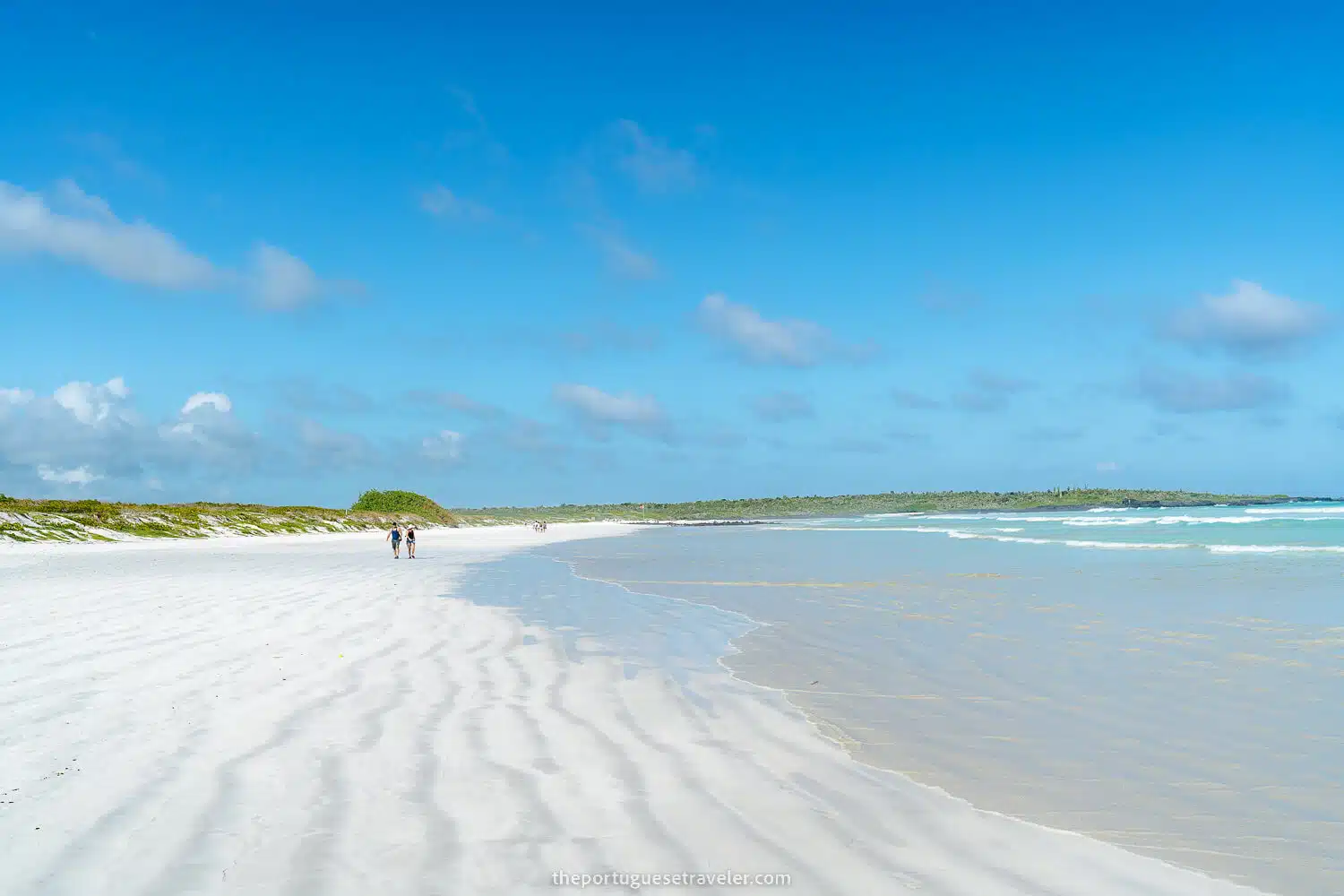
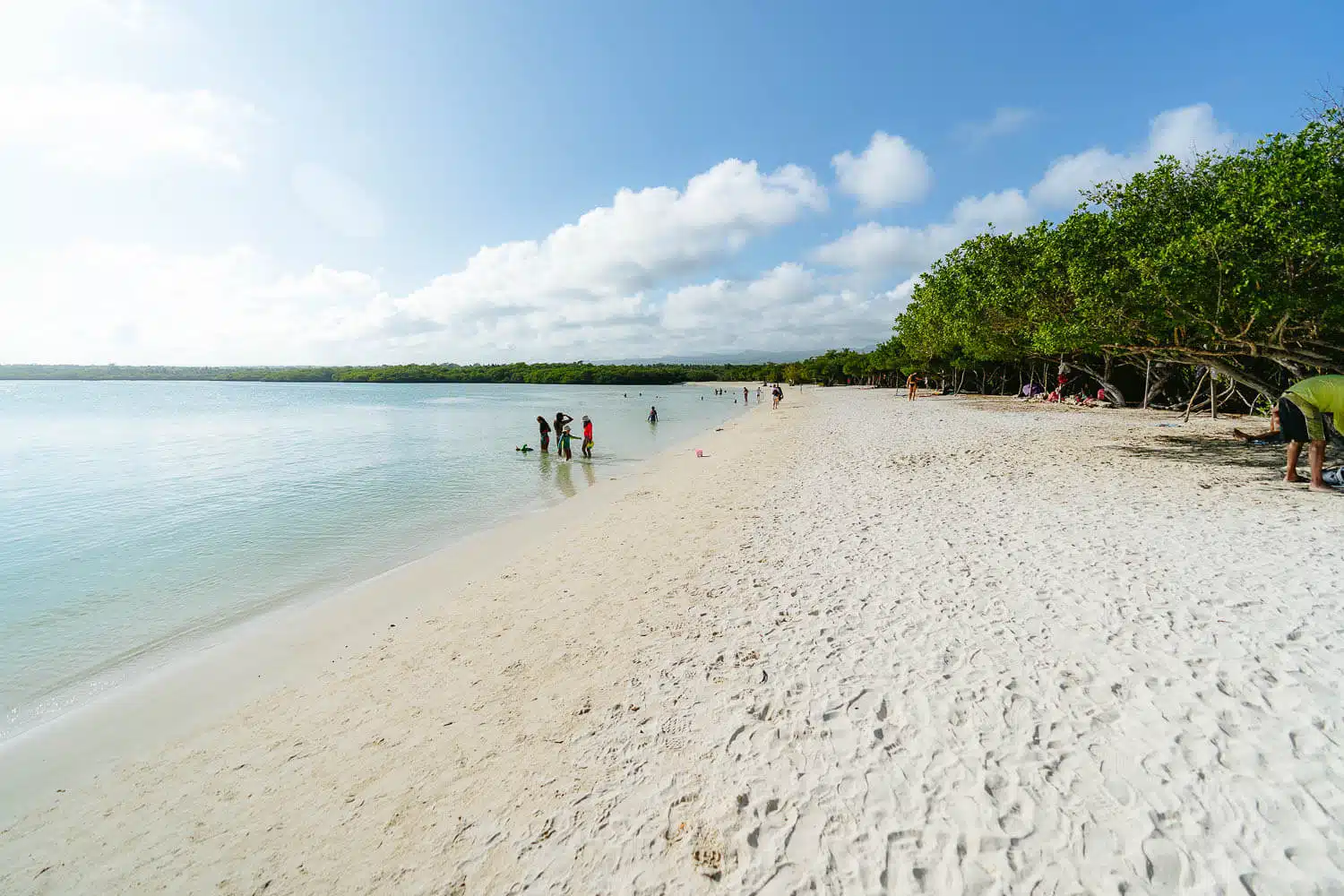
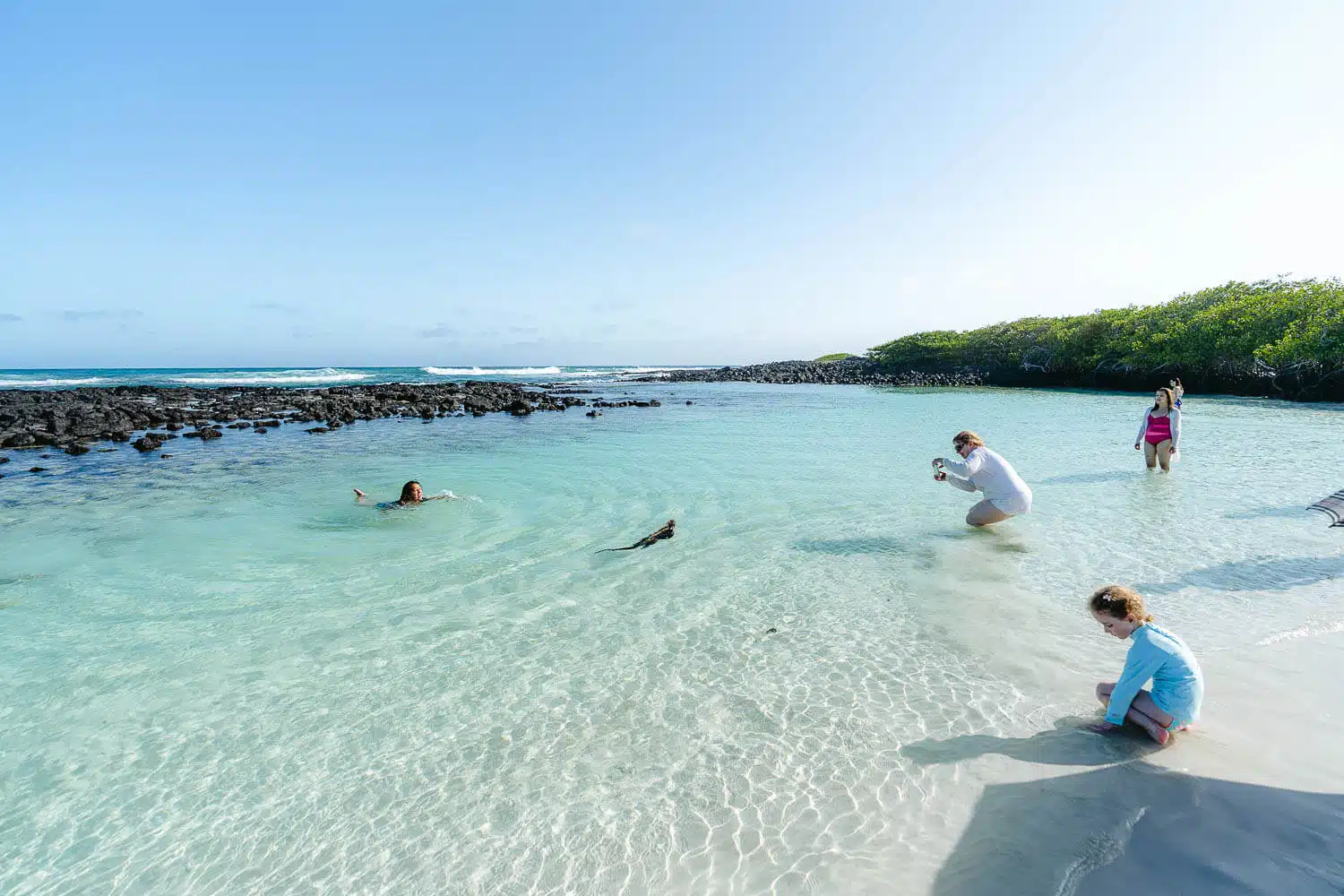
13. El Garrapatero Beach
El Garrapatero is another alternative beach you can go to on Santa Cruz island if you’ve already been to Tortuga Bay. This white-sanded beach has a lagoon next to it usually with many flamingos. On the beach you can swim, kayak, sunbathe and relax. The beach is located 20 km northeast of Puerto Ayora town and to reach it you have to take a taxi and then walk a short path to the beach.
View the full blog post here: EL GARRAPATERO BEACH IN SANTA CRUZ
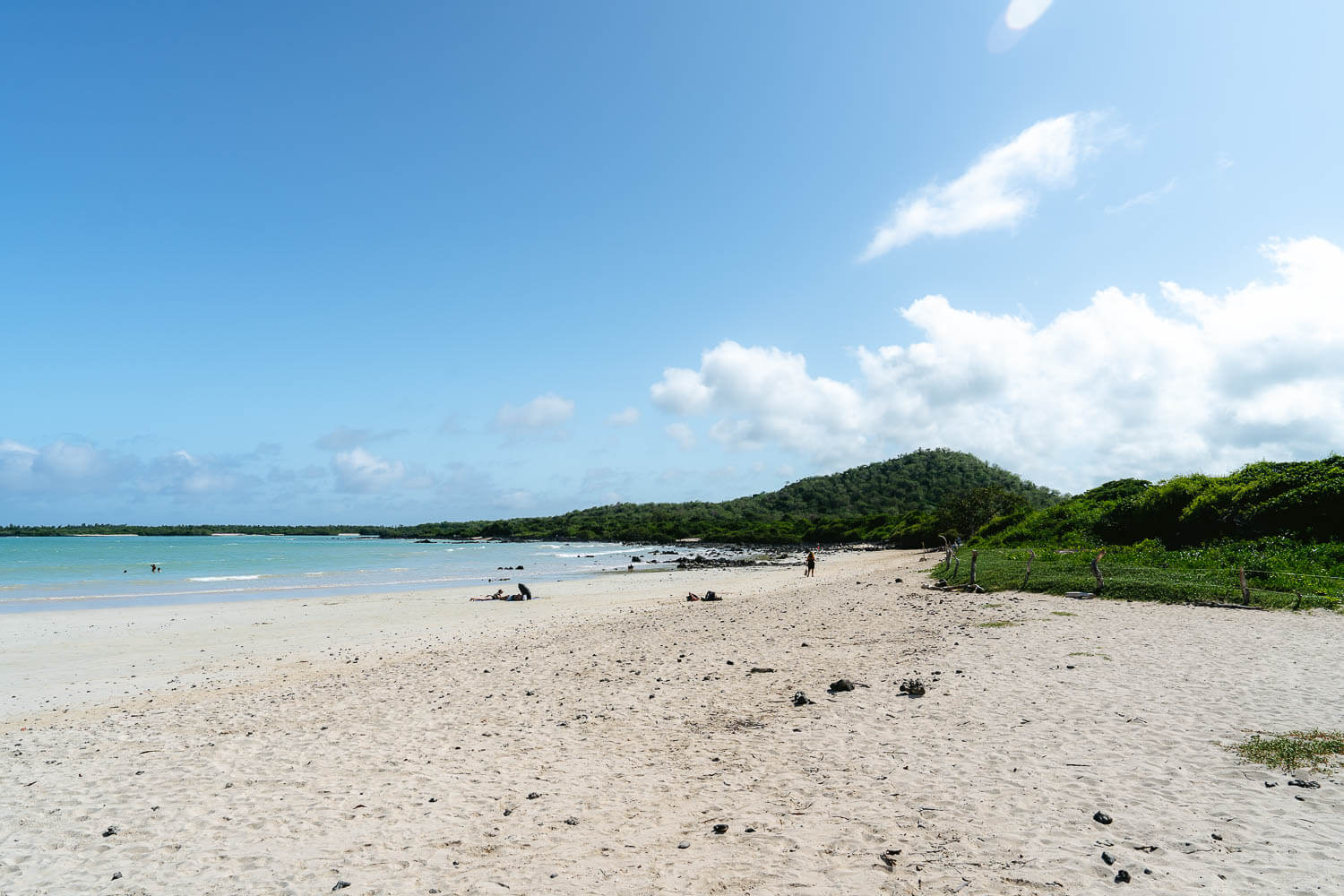
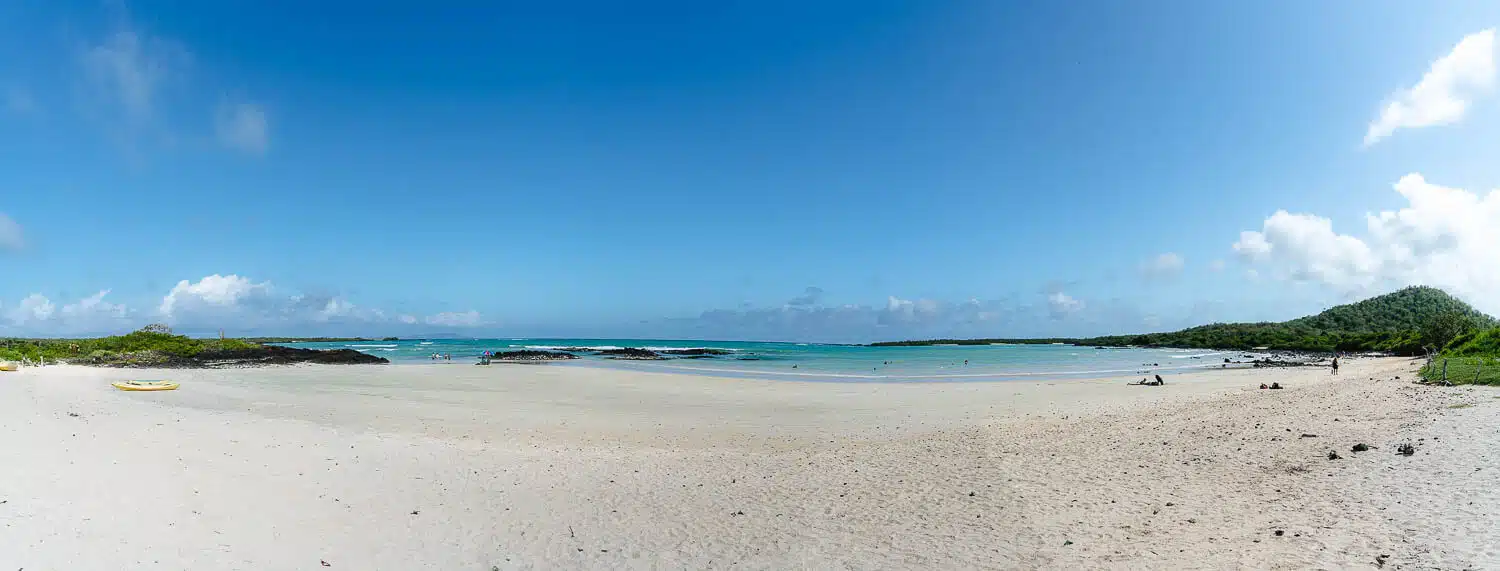
14. Cerro Dragon (Dragon Hill) Tour
The Cerro Dragon or Dragon Hill tour is usually booked with a cruise for its remoteness on the northwestern point of Santa Cruz island. Its main attraction is the multitude of beautiful orange land iguanas and marine iguanas, from where the name Dragon comes from. You will also see many Opuntia giant cacti and probably a lot of flamingos and other birds. On some of the tours you can snorkel and you might see baby reef sharks and sea lions.
Here I’ll leave you some companies whose yachts pass there: Letty by Ecoventura, Celebrity Xpedition by Celebrity Cruises, Explorer II by EQ Touring, La Pinta and Isabela II by Metropolitan Touring.
To book this tour please check with the tour agencies on the island, I couldn’t find any online that I could honestly suggest to you apart from the cruises.
15. Hike to Media Luna, Puntudo and Cerro Crooker Hill
This is probably the only proper wild hike you can do on Santa Cruz island that doesn’t require a tour. You first need to go to Bellavista by taxi and then start your hike uphill to the middle of the island’s highlands. It’s an 8 km hike until the base of Cerro Crooker hill and it should take you around 3 hours each way.
You will have beautiful views over the entire island’s volcanic hills. Here you can see the miconia vegetation of the island and the Galápagos Petrel bird that nests on these mountains. Please don’t go off track as you can destroy some of the nests or get lost.
16. Coffee Tour at "El Trapiche Ecológico Galapagos"
This is probably one of the tastier activities you can do on Santa Cruz island. Yes, there is coffee produced solely in Santa Cruz. I’ll be honest, the coffee I tasted in San Cristobal was tastier than the one from Santa Cruz, but I’m not sure it was from this farm, so maybe their coffee is as amazing as San Cristobal’s one. Give it a try!
To book this tour contact them at:
17. Surf in Santa Cruz
Although San Cristobal is more famous for surfers than Santa Cruz island, there are also incredible spots here for surfing. Accessible by foot you can go to Tortuga Bay, La Ratonera beach, Tres Picos, Playa el Bazan beach, and Piedra Ahogada. Then there are other more remote places that you can only access by boat, like Ola Escondida, Punta Gallina, and Punta Nuñez.
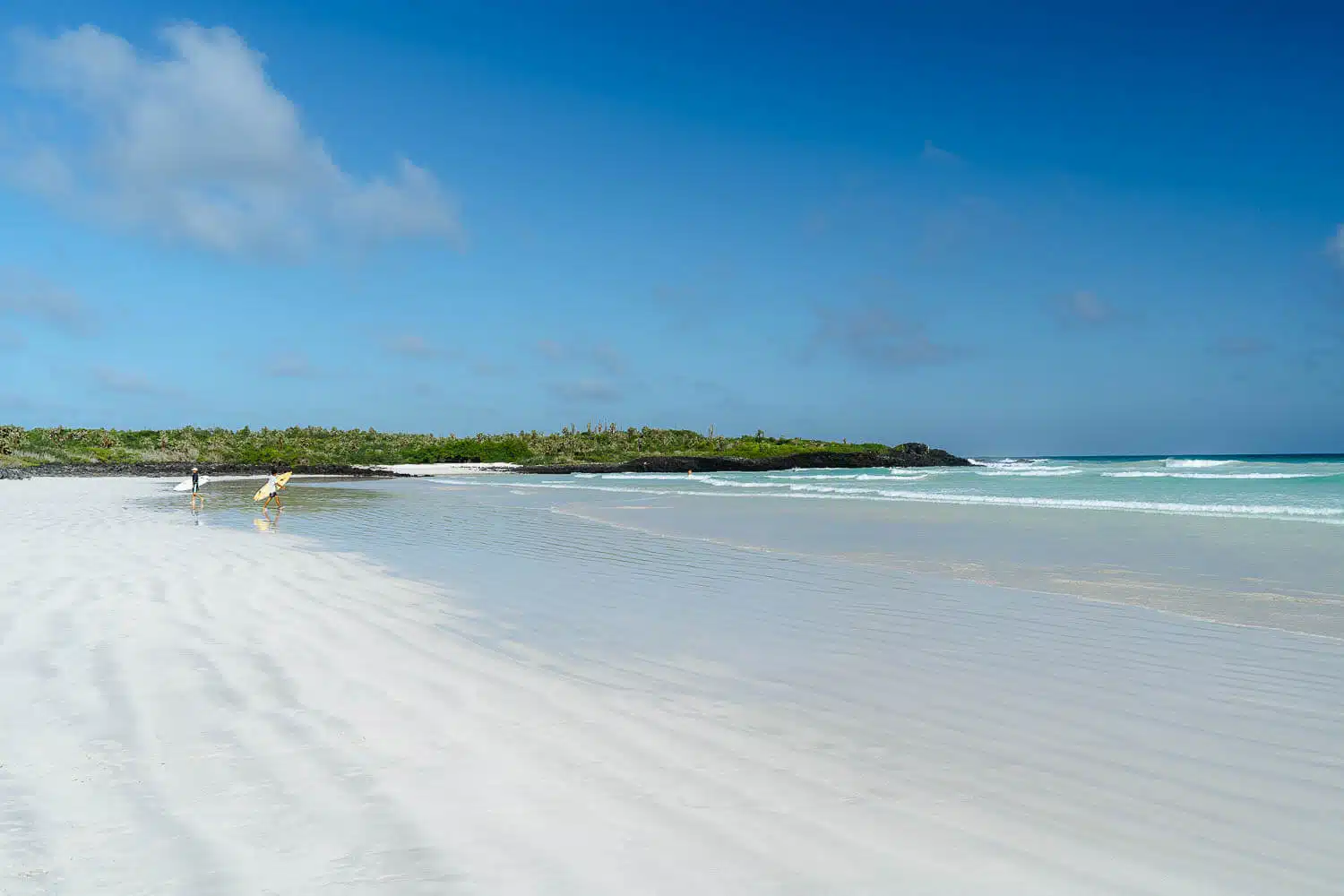
18. Bartolomé Island - Day Trip
The Bartolomé Island Tour is the most iconic tour you can do on the Galapagos islands. You will go on a gorgeous sailing ship starting at Santa Cruz island, passing through the Daphne islands, and arrive at the beautiful Bartolomé island, almost an islet from Santiago island. With luck, you might spot some penguins as we did and then you go snorkeling on one of the paradisiac beaches in the near.
The name of the island comes from Charles Darwin’s friend Bartholomew James Sullivan who was the principal surveyor and second lieutenant aboard the HMS Beagle. Bartolomé is a volcanic tuff islet on the east side of Santiago island. It is the most photographed place in the Galapagos archipelago.
View the full blog post here: BARTOLOMÉ ISLAND TOUR
To book this tour: Check the local company Galapagos Dreams’s website, or book it online on Viator with any of the tours underneath:
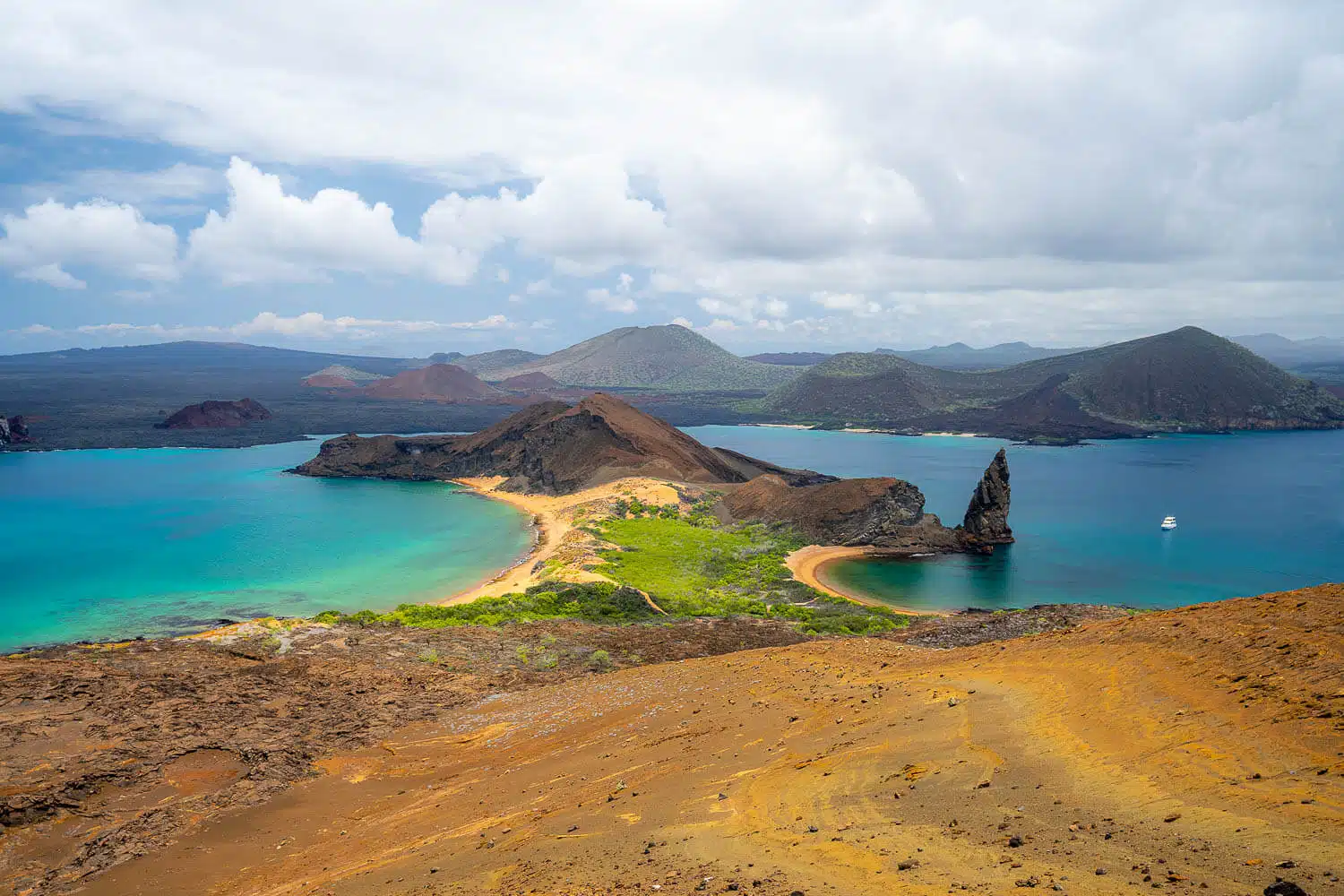
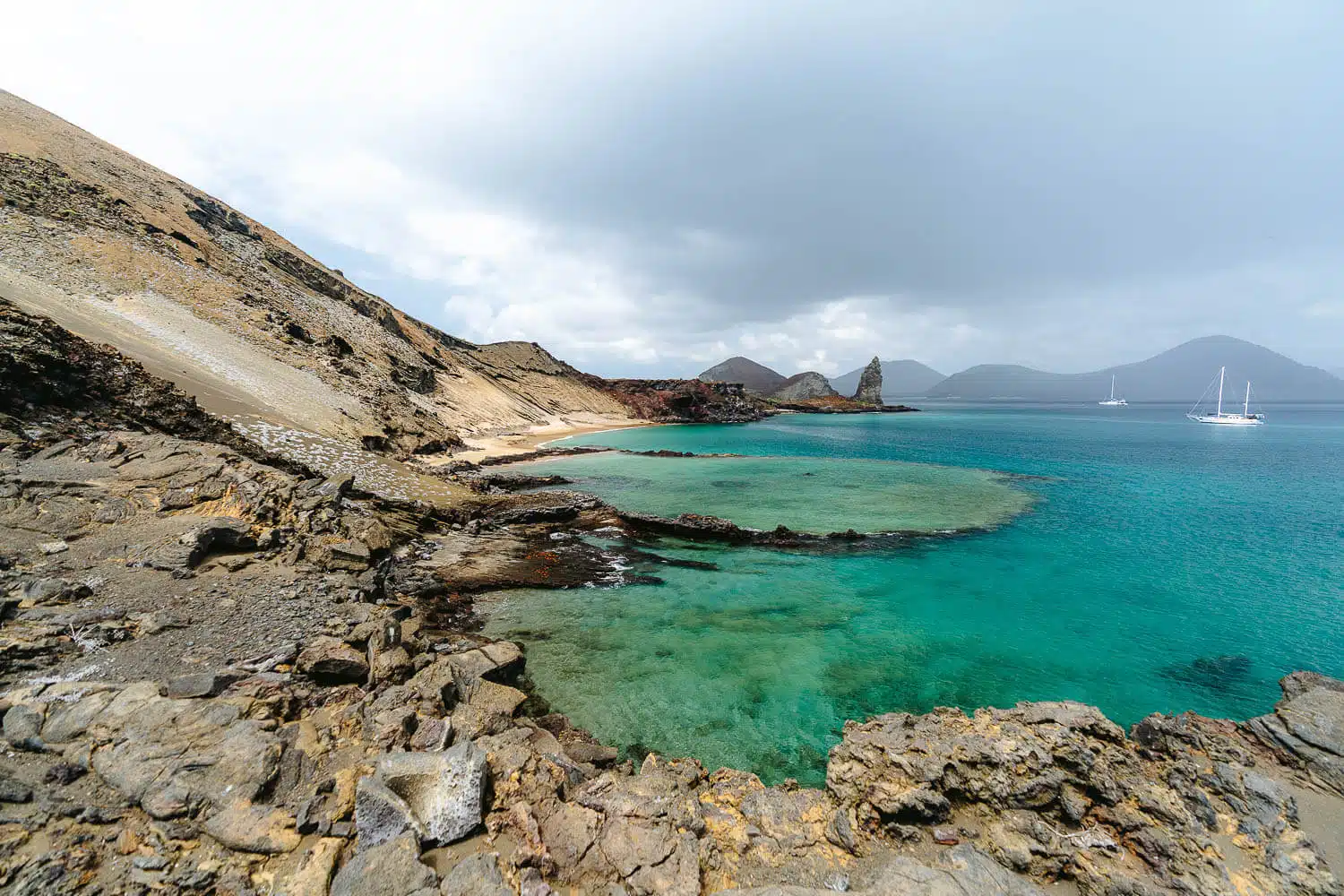
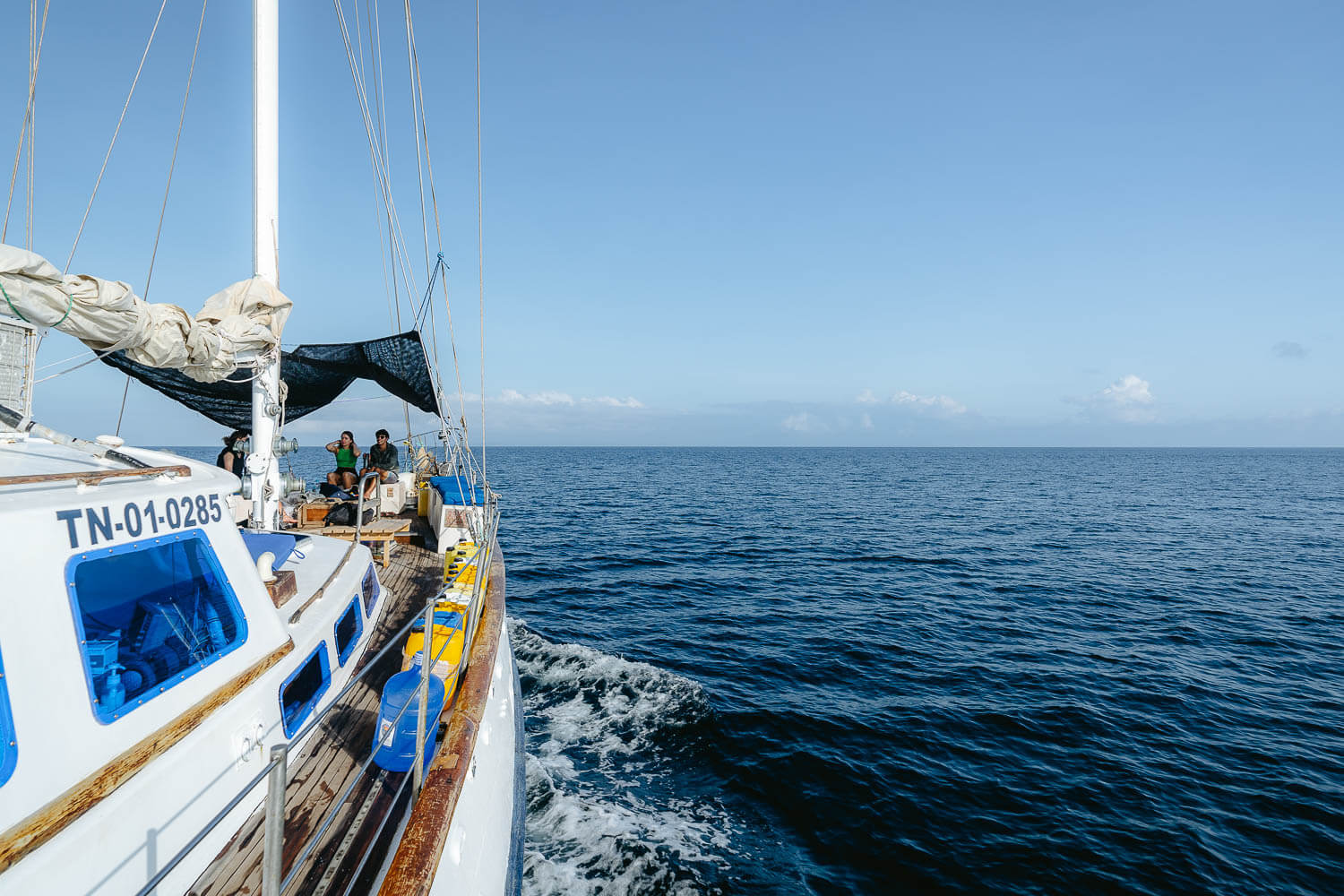
19. North Seymour Island - Day Trip
North Seymour island is located on the north part of Santa Cruz island, over Baltra island (aka South Seymour island). You will see just like in Cerro Dragon hill (on the northern part of Santa Cruz) and on Baltra island, beautiful orange land iguanas, blue-footed boobies, frigate birds, marine iguanas, and probably sea lions.
Both North and South Seymour Islands were named after the British royal navy officer of the late 18th century, Admiral Lord Hugh Seymour. If you’re more fond of scuba diving, I wrote a full article on my dive here that I’ll link underneath.
View the full blog post here: DIVING IN NORTH SEYMOUR AND MOSQUERA
To book this tour: Check the local company Galapagos Dreams’s website, or book it online on Viator with any of the tours underneath:
20. Isabela Island - Day Trip
Isabela island is the third main island of the archipelago and it happens to be the biggest one of the three. If you have time I do recommend you to actually go and sleep there and start your tours from there, Isabela island’s landscape is wonderful. Two-thirds of the island is unoccupied and you can’t visit it unless you go on a National Geographic expedition or some scientific research trip of a sort.
Most of the Isabela day tours include the Tintoreras islets activity, there you will snorkel next to Puerto Villamil town (Isabela’s “capital”) and you will probably see some penguins and reef sharks. Personally, I would suggest you speak to the Galápagos Dreams travel agency and tell them you’d prefer to go to Los Túneles instead of Tintoreras Islets, for there you can see amazing underwater lava structures and wildlife.
They can probably organize it and you pay a little more (the Los Tuneles tour is more expensive and far away than Tintoreras, but is so worth it). If you don’t have the time or don’t want to bother here are a couple of Isabela days tours you can book from Santa Cruz.
To book this tour: Check the local company Galapagos Dreams’s website, or book it online on Viator with any of the tours underneath:
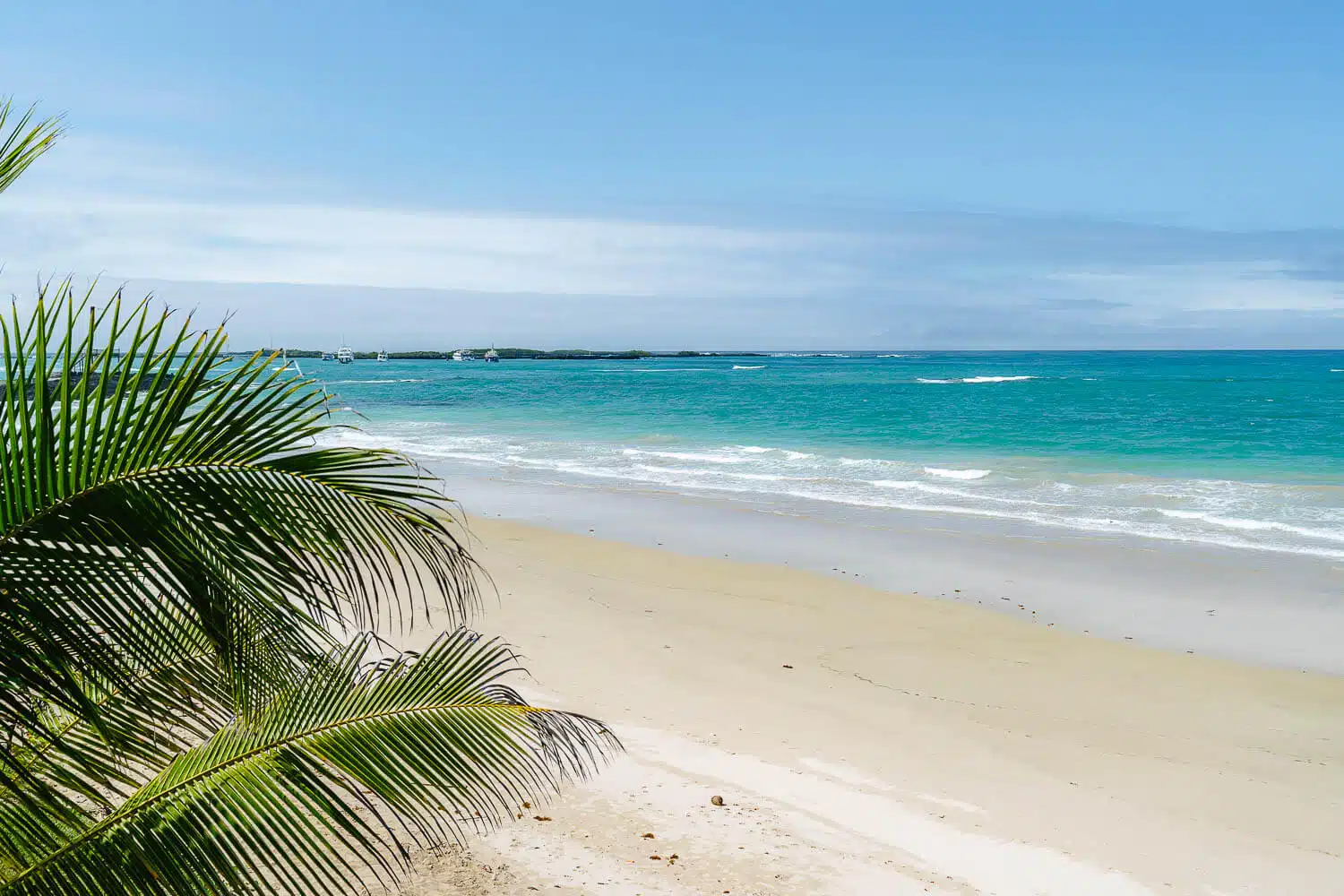
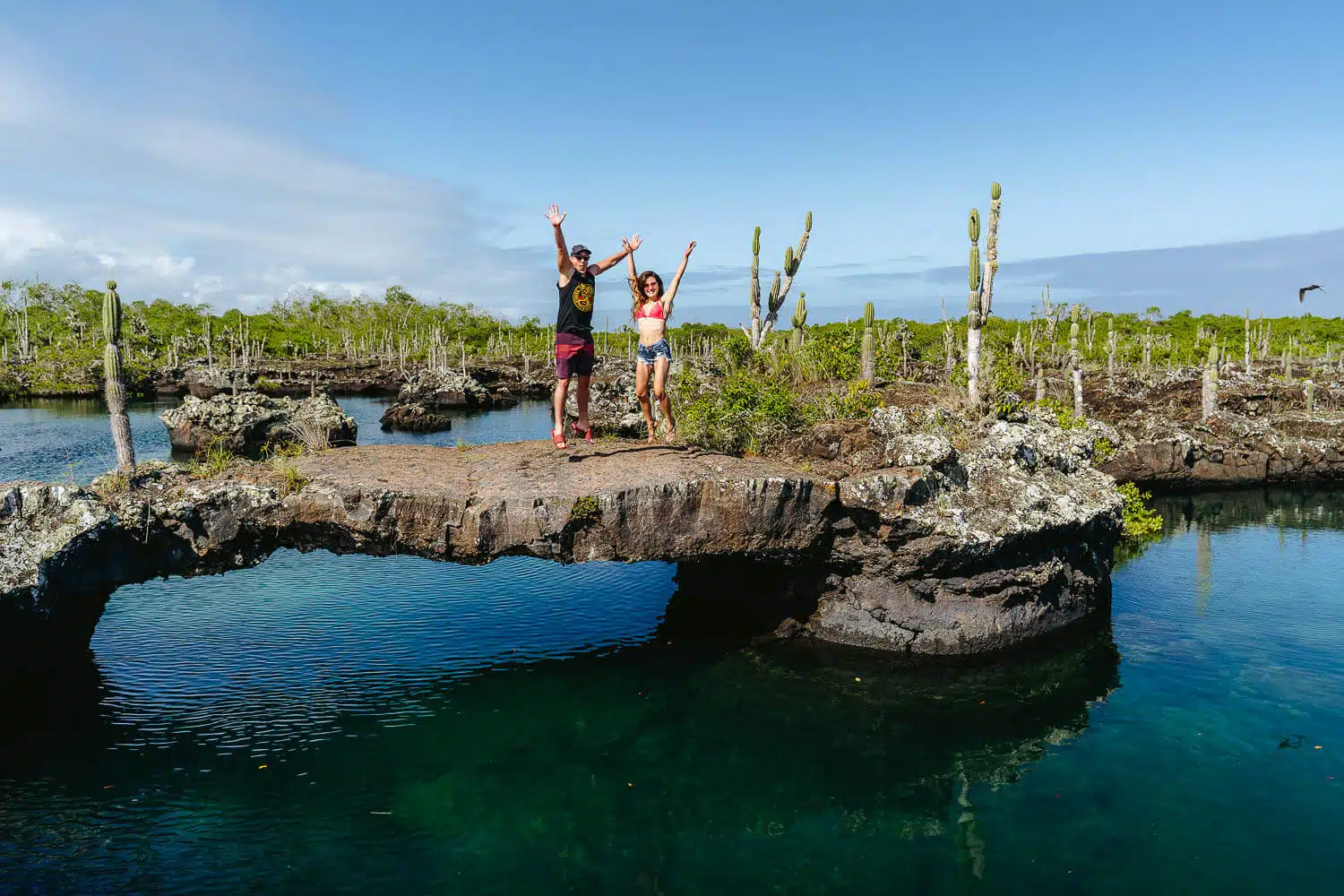
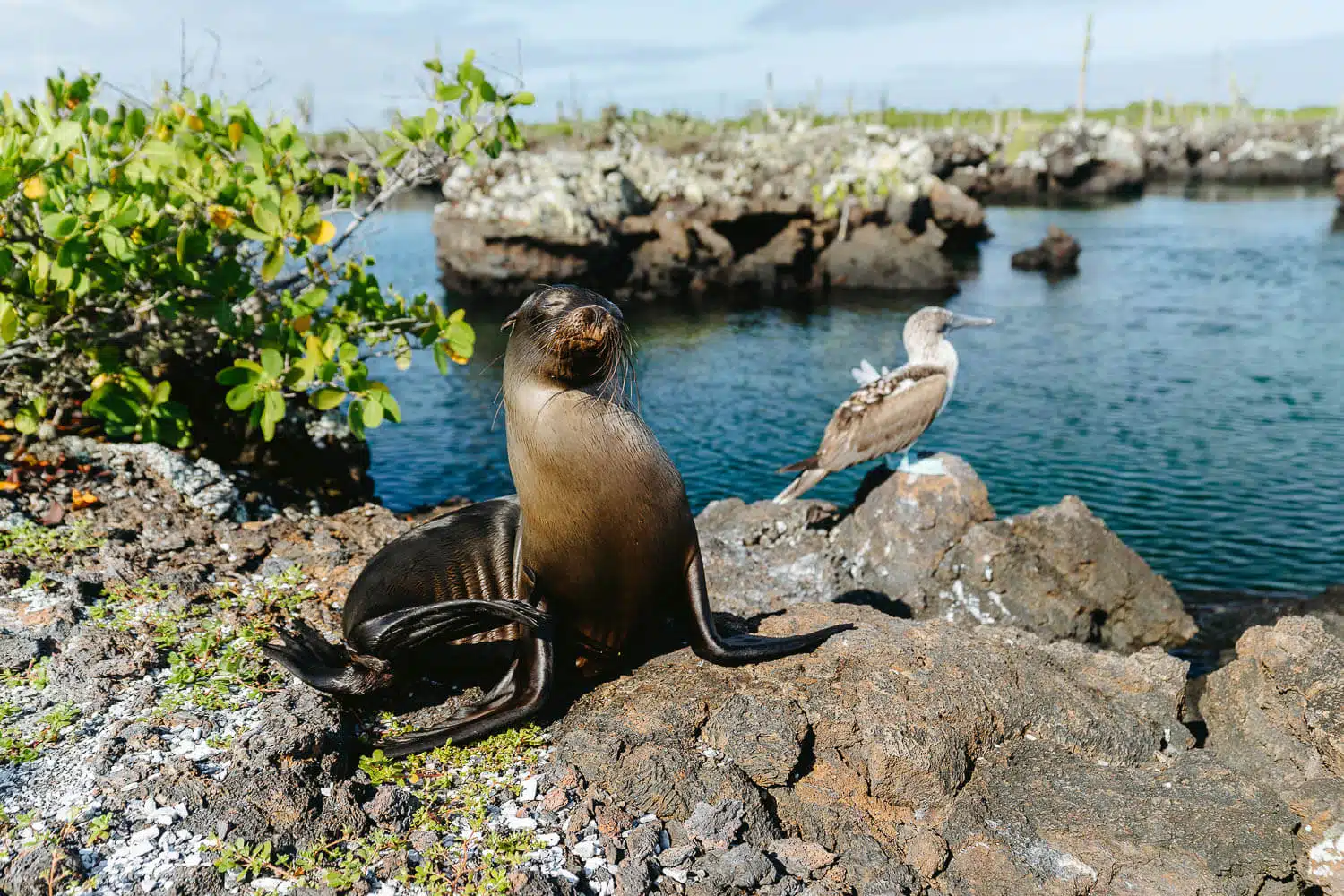
21. Floreana Island - Day Trip
The Floreana Island Tour is the most mysterious and at the same time beautiful tour, you can do on the Galapagos Islands. From tales of piracy, an Austrian baroness and her love trio, a crazy German toothless doctor, and murder this island has it all.
This tour has to be done with an agency or you can alternatively take a boat to Floreana island and spend multiple days there, as there is some infrastructure on the island (not like in Bartolomé Island where you can only visit it on a tour).
The name of the island comes from Ecuador’s first president Juan José Flores, whose administration officially recognized the Galapagos islands as part of Ecuador’s territory. Previously the island was called Charles island (after King Charles II of England) and Santa Maria island (one of Columbus’s caravels). Floreana is the 4th and last island with human settlements in the Galapagos archipelago.
View the full blog post here: FLOREANA ISLAND TOUR
To book this tour: Check the local company Galapagos Dreams’s website, or book it online on Viator with any of the tours underneath:
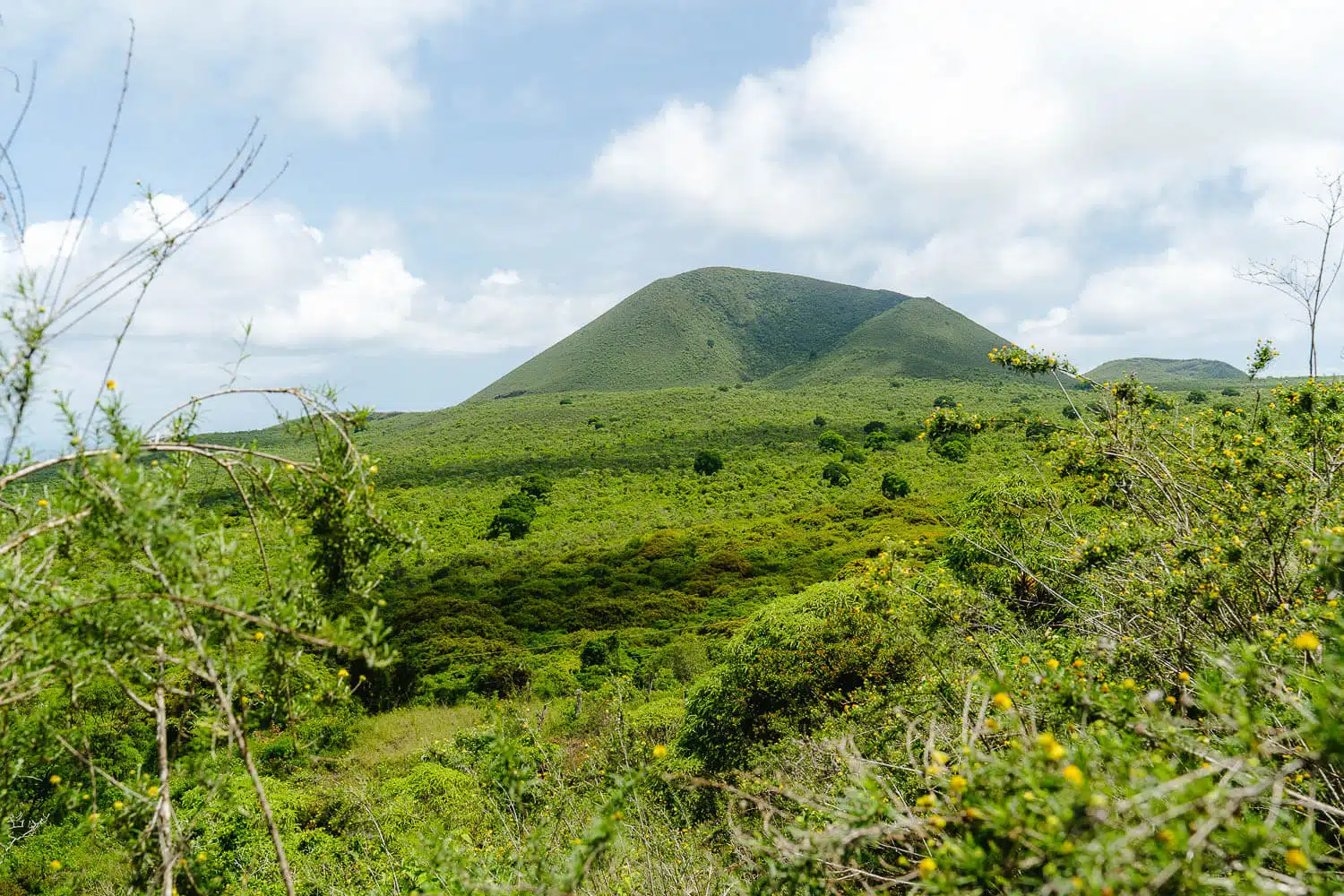
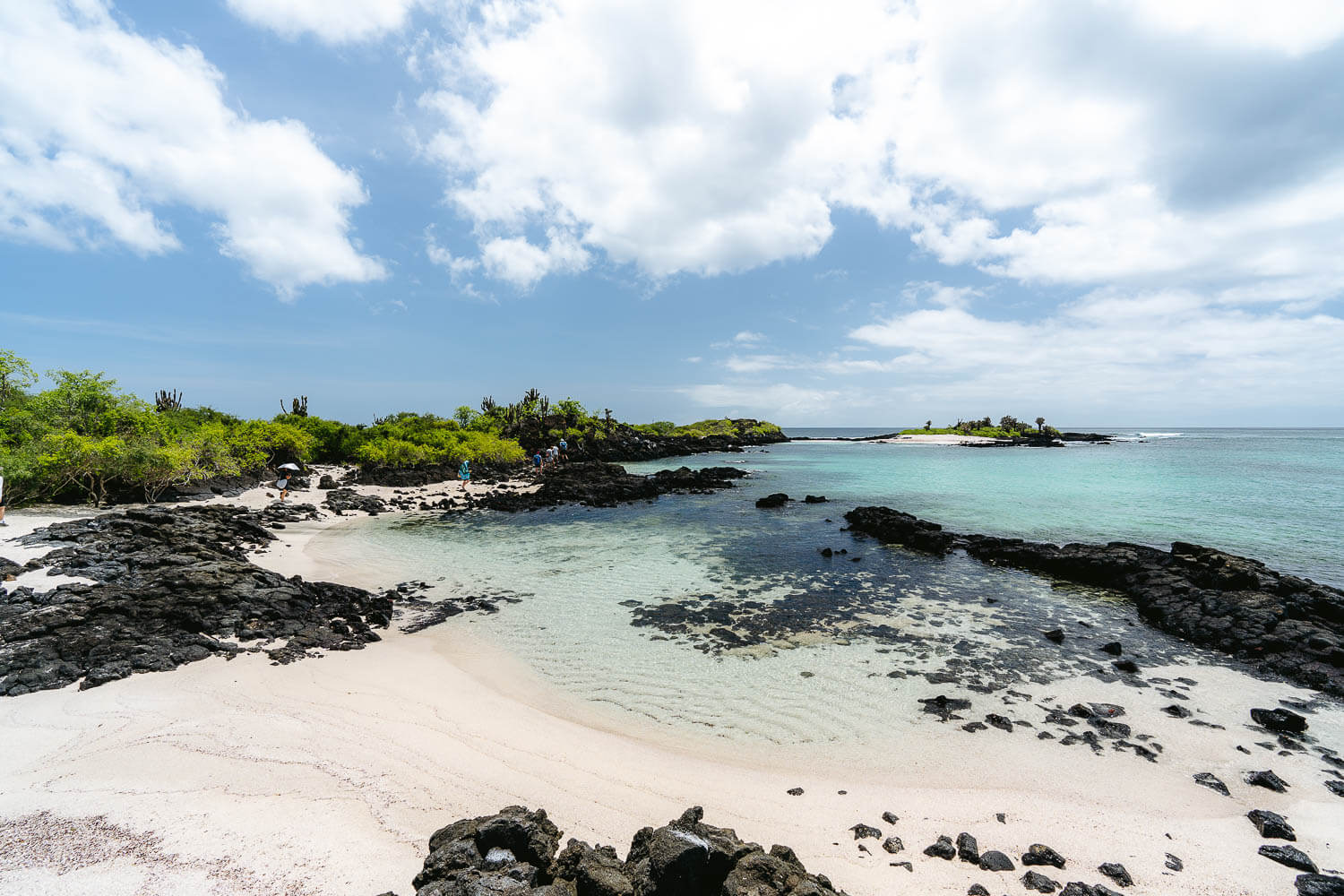
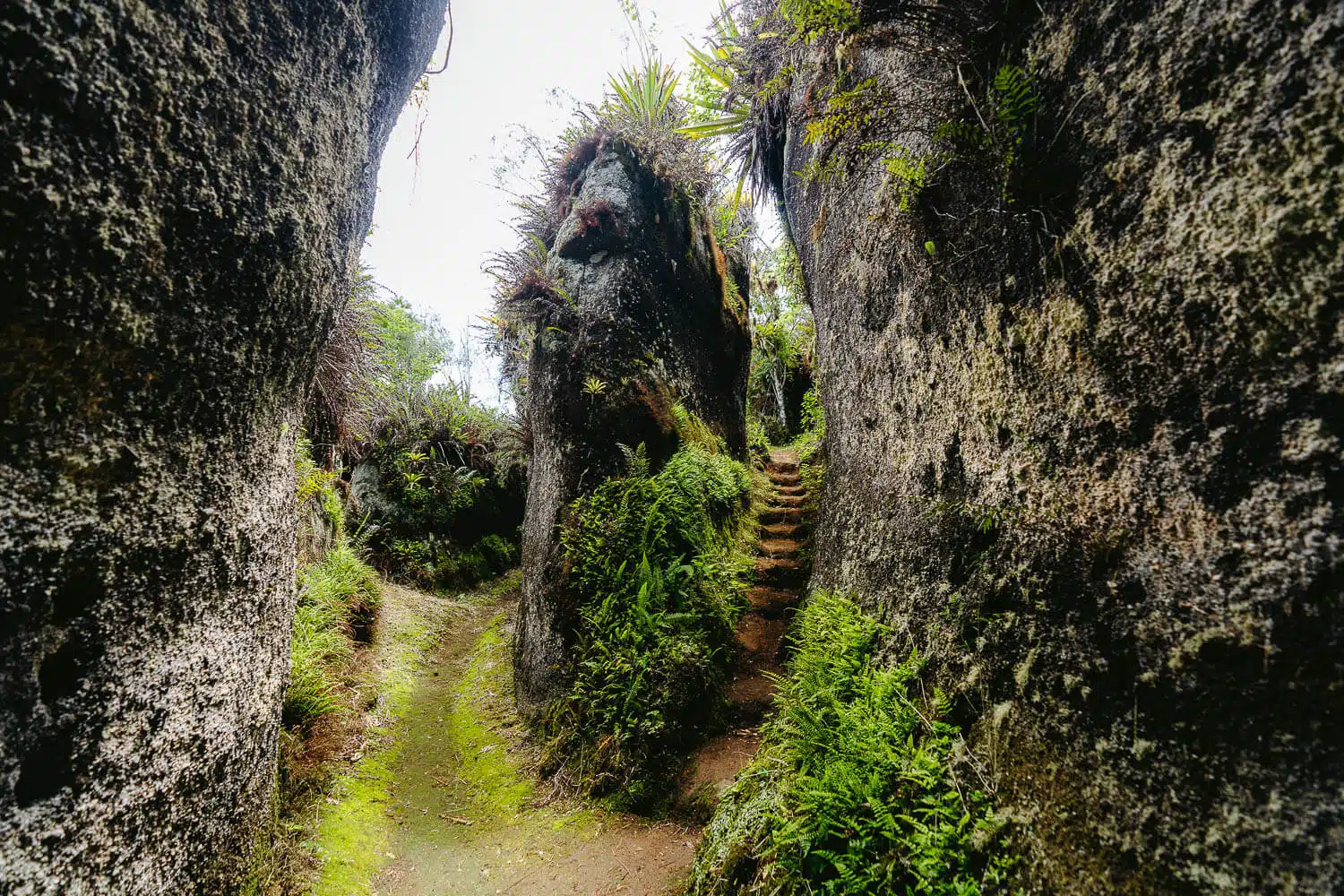
22. Plazas Islets - Day Trip
These are two of the many uninhabited islets in the Galapagos. They were formed by an uplift of the seabed giving it its flat but very unique shape. They are located on the northeastern side of Santa Cruz island.
The visit is in the channel between the North and South Plaza islets, in the part where the islet slopes a little towards the water. There are many opuntia cacti and very beautiful red low-ground vegetation. On this tour, you will see many iguanas, swallow-tailed gulls, and blue-footed boobies. You end up on the tour snorkeling at Punta Carrion where you will see a plenitude of marine life.
To book this tour: Check the local company Galapagos Dreams’s website, or book it online on Viator here: Day Trip to South Plaza Island from Puerto Ayora
23. Santa Fé Island - Day Trip
Santa Fé is one of the biggest islands in the Galapagos and it’s located just 20 km away from Santa Cruz. For that reason, it’s usually part of the daily tours available from Santa Cruz. The island is known for its large colony of sea lions that live on the two beaches and it’s giant opuntia cacti.
You will probably find the endemic Santa Fé island land iguanas (yellow colored), blue-footed boobies, frigatebirds, and other seabirds. After the walk, you can snorkel from the boat and spot amazing marine life. If you’re interested there are also pure snorkeling and scuba diving tours to Santa Fé.
To book this tour: Check the local company Macarron Scuba Divers, or book it online on Viator with any of the tours below:
24. Snorkel in Daphne Mayor Island
On this snorkeling tour, you will go near Daphne Mayor island and to Bahia Borrero. You will find a great concentration of birds and sea lions, as it is a natural fishing area. Here you will have the chance to fish your lunch, if you can’t fish anything there’s always the normal lunch menus available. While snorkeling you might spot eagles and manta rays and also some reef sharks.
To book this tour: Check the local company Galapagos Dreams’s website
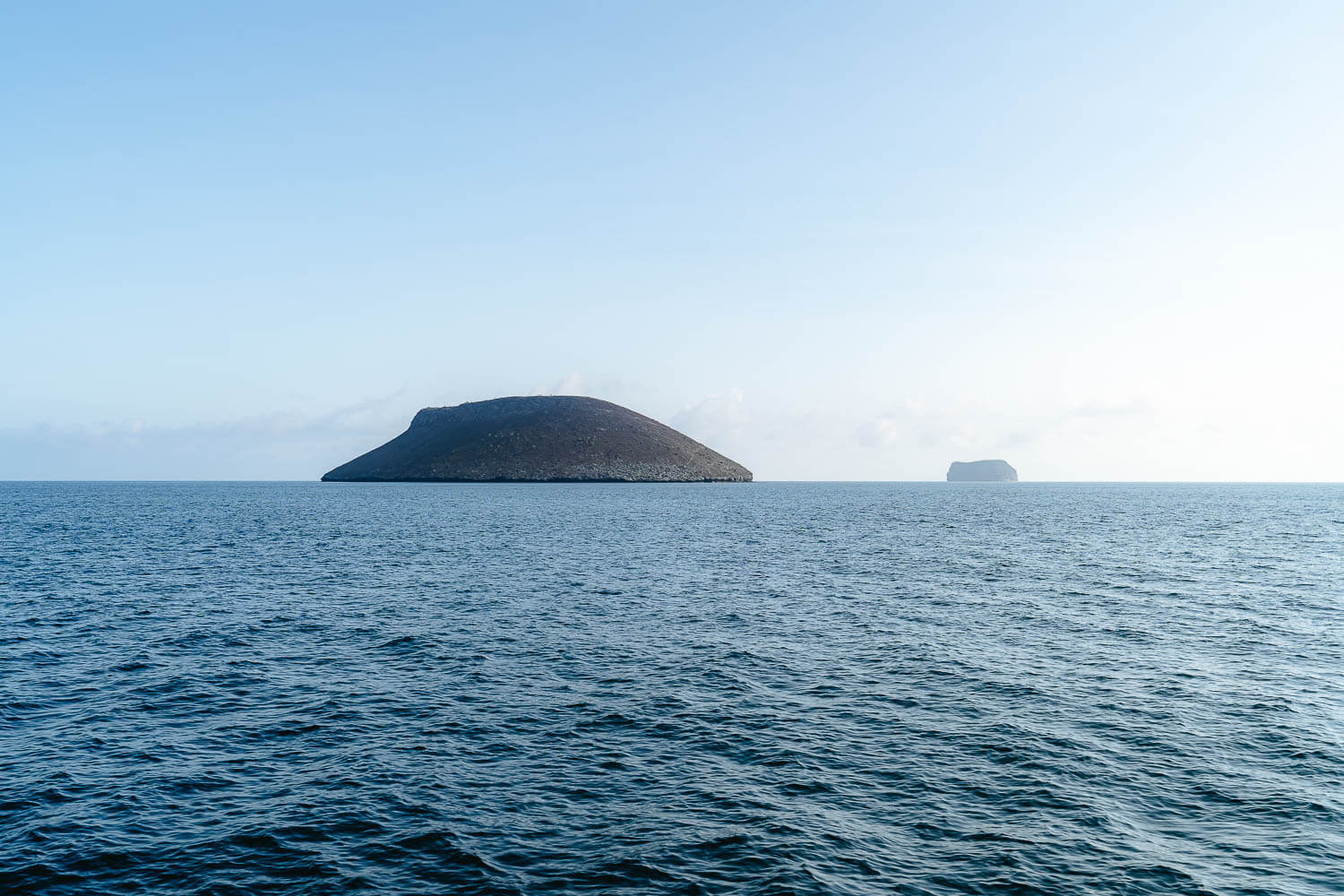
25. Snorkel in Pinzon Island
On this snorkeling tour, you will go to Bahia Pinguino in Pinzon island and then to Dumb islet in the near. On the way back you will go to a beach in Santa Cruz only accessible by boat, called La Fé beach. Pinzon is only possible to visit on a snorkeling tour. And due to its proximity to Santa Cruz, you can find many tour agencies that do it.
While snorkeling in Pinzon you will find on the beautiful clear turquoise water, many tropical fish, baby and adult sea lions, white-tip reef sharks and turtles, usually huge ones, and blue sharks. At La Fé beach you can relax or go snorkeling again. Here you might see marine iguanas, puffer fish, manta rays, and starfish.
To book this tour: Check the local company Galapagos Dreams, or book it online on Viator below:
26. Snorkel in Santa Fé Island
Santa Fé is one of the biggest islands in the Galapagos and it’s located just 20 km away from Santa Cruz. For that reason, it’s usually part of the daily tours available from Santa Cruz. Santa Fé has very calm currents and turquoise water. Here you will be able to swim with sea lions and find starfish, tropical fish, and turtles. With a bit of luck, there might even be manta rays.
In the end, you will visit a hidden beach inside a beautiful bay only accessible by boat where you can relax and take nice photos. If you’re interested there are also land and scuba diving tours to Santa Fé.
To book this tour: Check the local company Galapagos Dreams’s website, or book it online on Viator with any of the tours underneath:
27. Dive in Gordon Rocks
Diving in Gordon Rocks is the best dive you can do in Santa Cruz island if you want to see Hammerhead Sharks. Gordon Rocks are the third most famous dive in the entire archipelago. Only slightly shadowed by the liveaboard experience of Darwin and Wolf’s islands, which cost a small fortune, and the Dive in Kicker Rock, starting from San Cristobal island.
It’s one of the top dives in the world and it’s on the bucket list for many underwater aficionados. As a diver myself, if I’d leave the Galapagos without seeing a hammerhead shark I would be disappointed. This is where I saw my first ten hammerheads and my first manta rays.
View the full blog post here: DIVING IN GORDON ROCKS
To book this tour: Check the local company Macarron Scuba Diver’s website, or book it online on Viator here: Daily diving tour in Gordon Rocks
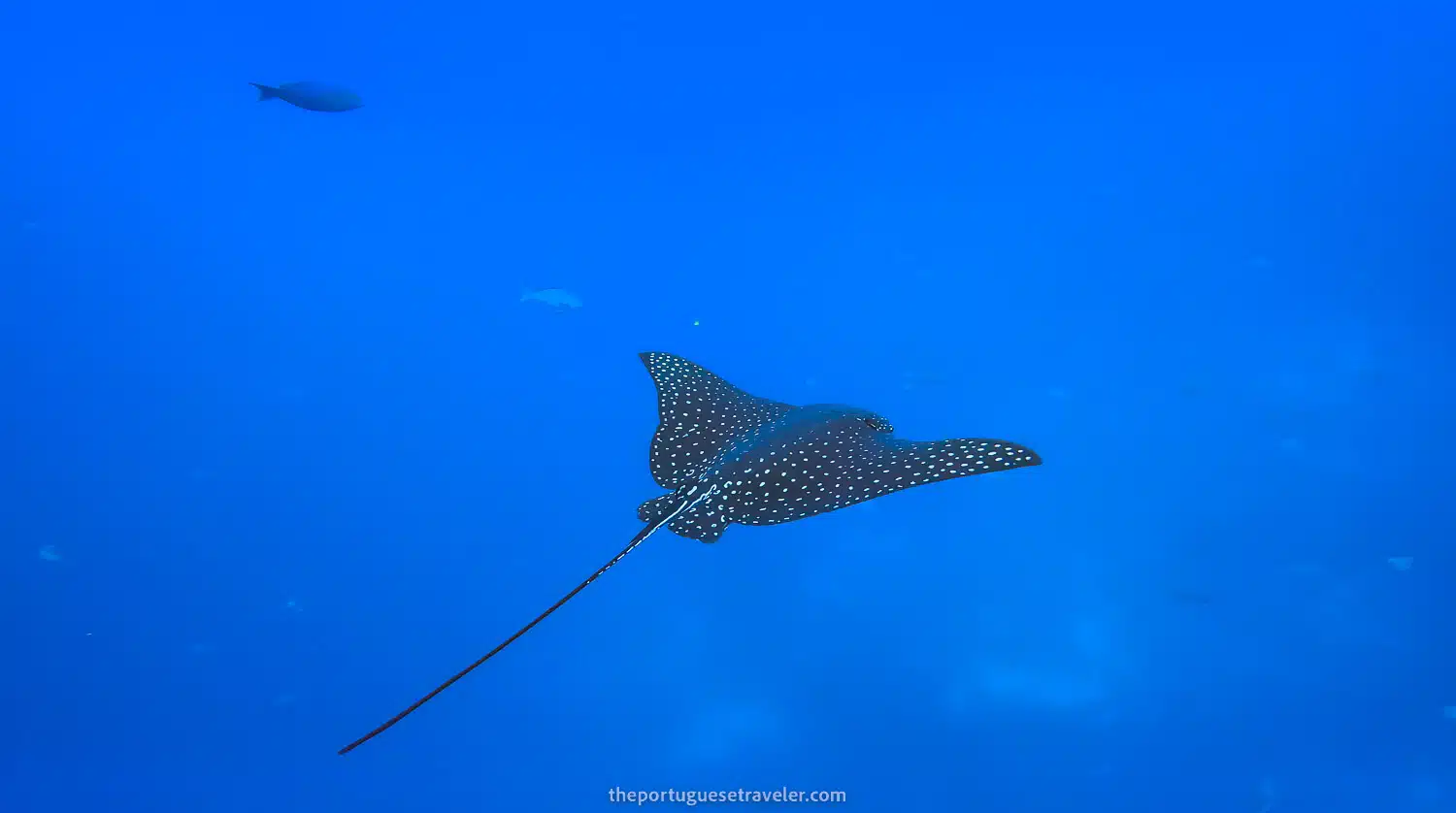
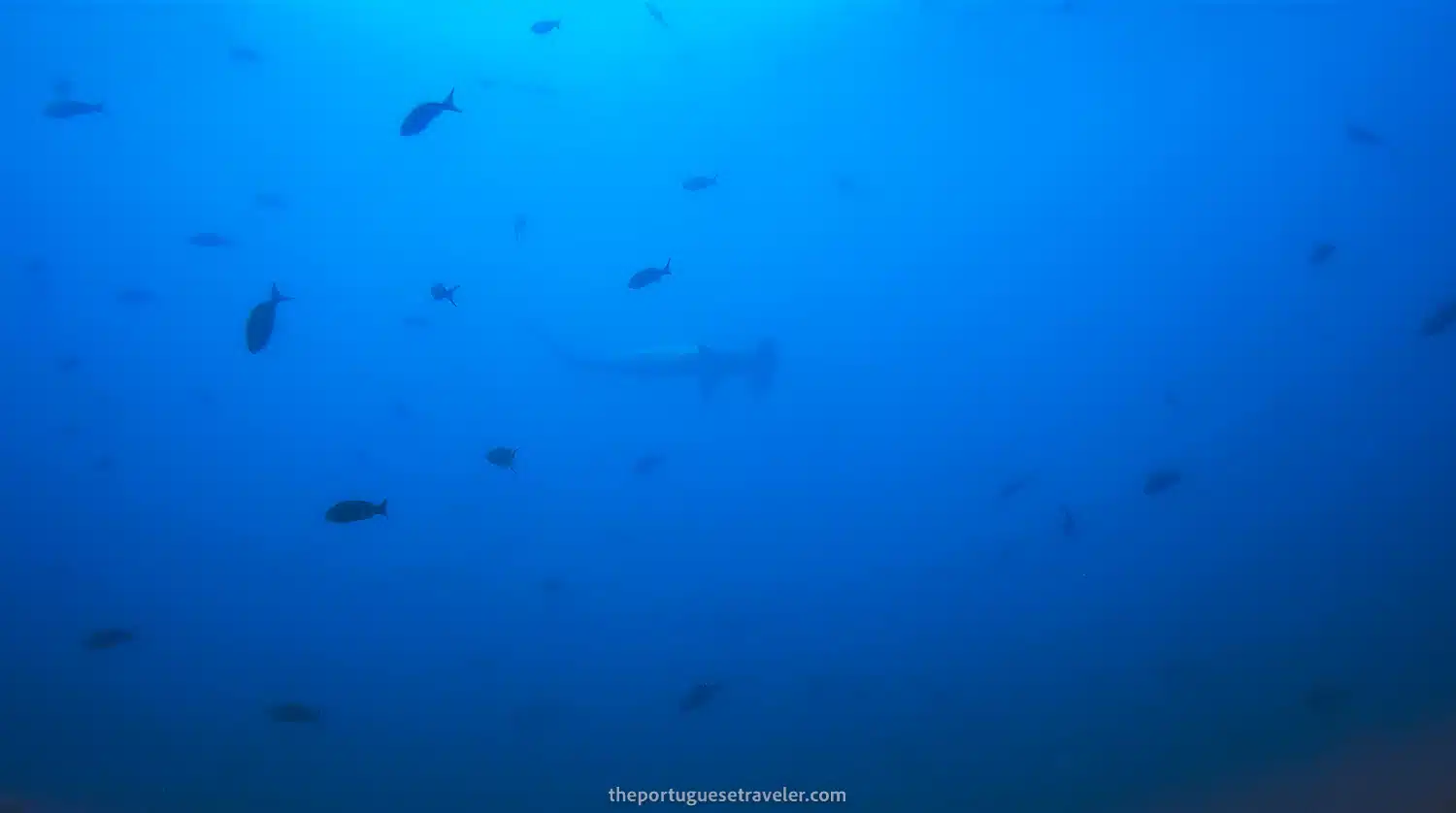
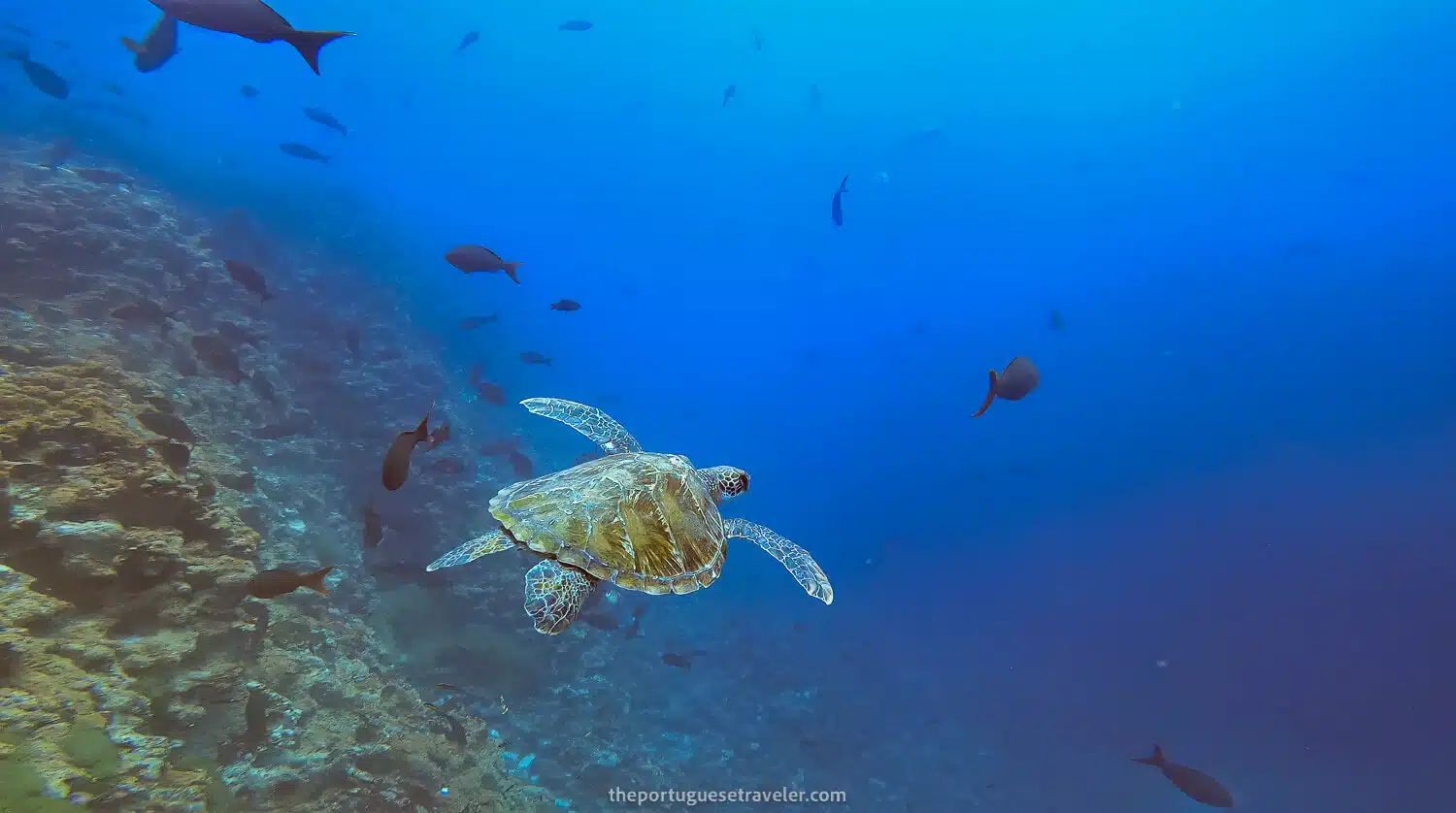
28. Dive in Punta Carrion
This dive site is just one hour east of the Itabaca channel. It is the northernest point of Santa Cruz island. Here there are usually no strong currents and for that reason, it is a very nice site for divers from all levels. You have a great chance of diving together with playful baby sea lions and with a tad of luck, you will find sea turtles, eagle rays, hammerheads, and dolphins.
To book this tour: Check the local company Macarron Scuba Diver’s website
29. Dive in North Seymour Island
The North Seymour dive site is usually combined together with other islets in the near like, Mosquera or Daphne Minor. North Seymour island is located on the north part of Santa Cruz island, over Baltra island (aka South Seymour island).
Both North and South Seymour Islands were named after the British royal navy officer of the late 18th century, Admiral Lord Hugh Seymour. In North Seymour, you can find an eel garden, some reef sharks resting on the sandy bottom, and morays. If you’re lucky some eagle and manta rays, and some Hammerhead sharks might pass near (i saw a hammerhead there). North Seymour is usually the check dive before the other islets where strong currents are more common.
View the full blog post here: DIVING IN NORTH SEYMOUR AND MOSQUERA
To book this tour: Check the local company Macarron Scuba Diver’s website
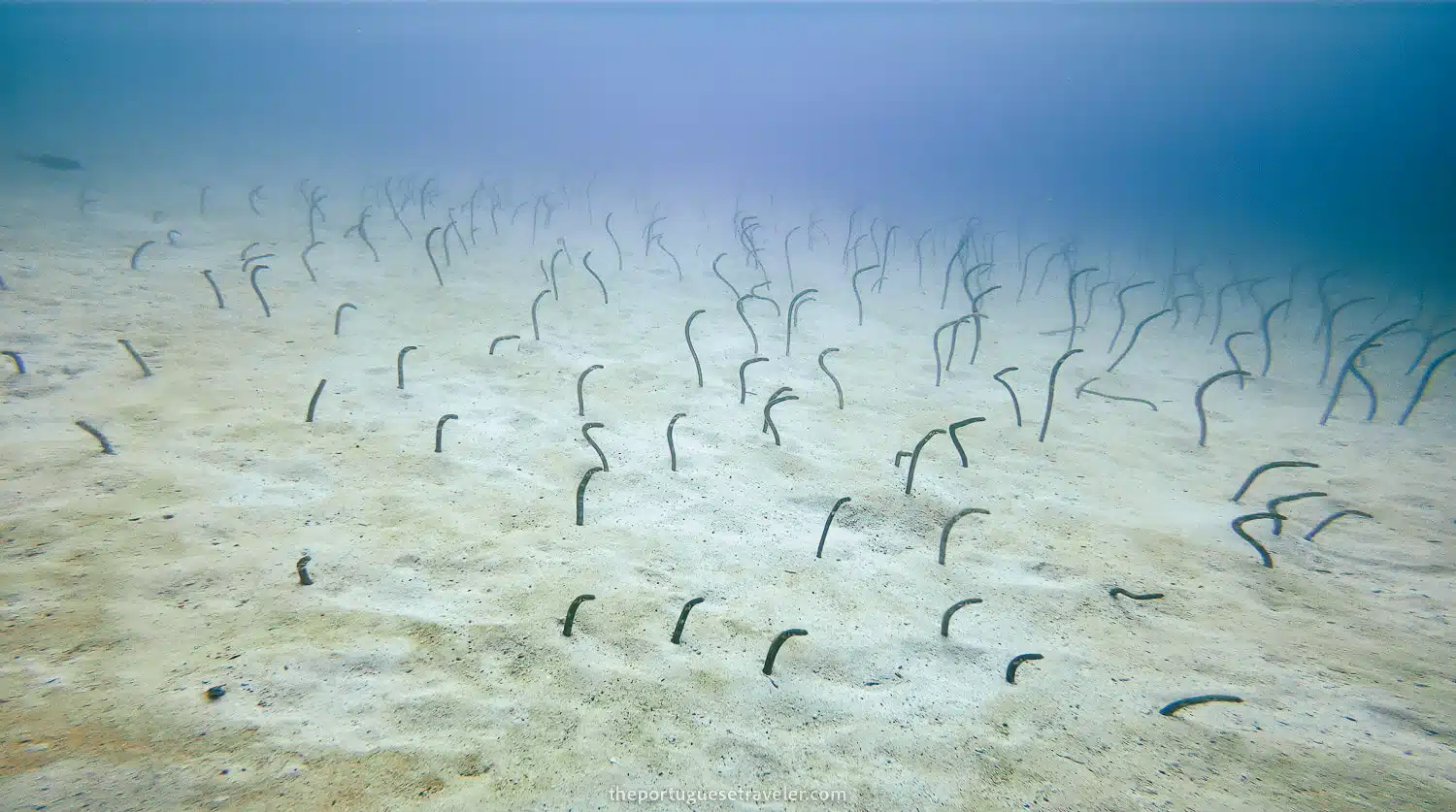
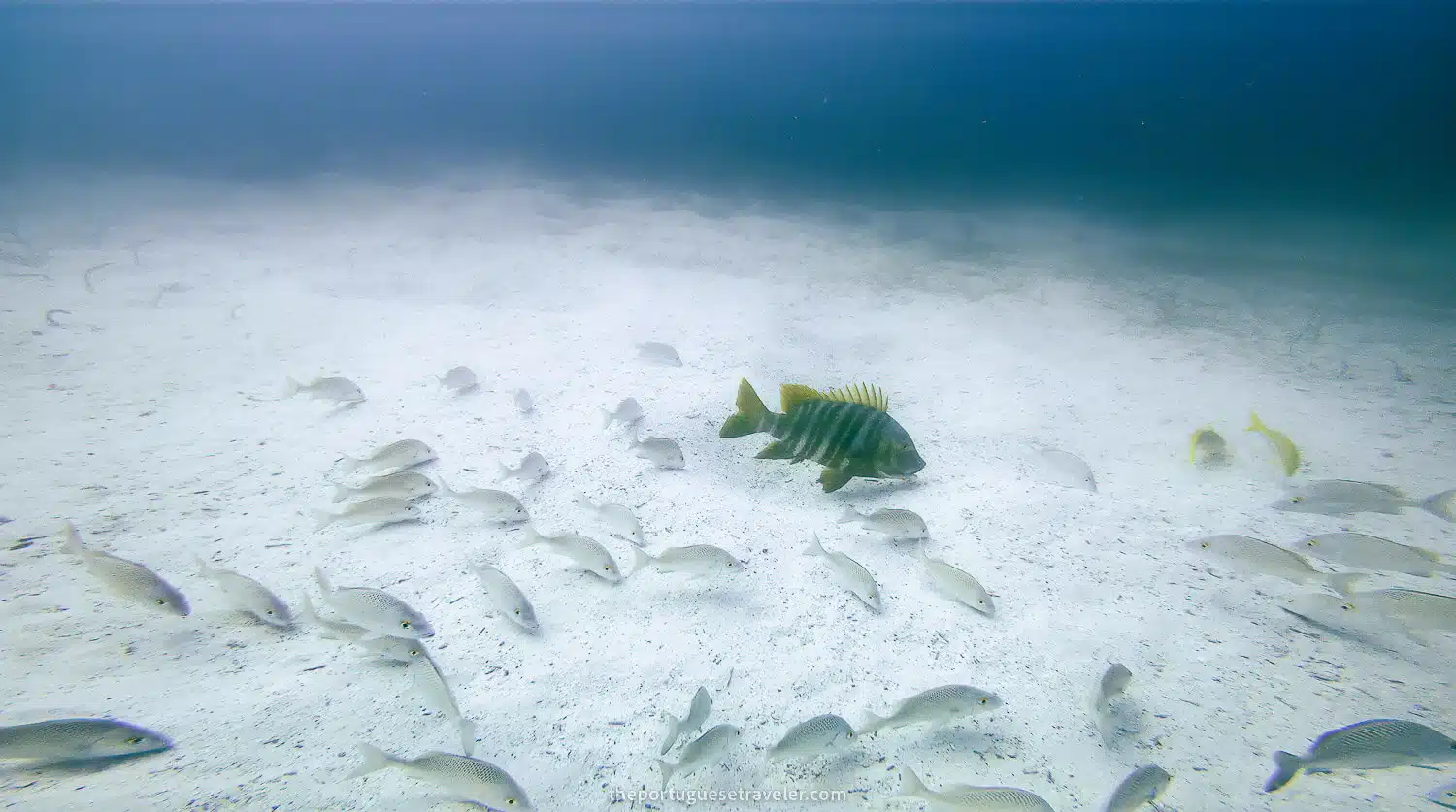
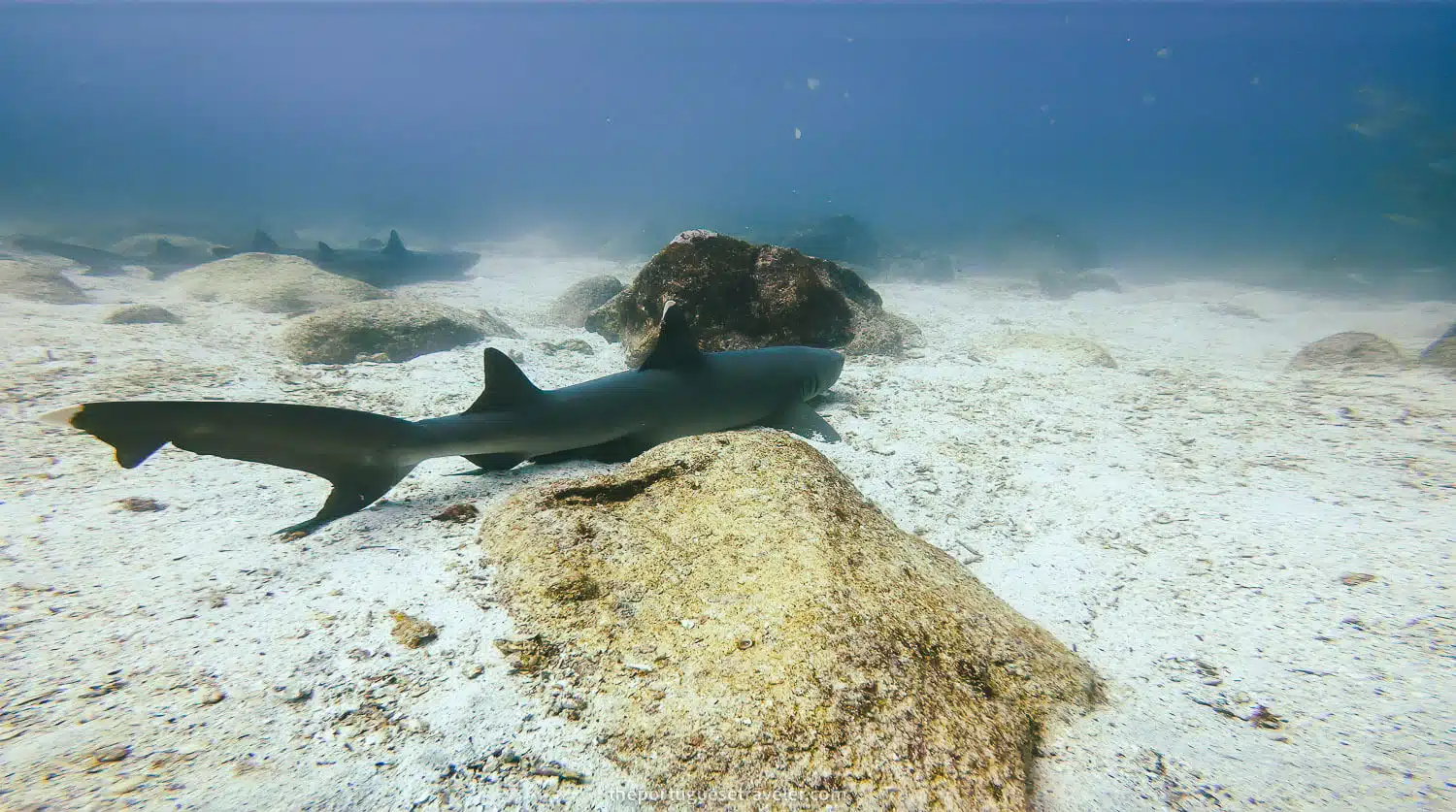
30. Dive in Mosquera Islet
Mosquera islet is located north of Santa Cruz island, in between the North and South Seymour islands. The name “Mosquera” comes from the Spanish and it is the name of a flower in the daisy family, the yellow fleabane flower. It is a dive where there are usually strong currents.
In Mosquera, you will for sure see a reef shark cleaning station and a sea of starfish. If you’re lucky you might spot hammerhead sharks, green turtles, eagle rays, manta rays, golden cownose rays (we saw a group of 15), giant puffer fish, king angelfish, blue and gold snappers, razor surgeonfish, and other exotic fish. Totally a dive you should do if you’ve already done the Gordon Rock dive. Here you will have a lot of diversity and fun.
View the full blog post here: DIVING IN NORTH SEYMOUR AND MOSQUERA
To book this tour: Check the local company Macarron Scuba Diver’s website.
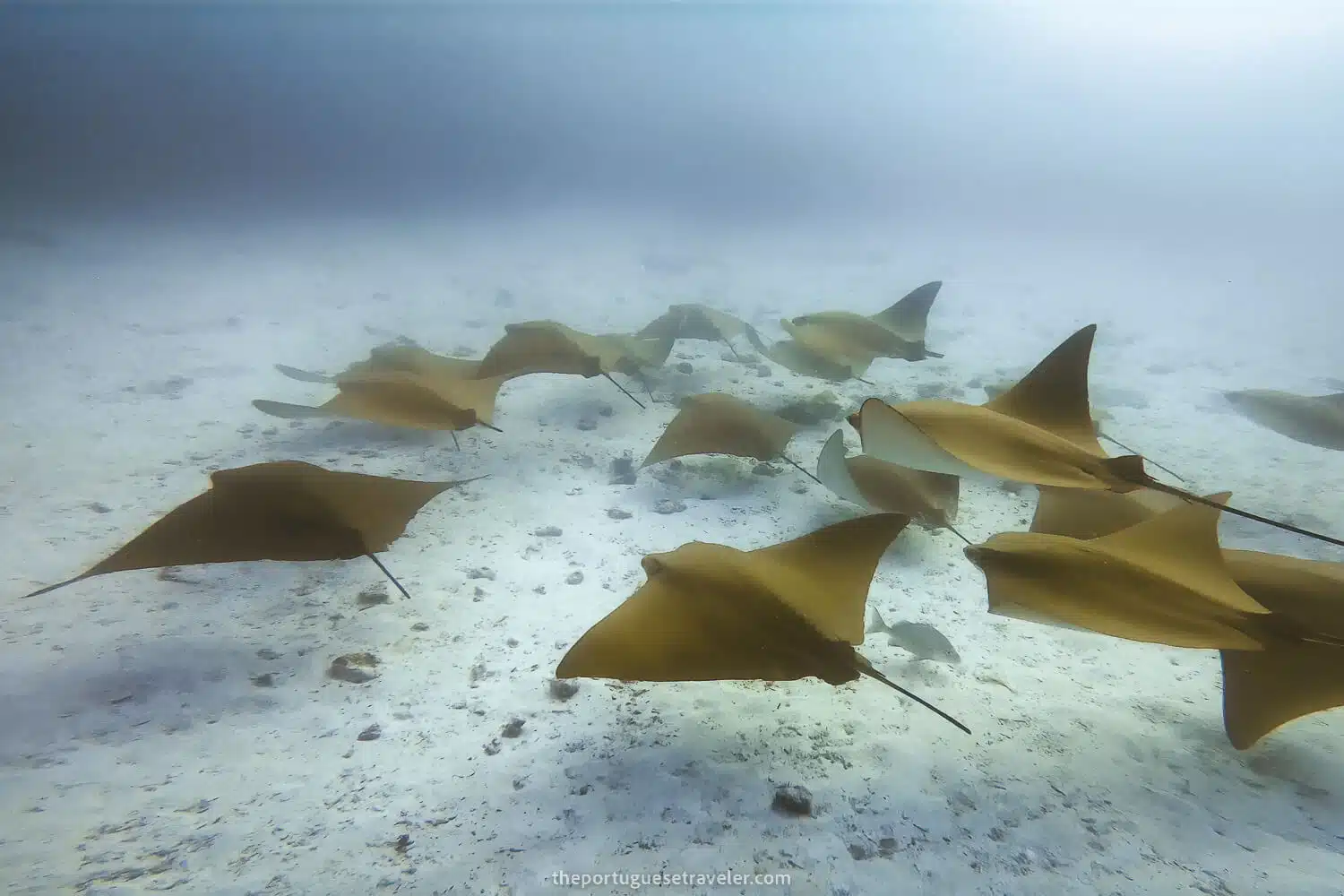
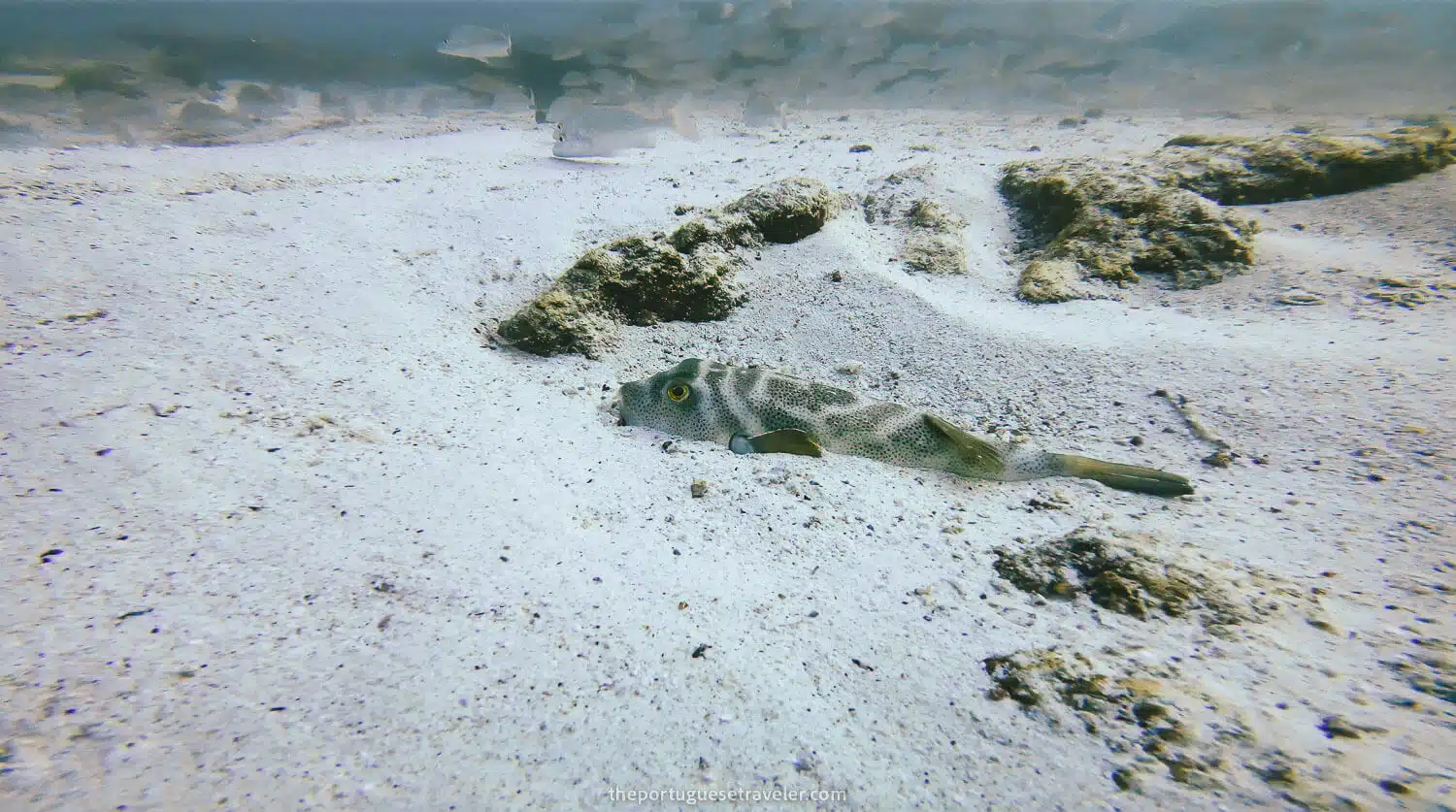
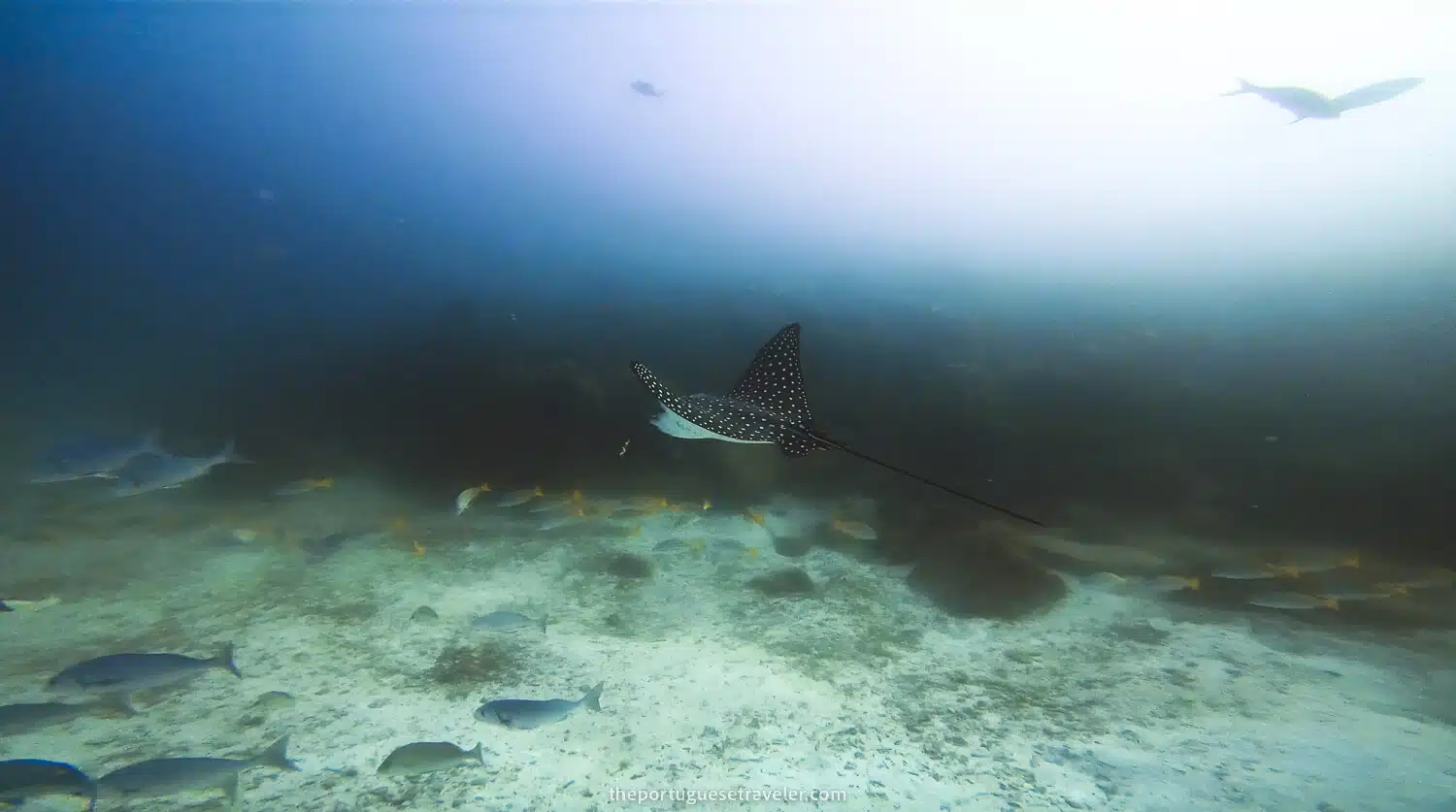
31. Dive in Bartolomé Island and Cousin Rock
Bartolomé Island is the most iconic photo you can have of the Galapagos islands and it is located northwest of Santa Cruz island. Bartolomé is a volcanic tuff islet on the east side of Santiago island. The journey there takes 90 minutes by speedboat and two hours by sailing boat (like on the day land tour).
The name of the island comes from Charles Darwin’s friend Bartholomew James Sullivan who was the principal surveyor and second lieutenant aboard the HMS Beagle. As in the land tour, you could spot some penguins, here you might swim with them and also spot some starfish.
Here as in many places in the Galapagos, you will be able to see reef sharks, and tropical reef fish such as the yellow-tailed surgeonfish, with luck you might spot some mobulas, rays, seahorses, and other sharks. It is a great tour to do a two-in-one check, the only hiccup is not climbing to the viewpoint for the most iconic perspective of the island. On this tour, you will also dive at the Cousin Rock dive site.
To book this tour: Check the local company Macarron Scuba Diver’s website.
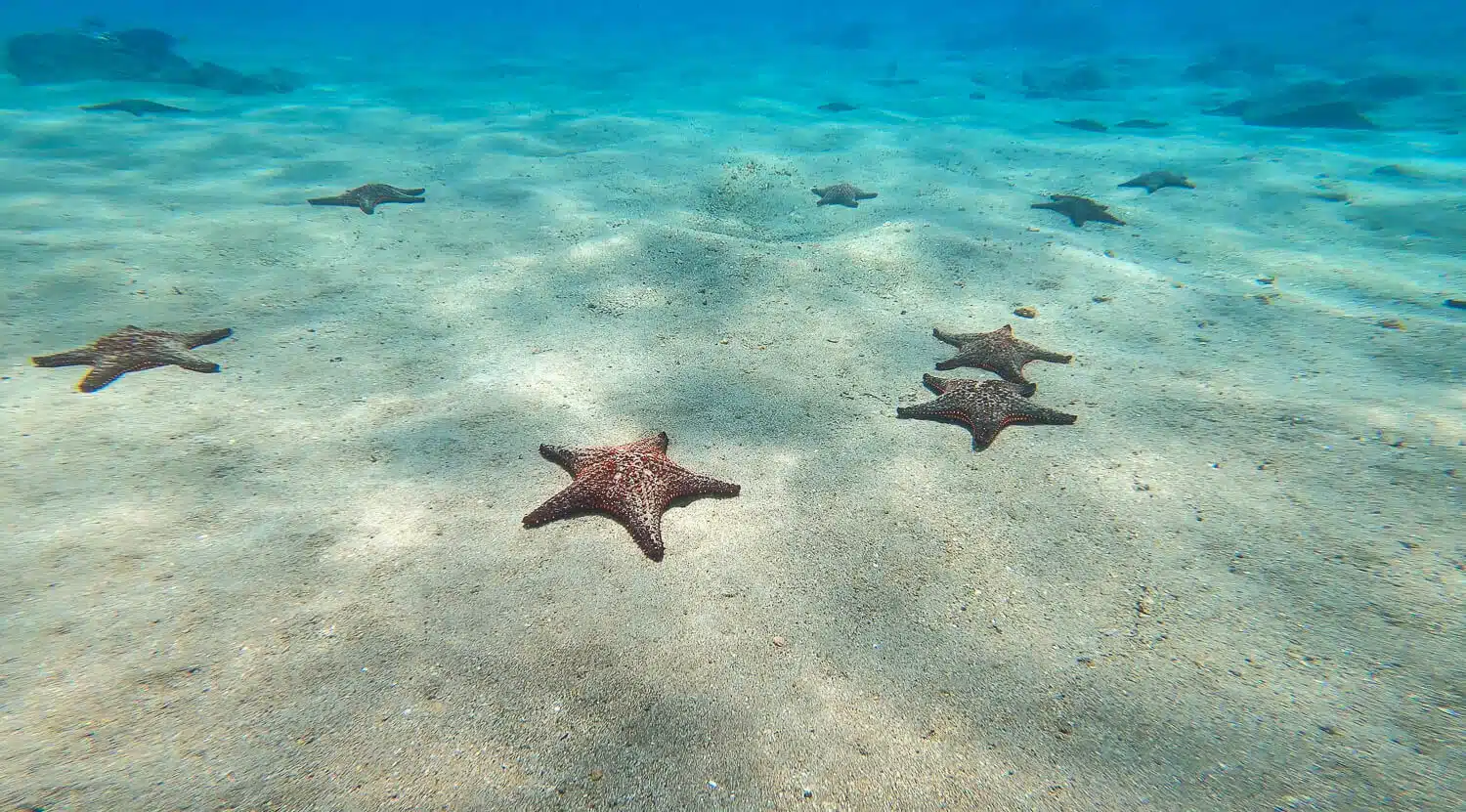
32. Dive in Daphne Islands
There are three main dive sites in the Daphne islands, Daphne Mayor (10-40m depth), Daphne Minor (5-30m depth), and Bajo de Daphne (5-25m depth). The diving tour in Daphne Islands is usually combined together with a dive in North Seymour or Mosquera islet.
Depending on your dive site you might find a small cave (not a cave dive) with reef sharks, a pinnacle with a variety of rays, Galapagos sharks, green turtles, tropical fish, and schools of barracudas, among other animals. If you are not a certified diver there is also a snorkeling tour available where you fish your own lunch and can spot many seabirds fishing with sea lions.
To book this tour: Check the local company Macarron Scuba Diver’s website.
33. Dive in Floreana Island
On Floreana, you can scuba-dive in four different sites, Punta Cormoran, Enderby islet, Devil’s Crown islet, and Champion islet. At Punta Cormoran the main attractions are batfish, golden rays, Galapagos sharks, barracudas, eagle rays, and green turtles.
In Enderby, the dives take place at the extreme edge where the currents hit the reef and if you’re extremely lucky you might find Whale sharks. In Devil’s Crown, the highlight is to see an endemic coral, the cleaning station, Galapagos sharks, and white-tip reef sharks. At the Champion islet, you’re accompanied by a large group of sea lions during the entire dive.
If you’re interested in the day trip and land tour to Floreana island the article underneath might help you.
View the full blog post here: FLOREANA ISLAND TOUR
To book this tour: Check the local company Macarron Scuba Diver’s website.
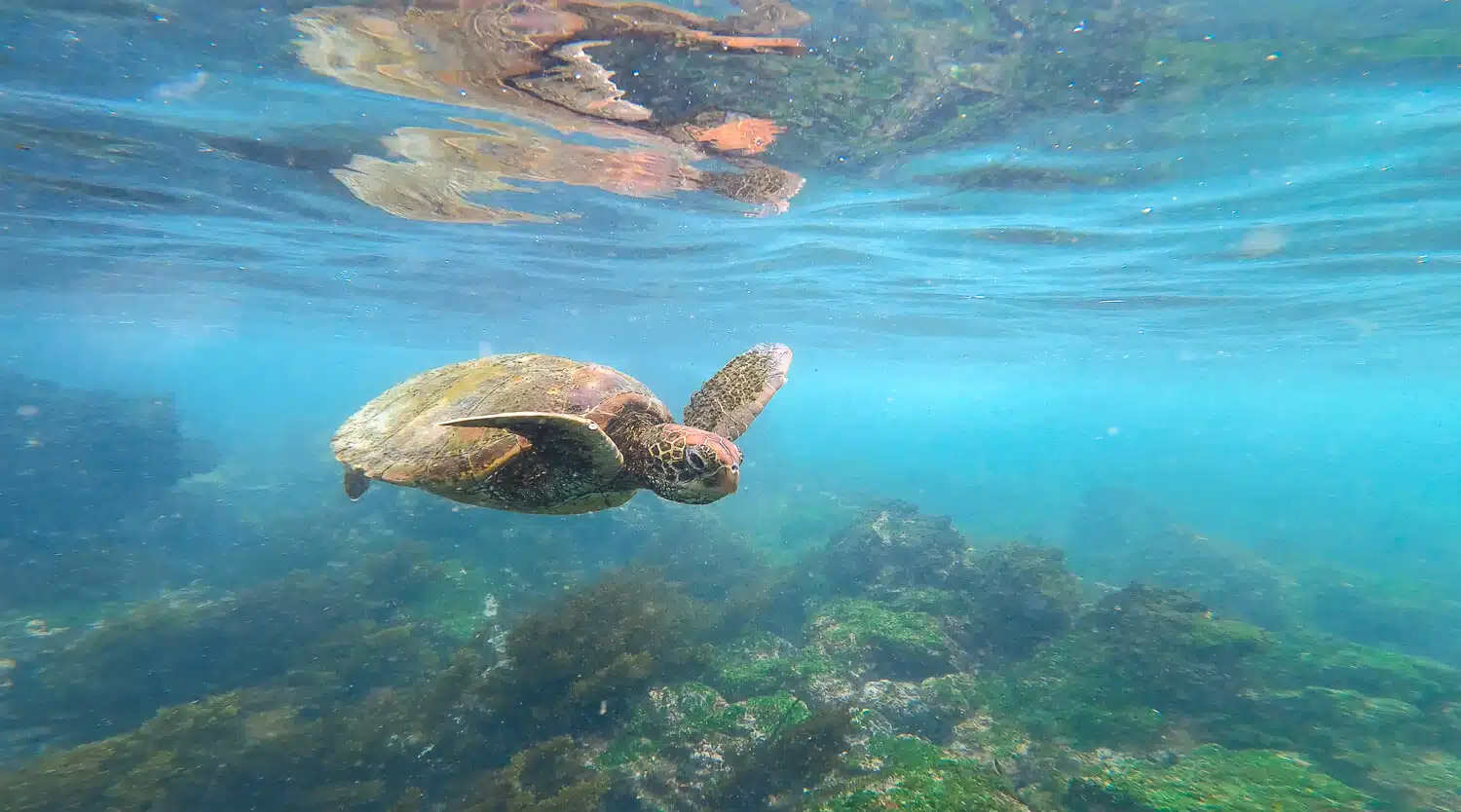
34. Dive in Plaza Islets
These are two of the many uninhabited islets in the Galapagos. They were formed by an uplift of the seabed giving it its flat but very unique shape. They are located on the northeastern side of Santa Cruz island. As you could snorkel, in the Plaza islets you can also dive.
Here the dives are usually between 15 and 18 meters in depth, you can see an eel garden and bigger pelagic species like rays, sharks, and green turtles. The dive is fit for all kinds of level as there isn’t usually strong currents on site. If you’re lucky you will also able to dive with playful sea lions.
To book this tour: Check the local company Macarron Scuba Diver’s website
35. Dive in Santa Fé Island
And to conclude the list a dive on Santa Fé island, one of the biggest islands in the Galápagos, that it’s located just 20 km away from Santa Cruz.
Santa Fé has three different dive sites, the Tip, the Arc, and the Cliff. The visibility is usually over 10 meters and it can get to 20-25 meters. Here the waters are of gorgeous turquoise color and are usually very calm, for which it is a good recommendation to do your diving certification here.
To book this tour: Check the local company Macarron Scuba Diver’s website.
Things To Do in Santa Cruz
Where to Stay
Santa Cruz Island in the Galapagos has a variety of accommodation options to choose from, and we’ve narrowed down the top three choices for you.
For the ultimate luxury getaway, Finch Bay Galapagos Hotel offers a range of amenities, including an outdoor swimming pool, fitness center, and hot tub. Hotel Acacia is a comfortable and serene environment to unwind in the heart of Puerto Ayora, with lush gardens, a shared lounge, and a terrace. And Suites Hermosas offers two fully furnished apartments with breathtaking views and fully equipped kitchens.
To learn more about these options and other accommodation choices, check out the full article:
All The Articles About The Galapagos
San Cristobal Island – The easternmost island of the Galapagos, the “Isla Bonita”
Santa Cruz Island – The island with the best tourism infrastructure.
Isabela Island – The most adventurous and less explored island of the main three.
Plan your next adventure with us!
Here are the links we use and recommend to plan your trip easily and safely. You won’t pay more, and you’ll help keep the blog running!
Adventures in Sri Lanka - The Ancient Ceylon
Explore The Galapagos Islands
Hiking in Switzerland & Italy
The Hidden Worlds of Ecuador
ABOUT ME
I’m João Petersen, an explorer at heart, travel leader, and the creator of The Portuguese Traveler. Adventure tourism has always been my passion, and my goal is to turn my blog into a go-to resource for outdoor enthusiasts. Over the past few years, I’ve dedicated myself to exploring remote destinations, breathtaking landscapes, and fascinating cultures, sharing my experiences through a mix of storytelling and photography.
SUBSCRIBE
Don’t Miss Out! Be the first to know when I share new adventures—sign up for The Portuguese Traveler newsletter!
MEMBER OF
RECENT POSTS
COMMUNITY
GUIDES
Need help planning? Get our interactive Ecuador and Galapagos guides with curated itineraries. Learn more…
RELATED POSTS
TRAVEL INSURANCE
Lost luggage, missed flights, or medical emergencies – can you afford the risk? For peace of mind, I always trust Heymondo Travel Insurance.
Get 5% off your insurance with my link!



